



















































































FULL CIRCLE Checking in on the Whistler 360 Health Collaborative 14 FITZ AND FURIOUS Council rushes to approve Vail Resorts lift—with less parking 15 WHO’S WHO? Anonymous Art Show returns 38 SLIDING HOW THE WHISTLER SLIDING CENTRE AND ITS STAFF CONTINUE TO BREATHE NEW LIFE INTO CANADIAN SLIDING SPORTS ISSUE 30.13 WWW.PIQUENEWSMAGAZINE.COM











Contains active ingredient amounts that always match their values on the label with virtually undetectable levels of environmental toxins, such as PCBs and heavy metals. The Oxidation values are well-below international standards ensuring great taste, no fishy burps, and biological efficacy. No genetically engineered GMO proteins and genes are present and it is Friend of the Sea (FOS) Certified. Fully stocked and on sale to suit you and your family’s needs.



















































Pharmacy & Wellness PRESCRIPTIONS WHILE YOU SHOP 8am to 6pm. 7 days a week Nesters Market 604.932.3545 Pharmacy 604.905.0429 nestersmarket.com WHISTLER 7019 Nesters Road (Just 1 km north of Whistler Village) SQUAMISH 710 1200 Hunter Place 2022
Nordic Naturals
Prices Effective At Whistler Nesters From: Thursday, March 30th to Wednesday, April 5th 2023. We reserve the right to limit quantities. Sale limited to stock on hand. Some items subject to Tax, plus deposit, recycling fee where applicable. Premium Ice Cream Selected Varieties 2 L CHAPMAN’S $4.99 EACH Cheese Selected Varieties 600 g & 690 g or Armstrong Shredded Cheese Selected Varieties 500 g ARMSTRONG $7.99 EACH Sparkling Water Beverages Selected Varieties 8 x 355 ml LA CROIX $4.99 EACH $3.99EACH SWEET Strawberries Grown in California or Mexico 1 lb Clamshell $11.99 /LB Prime Rib Roast or Standing Rib Roast 26.43/kg AAA CANADIAN BEEF
Renaissance on Ice
How the Whistler Sliding Centre and its staff continue to breathe new life into Canadian sport. - By David Song

14 FULL CIRCLE
The Whistler 360 Health Collaborative Society continues to hit milestones, as a new family physician begins accepting patients in the resort.
15 FITZ & FURIOUS Whistler’s mayor and council rushed through an approval of a new Whistler Blackcomb chairlift—while reducing parking requirements—at two special council meetings last week.
18
SEEING GREEN
Looking back on 90 years, 55 ski passes, and countless binding checks with Whistler’s “Jolly Green Giant” Casey Niewerth.
26 MAKE IT OFFICIAL
Major takeaways from a Village of Pemberton Official Community Plan open house won’t be presented until April, but there’s still time to weigh in.
34 PODIUM PERFORMANCE
Whistler snowboarder Amalia Pelchat continues to build her burgeoning career, with three medals at the Canada Winter Games.

38
WHO’S WHO?
The Anonymous Art Show is back to transform councillors, musicians, and casuals into bonafide artists.
COVER One of my favourite things about Whistler is how many communities within the community there are. I’d say many of us have doggedly suffered our way through all of the trials and tribulations involved with living here largely because of the people around us. - By Jon Parris

30 38 34 THIS WEEK IN PIQUE
4 MARCH 31, 2023

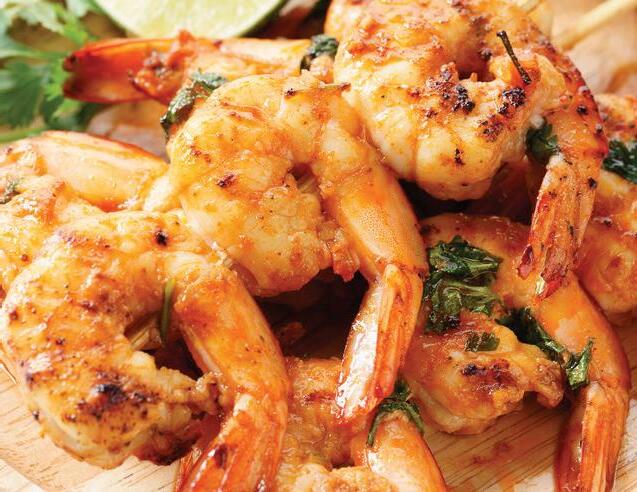



























































LOCATED IN WHISTLER MARKETPLACE VILLAGE NORTH • FRESHSTMARKET.COM * Promotional voucher must be presented at time of purchase. Excludes applicable taxes, bottle deposits, tobacco, eco-fees & gift cards. This voucher has no cash value so we cannot give cash back. One voucher per person, per household, per purchase, per day. promotional voucher valid for instore purchases only. This voucher is only validat Fresh St. Market in Whistler. 4330 Northlands Blvd Whistler, BC V8E 1C2 Expires april 6, 2023 scan for more details PRICES IN EFFECT FRIDAY, MARCH 31 - THURSDAY, APRIL 6 MARTELLI Bread Crumbs 227 g – 425 g 419 EA 299 each 699 each 699 each Stahlbush Island Farms Frozen Vegetables 283 g – 397 g Naked & Saucy Soy Free Sauce assorted 296 mL Krinos Organic Kalamata Olives or olive mix 375 mL CANADIAN GRAIN FED Fresh Whole Pork Tenderloin family pack 10.56/kg 479 LB 599 each Portofino Artisan Bread assorted 585 g – 700 g PARTICIPATING PRODUCT 199 lb Mexico Fresh Tomatoes on the vine 4.39/kg Grown using 99% less land, 99% less water, 99% less fertilizer, no pesticides, herbicides or fungicides! NOW AVAILABLE NEW UP VERTICAL FARMS Salad Mix 142 g 39 9 EA at Fresh St. Market get ready to hop & shop 225 per skewer Raw Prawn Skewers 8 prawns per skewer frozen or thawed for your convenience
Founding Publishers KATHY & BOB BARNETT
Publisher SARAH STROTHER - sstrother@wplpmedia.com
Editor BRADEN DUPUIS - bdupuis@piquenewsmagazine.com
Sales Manager SUSAN HUTCHINSON - shutchinson@wplpmedia.com
Production Manager AMIR SHAHRESTANI - ashahrestani@wplpmedia.com
Art Director JON PARRIS - jparris@wplpmedia.com
Advertising Representatives
TESSA SWEENEY - tsweeney@wplpmedia.com
GEORGIA BUTLER - gbutler@wplpmedia.com
Digital/Sales Coordinator SHANNON CALDWELL - scaldwell@wplpmedia.com
Production production@piquenewsmagazine.com
Features Editor BRANDON BARRETT - bbarrett@piquenewsmagazine.com
Arts Editor ALYSSA NOEL - arts@piquenewsmagazine.com
Social Media Editor MEGAN LALONDE - mlalonde@piquenewsmagazine.com
Reporters
BRANDON BARRETT - bbarrett@piquenewsmagazine.com
MEGAN LALONDE - mlalonde@piquenewsmagazine.com
ALYSSA NOEL arts@piquenewsmagazine.com
ROBERT WISLA - rwisla@piquenewsmagazine.com
DAVID SONG - sports@piquenewsmagazine.com
Classifieds and Reception mail@piquenewsmagazine.com

Office and Accounts Manager HEIDI RODE - hrode@wplpmedia.com
Contributors G.D. MAXWELL, GLENDA BARTOSH, LESLIE ANTHONY, ANDREW MITCHELL, ALISON TAYLOR, VINCE SHULEY
President, Whistler Publishing LP
SARAH STROTHER - sstrother@wplpmedia.com
08 OPENING REMARKS In a world bogged down by jargon, consultants, and studies, Whistler 360 is a breath of fresh air, writes editor Braden Dupuis.
10 LETTERS TO THE EDITOR This week’s letter writers have some thoughts about council’s rush job to approve the new Fitzsimmons Express chairlift.
13 PIQUE’N YER INTEREST Whistler is a town full of people who have chosen to leave their home for a life of risk and adventure—which can come at the expense of the relationships we hold dear.
62 MAXED OUT G.D. Maxwell brings you Part 2 of his three-part Whistler housing deep-dive.

29 THE OUTSIDER Good news, dirt demons—Vince Shuley is ready to call it: The great pandemic bike boom is officially over.
a member of the National Newsmedia Council, which is an independent organization established to deal with acceptable journalistic practices and ethical behaviour. If you have concerns about editorial content, please contact (edit@ piquenewsmagazine.com). If you are not satisfied with the response and wish to file a formal complaint, visit the web site at mediacouncil. ca or call toll-free 1-844-877-1163 for additional information. This organization replaces the BC Press council (and any mention of it).
ISSN #1206-2022

Subscriptions: $76.70/yr. within Canada, $136.60/yr. courier within Canada. $605.80/ yr. courier to USA. GST included. GST Reg. #R139517908. Canadian Publications Mail Product Sales Agreement #40016549.
36 FORK IN THE ROAD When it comes to Whistler kitchen fare, who’s there—men or women? Columnist Glenda Bartosh took a local survey to find out.
42 MUSEUM MUSINGS You never know what you’ll find scouring the Whistler Question archives— like reports of UFO sightings in the resort.

THIS WEEK IN PIQUE
Opinion & Columns
Adventure
& Arts
Environment &
Lifestyle
36 42 We acknowledge the support of the Government of Canada #202 -1390 ALPHA LAKE RD., FUNCTION JUNCTION, WHISTLER, B.C. V8E 0H9. PH: (604) 938-0202 FAX: (604) 938-0201 www.piquenewsmagazine.com Pique Newsmagazine (a publication of Whistler Publishing Limited Partnership, a division of Glacier Media) distributed to over 130 locations in Whistler and to over 200 locations from Vancouver to D’Arcy. The entire contents of Pique Newsmagazine are copyright 2023 by Pique Newsmagazine (a publication of WPLP, a division of Glacier Media). No portion may be reproduced in whole or in part by any means, including electronic retrieval systems, without the express written permission of the Publisher. In no event shall unsolicited material subject this publication to any claim or fees. Copyright in letters and other (unsolicited) materials submitted and accepted for publication remains with the author but the publisher and its licensees may freely reproduce them in print, electronic or other forms. Letters to the Editor must contain the author’s name, address and daytime telephone number. Maximum length is 250 words. We reserve the right to edit, condense or reject any contribution. Letters reflect the opinion of the writer and not that of Pique Newsmagazine Pique Newsmagazine is
6 MARCH 31, 2023
































Congratulations! Hiroaki Yano who recently won the 59th Annual Steveston Kendo Tournament UNLESS YOU would enjoy a POSITIVE & FUN work environment UNLESS YOU want to be part of a TEAM THAT CARES UNLESS YOU want an ABOVE INDUSTRY STANDARD WAGE* UNLESS YOU like big STAFF DISCOUNTS on groceries UNLESS YOU enjoy golfing & want to do it for FREE AT BIG SKY! UNLESS YOU want benefits: SKI PASS (PT or FT), extended health & benefits plan (FT), RRSP matching And if you WANT MORE, we offer STAFF ACCOMMODATION and opportunities for career advancement SOUND LIKE YOU? EMAIL KENT AT KDAWSON@CREEKSIDEMARKET.COM Starting Wage $16-20 With Experience $20-25 Full-Time Roles $22-27 WAGES : Assistant Manager/Manager Positions $28-35 &movingupfromthere! F ee di n g the Sp irit o f Wh i st ler Si n ce 198 8 100's of free dry & warm underground parking spots available. CREEKSIDE VILLAGE 604.938.9301 TRANSIT PASSES on sale instore @whistlercreeksidemarket /CreeksideMarket BEST CUSTOMER SERVICE 2020, 2021, 2022 Open Daily 7am-8pm Follow us on Facebook & Instagram for changes to our opening hours. MEXICAN GREEN ONIONS 75¢ EACH INDIAN LIFE TORTILLAS Original, Spinach, or Sundried Tomato & Basil $5 500G BONNE MAMAN JAMS 11 Flavours to Choose From $5 250ML SAPUTO SHREDDED CHEESE 6 Varieties to Choose From $6 170-320G PRODUCE DELI BAKERY GROCERY DAIRY/FROZEN WILD LING COD FILLETS $4 /100G MEAT/SEAFOOD MEXICAN HADEN MANGOES $2.50 EACH ORIGINAL CAKERIE CARROT CAKE $4 6 PACK QUE PASA ORGANIC TORTILLA CHIPS 6 Flavours to Choose From $4 350G BONTE DONAIR KIT $7 550G CERTIFIED ANGUS STRIPLOIN STEAKS AAA Candian Beef $20/LB 44.09/KG SAPUTO HALOUMI Great Meat Alternative! $5 160G INDIAN LIFE CHIPS Masala, Samosa, Palek or Naan $4 170G SPECIALS: MARCH 31-APRIL 6 GREAT FOR SHARING!
Three cheers for Whistler 360
IT IS OFTEN SAID that the wheels of government turn slowly.
Spend enough time in the trenches of municipal affairs, and you’ll see why.
If you’re fortunate enough to have avoided said trenches, here’s an all-too-common sample scenario to illustrate my point:
First, a problem is identified—a lack of housing, child-care spaces, or regional transit, for example.
Then, consultants are hired (if you’re a municipality that can afford it, like Whistler),
BY BRADEN DUPUIS
and a study is commissioned.
Some months later, council may hear recommendations stemming from said study.
A discussion is had, a course of action is chosen, and motions are forwarded and eventually passed—God help you if there’s a contentious disagreement at the council table, or the local NIMBYs effectively derail the process.

Depending on the complexity of the issue, it could take months or even years from the time a problem is identified to the time a municipal council starts taking solid steps to address it.
Whether or not the steps they take have any impact to address the problem at hand is another question entirely. If it doesn’t, cue more consultants and studies.
Take Whistler’s current housing woes, which appear to be worse than ever before in 2023 (remember the Mayor’s Task Force on Resident Housing launched back in 2016?); the ongoing lack of child-care spaces in town (what about the Whistler Child Care Planning Project, completed in 2020?); or regional transit,

that perennial favourite pet project and talking point of corridor officials (studies, plans, commissions… and still no regional transit).
All of this to say that, when it comes to local problem solving, it’s easy to become jaded.

Task forces, consultants, reports, jargon— at first, it’s exciting… look at all this stuff we plan on doing!—until you realize nothing is as easy as you would like it to be; that good ideas are one thing, and effective, efficient implementation another altogether.
Soon, you start to get the sense the people running things might not actually have a plan beyond the files currently crowding their desk. Maybe, just maybe, they’re just like the rest of us: mostly making it up as they go along, and giving it their very best.
I don’t intend this as a shot at our current leadership—more a comment on the machine itself, or maybe just the inescapable fact that
new nurse practitioner is due to start in June.
I know this news is a relief for many in our community.
For the uninitiated, Whistler 360 stems from a Primary Care Task Force formed in early 2019 to explore the impacts of Whistler’s family doctor shortage—exacerbated when longtime local practise Town Plaza Medical Clinic closed its doors last spring—and to investigate how access to primary care in the community could be improved.

Ultimately, after reviewing a variety of successful models in other B.C. communities, the task force came up with the vision for a non-profit, community-governed, team-based primary clinic that could provide longitudinal care to a greater number of patients, while simultaneously addressing many of the issues that deter doctors from pursuing careers in family practice (read more about its latest
when we launched the patient registry and made that first outbound call to attach a new patient,” said W360 board chair Carol Leacy.
“That was really a moment in time when we felt our hard work and the innovative way we have worked together has created real results in helping people get the care they need and health-care providers the support they need.”
But what to say about the progress made so far? How has the Whistler 360 team done so much in so little time?
“The magic or secret sauce of W360 is the complete culture shift from a physician- and nurse practitioner-led small business model of delivery to a community-led, and governed, non-profit society model. This shifts the focus from ‘surviving’ as a small business to thriving as a multidisciplinary team that is committed to, and accountable for, the wellness of the community,” said board member and local
we’re all just imperfect humans underneath all the boasting and jargon.
So, in light of my rather low expectations when it comes to solving local problems, I have to say I was blown away recently to hear that the Whistler 360 Health Collaborative (W360) is already connecting some Whistlerites with their new physician.



That’s right: thanks to W360, as of March 29, a whole bunch of locals now have a family doctor. Another new doctor will start attaching patients in the next few weeks, and a
efforts on page 14).
While the Whistler 360 board of directors contains just nine names, the work is being undertaken by a large, connected community with support from local stakeholders and organizations connected to health-care.


“We’ve had a lot of big milestones over the last 12 months, from achieving charitable status with Revenue Canada to receiving incredibly generous donations from the community to becoming operational with the Whistler Medical Clinic team in January. It all hit home, though,
physician Karin Kausky.
“Being part of a successful, committed, community group that has created a model of excellence, has reinvigorated and sparked joy in the entire team, both on the clinical and community side.”
The work is far from done, but it’s inspiring to see these results in our community—and to think about how Whistler’s efforts might benefit health-care in other B.C. communities in the long run.
- with files from Megan Lalonde ■

OPENING REMARKS
“Being part of a successful, committed, community group that has created a model of excellence, has reinvigorated and sparked joy in the entire team...”
8 MARCH 31, 2023 Escape the hustle and bustle of Whistler Village in this bright, 2 Bed/2 Bath townhouse with stunning views! Located in the popular Lynx complex, it features an open concept living area with high ceilings and a spacious renovated kitchen Enjoy a glass of wine from your private balcony with amazing views of Whistler/Blackcomb! Complex has new roof, ex terior paint, covered carpor t and plenty of storage This a great home for full-time living, as a weekend retreat or for nightly rentals Asking price $1,800,000 103-3201 Blueberr y Drive Tim Lischkoff, CPA, CA / tim@gskllp ca / 604-892-9100 www gskllp ca Specializing in accounting and tax services for corporations and their shareholders. Please contact me for an initial no-charge confidential consultation.
- KARIN KAUSKY
SALE UP TO 50% OFF
WINTTER SALE UP TO 50% OFF WINTER





SALE UP TO 50% OFF


WINTER SALE UP TO 50% OFF WINTER






VISIT OUR TWO LOCATIONS
HELLY HANSEN WESTIN RESORT


HELLY HANSEN WHISTLER VILLAGE




Whistler special council meeting
‘felt sneaky’
There seems to be some questionable political ethics going on when: an open public forum is announced just hours before it is to be held; when a controversial motion important to all who live here and pay taxes here is given first, second and third reading in one session; when a corporate improvement that was prepared to start this week is sidelined with new demands that could have been made months ago; and when the new proposals will not in any way solve the transportation problem at hand.
The special council meeting on Friday, March 24 felt sneaky, somewhat undemocratic, unfair to our largest partner, and directed to more studies when the problems are obvious enough, and the long-term solutions involve other levels of government (see related story on page 15).
Al Whitney // Whistler
Will strong revenues mean lower Whistler taxes?

Whistler is receiving $4,962,000 from the provincial government’s B.C. Growing Communities Fund. What a bonus for the
muni! And then this: Municipal revenues came in seven-per-cent higher than what was budgeted for 2022 at municipal hall. Well, I say, excellent. Great work by everyone who works for the muni. Thank you.
The cash infusion from the province is a one-off and was not in the Resort Municipality of Whistler (RMOW) budget. The RMOW overachieved revenues. To what extent may we expect to see our taxes reduced, or some kind of rebate made to taxpayers please?

Patrick Smyth // Whistler
Decision on parking should be driven by Whistler’s needs, not Vail Resorts’
This letter was sent to Whistler’s mayor and council and shared with Pique.
I have just watched the video of the March 24 special council meeting to authorize the expedited approval of the Zoning and Parking Amendment Bylaw for the Fitzsimmons Lift.
First, to [Councillor Cathy] Jewett’s regret that there was little public attendance or comments on the amendment, that is

simply because so very few people knew the meeting was happening. I see there is a follow-up meeting scheduled for 5 p.m. [Monday, March 27], however there has been no notification from the municipality, only word of mouth.
Had there been public engagement, you would have heard plenty.
[Coun. Ralph] Forsyth seemed to cover the concerns and discussions I and many of my friends share on the increasing overcrowding on the mountain and lack of accountability or transparency of Vail Resorts. Vail’s net income in fiscal 2022 was USD$347.9 million. Paying CDN$200,000 annually to further increase the company’s profitability is a rounding error. Since your proposed amendment calculates the muni parking revenue share to include the $200,000 Vail Resorts will certainly implement paid parking, at least to the extent it recoups
FOR THE RECORD
A story in the March 24 edition of Pique (“RMOW finishes year with strong Q4 results…”) incorrectly stated municipal revenues were 107 per cent above what was budgeted for 2022 at the end of Q4. In fact, revenues were at 107 per cent of what was budgeted—a seven-per-cent increase. Pique regrets the error. n

Short description of property listing - no more than 30 words. Git, tem am ea sant omnis alitio de sa es quis maios eate dolupti quid quatumendus, ut excerferiae ommostori cum quaecep tatibus.
2 BED I 2 BATH I 859 SQFT Whistler Creekside


LISA ASHCROFT Realtor lashcroft@sutton.com 604-905-8912

1 BED I 1 BATH I 537 SQFT Whistler Upper Village

Short description of property listing - no more than 30 words. Git, tem am ea sant omnis alitio de sa es quis maios eate dolupti quid quatumendus, ut excerferiae ommostori cum quaecep tatibus.
Short description of property listing - no more than 30 words. Git, tem am ea sant omnis alitio de sa es quis maios eate dolupti quid quatumendus, ut excerferiae ommostori cum quaecep tatibus.
Short description of property listing - no more than 30 words. Git, tem am ea sant omnis alitio de sa es quis maios eate dolupti quid quatumendus, ut excerferiae ommostori cum quaecep tatibus.
ocean/clubhouse/gym/pool Furry Creek
SHAUN GREENAWAY Personal Real Estate Corporation shaunggreenaway@gmail.com 604-902-3888


JENNIFER MORRISON Realtor jmorrison@sutton.com 604-935-4880

#203 - 1080 Millar Creek Road, Whistler British Columbia, V8E0S7
JENNIFER SALE
Personal Real Estate Corporation js@jennifersale.com 604-723-3525

LETTERS TO THE EDITOR
10 MARCH 31, 2023 LOCAL EXPERTS NATIONWIDE EXPOSURE suttonwestcoast.com $1,599,000 SOLD NEW PRICE 7558 Oberson Road 4 BED | 2 BATH • Country living only minutes from the Village • Well kept 4 bdrm on 0.66 of an acre • Beautiful Mt. Currie Views Pemberton 4 - 2028 Innsbruck Drive 1.5 BED | 1 BATH | 402 SQFT • Walking distance to Creekside Gondola, shops, restaurants • Enjoy for personal use, rental income or both!
Almost $50k current rental income in 2022 Creekside 223 - 4660 Blackcomb Way 0.5 BED | 1 BATH | 469 SQFT • Updated, Phase 1, Studio in Lost Lake Lodge • Walking distance to the village, trails, parks and more!
Unlimited owner use and short term rentals permitted Benchlands 1 Beach Drive 3 BED | 3 BATH | 2,880 SQFT • Beautiful executive end unit townhome • Coveted gated community: Oliver’s Landing • Bright 3 bed/loft/rec room, deck/garden • Steps to the
•
•
$795,000 $779,000 $1,538,000
WHISTLER · PEMBERTON · SQUAMISH
1 BED I 1 BATH I 517 SQFT Whistler Village
$1,099,000 $1,495,000 $349,000 $1,750,000 suttonwestcoast.com 15-2211 Marmot Place 309-4809 Spearhead Drive 228-4220 Gateway Drive 21 4890 Painted Cliff Road DAVID LEWIS PREC david@davidlewisliving.com 604-902-7270 DAVID NAGEL Realtor wolfofwhistler@gmail.com 604-906-0026 CATHERINE MCKAY Realtor cmckay@sutton.com 604-902-9447 MATTHEW CALLAGHAN PREC matt@whistlerrealestatelistings.com 604-935-3635
2 BED I 2 BATH I 958 SQFT Whistler Upper Village
the $200,000, and it will cost the company nothing. It merely transfers the liability to the residents and visitors to Whistler.

This is an opportunity to get some of what Whistler needs. The new Fitzsimmons lift is a sunk cost for Vail Resorts. If you insist on approving expansion, we need regional transport. Calculate the cost of regular Pemberton to Squamish transit and insist Vail Resorts covers a significant portion. That will
take the most cars off the road.
Calculate the cost of an expanded ER/ medical clinic, since much of the increased volume there is mountain-accident driven.
This is an important decision and should not be driven by Vail Resorts’ needs, but by Whistler’s. The community needs to be consulted.
Vail can wait.
Backcountry Update
AS OF TUESDAY, MARCH 28
March: in like a lion... out like a lion?
After another week of sun and warmer temperatures, a storm is forecasted to hit the Sea-to-Sky area Friday morning. The storm system is expected to peak on Saturday and fizzle out Sunday evening. All in, we could see upwards of 30 to 35 millimetres of precipitation. This precipitation will fall as snow at higher elevation and as rain at valley bottoms. The freezing level is projected to come down to about 1,200 metres.
Cooler temperatures and moderate to strong winds are forecasted for this weekend. The Sea to Sky will likely see wind speeds of about 25 to 30 km/hour with gusts up to 65 km/hour. The new snow will be sitting on a variety of surfaces. If you head into the backcountry this weekend, be aware the landscape has changed. Approach avalanche terrain with fresh eyes. At lower elevations, the new snow will land on a melt-freeze crust. Avalanches are less likely where a thick surface crust is present, but it will make for challenging travel conditions.
Susan Burford // Whistler ■



If you head to higher elevations, expect to find new snow sitting on a variety of surfaces, including sun crust and surface hoar. It will be important to investigate what type of surface is lurking beneath the new snow and how the new snow is bonding. A sun crust on sunny aspects or surface hoar on shady aspects will increase the reactivity of the new snow.
Cornices will grow and continue to threaten the large alpine slopes they dangle above.
If you are venturing into the mountains this weekend, here are a few things to keep in mind:
Be especially cautious as you enter windaffected terrain, and notice when the surface snow begins to stiffen and feel more “slabby.”



Pay attention to what’s above your head. Cornices falling on slopes may trigger large avalanches that a single rider would not trigger.

Be prepared to ratchet back your terrain choices if the storm intensifies sooner than expected.
Be sure to check the latest forecast at avalanche.ca and read up on how the snowpack and avalanche problems are developing before heading out. ■

CONDITIONS MAY VARY AND CAN CHANGE RAPIDLY Check for the most current conditions before heading out into the backcountry. Daily updates for the areas adjacent to Whistler Blackcomb are available at 604-938-7676, or surf to www.whistlerblackcomb.com/mountain-info/ snow-report#backcountry or go to www.avalanche.ca.
WHISTLER FIRE RESCUE SERVICE Paid On Call Firefighters Wanted
Enjoy a physical challenge?
Enjoy a team environment?

Enjoy serving your community?
This could be the opportunity for you
The Whistler Fire Rescue Service is now accepting applications for Paid On Call Firefighters. Interested applicants are also invited to attend a question and answer session being held at Fire Hall 1 4400 Village Gate Blvd on April 13 at 7 p.m
For information and applications please go to: www.whistler.ca/careers


Closing Date: April 18, 2023
www.whistler.ca/careers




LETTERS TO THE EDITOR Write to us! Letters to the editor must contain the writer’s name, address and a daytime telephone number. Maximum length is 450 words. Pique Newsmagazine reserves the right to edit, condense or refrain from publishing any contribution. Letters re ect the opinion of the writer and not that of Pique Newsmagazine GOT GOOD VIBES TO SHARE? Send them to goodnews@piquenewsmagazine.com
MARCH 31, 2023 11 Engel & Völkers Whistler 402 Town Plaza • 1 bdrm/1 bath, quiet side w views • Restaurants, shops outside your door • Walk to gondolas, Olympic Plaza • Secure underground parking, front desk • Rent nightly or monthly, GST not applicable $949,000 Register at marshallviner com to receive weekly real estate updates T 604 935 2287 E marshall@marshallviner com marshallviner com W H I S T L E R ’ S #1 RE/MAX AGENT 930 1 S TELLAR’S WAY The ultimate private view lot in Wh is tler. 1.8 9 Acres $2,395,000 Warner Real Estate Team
CALL FOR FUNDING APPLICATIONS


Applications are now being accepted for our April 1st, 2023 Spring Funding Deadline.
The Whistler Blackcomb Foundation is dedicated to providing financial support to community groups and charities whose activities provide benefit to residents of the Sea to Sky Corridor in the areas of health, human services, education, recreation, arts & culture and the environment. Special emphasis is placed on children, youth and family programs For more information, eligibility requirements and to complete an application, please visit our website at whistlerblackcombfoundation.com. Or contact Mei Madden, Executive Director at mmadden@whistlerblackcombfoundation com

CALLING ALL WHISTLER LANDLORDS




The benefits with having Hilton Whistler as your tenants are that you can rely on your home being properly cared for We have a designated captain for each house, we conduct regular cleaning and maintenance inspections, and strive to create a stress-free and long-term relationship with owners




INTERSTED TO RENT OUT YOUR PROPERTY?
PLEASE CONTACT Viktoria Lundkvist on 604 966 5031 or vlundkvist@hiltonwhistler com

12 MARCH 31 , 2023 Nick Davies, Whistler local and exper ienced family lawyer pr actising across BC and Yukon. Call at 604-602-9000 or visit www.macleanlaw.ca
Law is headquar tered in Vancouver
offices across Br itish Columbia Hilton Whistler Resort & Spa is currently
house
condo to
Staff Accommodation
Maclean
with
searching for a
or
be used as
J o s h C ra n e Whistler REALTOR® 6 0 4 9 0 2 6 1 0 6 | j o s h @ j o s h c ra n e c a w h i s t l e r r e a l e s t a t e m a r ke t c o m 120-4090 Whistler Way Whistler, B C V8E 1J3 3 1 0 (G 3 ) 4 6 5 3 B L AC KC O M B WAY Ho r s t m a n Ho u s e - B e n c h l a n d s 2 bed, 2 bath, 973 sqft – Best 1/4 share building in Whistler Horstman House offers owners 1 week each month which you can use personally or have the front desk rent it on your behalf Property is fully equipped has in-house management and is turn key Only a short 5 min walk to Lost Lake, Fairmont Chateau Whistler Golf Course and you can ski home Amenities include; Free shuttle, heated outdoor pool, gym hot tub bbq area ski & bike lockers and secured underground parking $359,000
Whistler ‘orphans’ and the long way home
THE POINT ARTIST-RUN Centre on Alta Lake has, for years now, hosted a fun event that has always warmed the cockles of my mushy heart: Orphans’ Thanksgiving.
Now, “orphans” is not meant here in the literal sense, of course. With so many Whistler locals far from their homes and loved ones, the Point had the savoir-faire of hosting an evening of live music, performance and, like

 BY BRANDON BARRETT
BY BRANDON BARRETT
any Thanksgiving, a seam-splitting feast of epic proportions.
The night isn’t likely to replace the experience of breaking bread with your actual flesh and blood (or those awkward dinner chats with the weird cousin, for that matter), but we have long been a town that puts immense value in the family we choose. In a community full of transplants, that’s important. Vital, even.
They say home is where the heart is, and with Whistlerites’ tendency for putting their heart and soul into everything they do, it’s no wonder we take such pride in our adopted home. That sense of pride is something I’ve always appreciated about our strange little mountain town—even if it means I sometimes bear the brunt of that fiery
passion in my job reporting on Whistler. As a journalist, listening to the frustrations of your community is a natural part of the job, and on those days when it can all feel a bit much, I try to remember that, nine times out of 10, the anger people feel at—pick your poison—the municipality or Vail Resorts or Pique itself is really just a reflection of the love so many folks have for this unparalleled place.
By and large, most of us have volunteered to be here, and we’ve sacrificed some of the usual trappings and comforts of a more “normal” community because of what we get back in return, so of course we care. In my opinion, the alternative—apathy—would be far worse.
All that is to say: against the odds, we Whistlerites have done a pretty damn good job of carving out a sense of home for ourselves in a tourism town that, at the end of the day, isn’t really designed for us.




But what’s it like to move in the other direction? You know, heading back, not to the home we chose, but the one we didn’t. It’s something I’ve been contemplating the past few days of a remote work week, as I’ve bounced around from one end of southern Ontario to the other, visiting family and old friends along the way.
I, like I’m sure is true for many Whistlerites, couldn’t wait to get out of dodge as soon as I graduated high school, desperate to experience something, anything, that was different from what my hometown could offer. (What up, Guelph!) I’m positive it’s the same yearning that
fed my appetite for adventure and travel over the years, and, ultimately, at least part of the reason why I decided to uproot my life to build a new one in Whistler.
I’ve always prided myself on my independence, another quality Whistlerites possess in spades, and when you’ve chosen a life for yourself that is geared more towards risk and adventure than familiarity and stability, I think it’s easy to spin a certain narrative that helps you come to terms with everything you’ve given up in the name of that pursuit.

that is interesting above all else, I’ve avoided watering the very roots meant to keep me planted firmly in the ground. I’m not going to chalk all that up to the lifestyle I’ve chosen— like most families, mine’s got enough baggage to fill a metropolitan airport—but I do think there is something inherent to the types of people attracted to places like Whistler and the life they provide that prevents us from going home again. Truly going home. And I don’t mean just physically.


As I get older, and my parents look just a little bit greyer every time I’m fortunate enough to see them, I’ve begun making these morbid little calculations in my head that no son or daughter wants to make, but inevitably will: If I make it home, say, once a year, how many more times will I get to see my mom and dad? Ten? Fifteen? Maybe 20, if I’m lucky?
This week, I got to spend a few peaceful nights at my mom’s house on the shores of Lake Erie, the longest time we’ve spent together in literally years, and I admitted something to her that wasn’t easy for me to say: it feels like she doesn’t truly know who I’ve become as an adult.
Her response came quicker than I expected: You’re absolutely right, I don’t.

For all the time I’ve spent chasing a life
Thankfully, along with this frightening realization comes with it another important epiphany that I imagine only gets stronger as we and the ones we love inch closer to death: all the bullshit doesn’t really matter. All those petty resentments and avoidant patterns we cling onto so dearly and treat so seriously will only weigh us down in the end.
So, if you’re like me, and you’ve managed to craft an existence that satisfies your utmost desires, then I salute you. Just don’t do it at the expense of the relationships that matter most, because that’s a level of regret no Whistler orphan should have to bear. OK, I think I’m gonna go hug my mom now. ■
W I L D E R N E S S R U N
PIQUE N’ YER INTEREST
MARCH 31, 2023 13 C A L L A G H A N V A L L E Y C A N A D I A N W I L D E R N E S S . C O M S N O W M O B I L E T O U R A C O M P A N Y W I T H H E A R T 604 938 1616 C A R L E T O N L O D G E / E A G L E L O D G E
I’ve begun making these morbid little calculations in my head...
Whistler 360 hits major milestone as new family physician begins accepting patients
THE NON-PROFIT OPENED THE DOORS TO ITS NEW MAIN STREET SATELLITE CLINIC ON MARCH 29
BY MEGAN LALONDE
ABOUT 200 WHISTLERITES are no longer without a primary care provider.
The first of those patients met their new family doctor, Dr. Joan Gatto, on Wednesday, March 29, the same day the Whistler 360 Health Collaborative Society officially opened the doors to its new satellite clinic on Main Street in Whistler Village.
On one hand, the new hire and new space have been a long time coming for a community that’s seen a handful of clinics shut down in just a few years. Still, “if you’d asked me in 2019 whether we would be doing this in 2023, I would have said you were crazy,” said Whistler 360 chair Carol Leacy.
The society stems from a Primary Care Task Force formed in 2019 to assess how access to primary care in Whistler could be improved. After reviewing a variety of successful models in other B.C. communities and incorporating as a society in 2021, Whistler 360 officially took over operations of the Whistler Medical Clinic— the resort’s last remaining family medicine practice—on Jan. 1, shifting the clinic to a nonprofit financial model.
“We didn’t think we’d get charitable status until around now, but the fact that we got it last July means that everything was able to happen that much more quickly,” Leacy explained.
“It’s so nice to actually be at the place where we’re able to bring on new patients,” she added. “All of this seems to be coming together just for that one main reason, which is more primary care providers and more patients having access.”
TWO MORE NEW PROVIDERS EXPECTED TO BEGIN ACCEPTING PATIENTS IN COMING MONTHS
More than 1,040 names have been added to Whistler 360’s patient registry since it opened in February, said Leacy, about 20 per cent of which have already been assigned to Gatto. Whistler 360’s administrative staff have been busy making outbound calls and scheduling introductory appointments for new patients as space becomes available, while the registry remains open to any local seeking a primary care provider who hasn’t already signed up. In 2022, Whistler 360 estimated that about half of the resort’s approximately 14,000 residents did not have a family physician, compared to the approximately one-fifth of B.C.’s five million residents who are without a primary care provider.
“A doctor takes on roughly 1,000 to 1,500 patients in their panel,” Leacy explained. “But it takes time to build to that. You kind of want to ease them in, so the people that start being attached [as patients] are able to make appointments.”
Leacy said one of the Whistler Medical Clinic’s long-term locums has decided to take on a full-time panel of patients beginning mid-April. The society also expects to add a nurse practitioner to its staff in June.
In addition to Whistler 360’s existing roster of six full-time-equivalent providers, plus new physician Gatto, “that’s going to give us roughly 50-per-cent more capacity than what we would have had going into 2023,” Leacy explained.
months ahead, all while creating a uniquely attractive opportunity for family doctors.
Whistler 360 handles all of the clinic’s administrative operations and overhead costs, effectively eliminating some of the factors that hinder doctors from pursuing careers in family practice in B.C. and allowing physicians to focus on patient care.
can use to book their own appointments, communicate with their care providers and obtain results, she explained.
MEET WHISTLER’S NEWEST FAMILY DOC
Gatto’s new gig stemmed from a chance meeting in a Whistler park. The Rainbow dog park, to be more specific.
Leacy attributes much of Whistler 360’s progress to the help several community partners: Vancouver Coastal Health managed to free up two new treatment rooms in the Whistler Health Care Centre, adjacent to the existing Whistler Medical Clinic, while funds from the Whistler Health Care Foundation’s Dr. Rob Burgess Primary Care Fund and the Whistler Blackcomb Foundation’s Founders Pass program helped cover renovation and hiring costs. One individual donor generously stepped up to cover the approximately $20,000 tab for outfitting the two new treatment rooms, Leacy explained.
Gatto was walking her two-year-old Sheltie when she struck up a chat with another dog owner. The conversation turned to work, and Gatto mentioned she was exploring opportunities in family medicine. “This lady told me about Whistler 360,” Gatto recalled.
“I didn’t want to do just locums and I didn’t want to be responsible for setting up my whole office again,” she said. “so Whistler 360 just sounded perfect.”
It was a natural fit for Gatto, who has been a part-time Whistler resident since 2000 and began practicing as a family physician in 1984—a career she’s “thoroughly enjoyed,” she said.
PHOTO SUBMITTED
But even taking into account the family physician Creekside Health added to its staff earlier this year, those new hires don’t quite close the gap: Whistler 360 estimates the resort needs about 15 full-time-equivalent primary care practitioners to fully serve its population. With that in mind, Leacy said Whistler 360 will continue its recruiting efforts and explore other strategies like expanding hours in the
She also offered major credit to local business owners Terri Ohyama and Norbert Doebelin, who purchased the Main Street property that previously housed Town Plaza Medical Clinic when the practice closed last year. Ohyama and Doebelin wanted to see the space continue being used for primary care, said Leacy. “We approached them and said, ‘look, we’re interested, but,’ and they made us an incredibly generous offer, basically just covering some of the costs,” she explained. “We would never have been able to do this without their generosity.”
Aside from its growing team of care providers and newly-renovated spaces, Whistler 360’s electronic medical record system is also in store for a heavy-duty upgrade in September, said Leacy. The changes will provide patients with an improved portal they

She grew up in the West Kooteneys and learned to ski at Red Mountain, before studying medicine at the University of British Columbia. Gatto went on to operate a family practice in Osooyos for several years, but has worked for the last 14 as a hospitalist treating acutely ill geriatric patients in Vancouver. She underwent “some re-training” from November to January in order to renew her full-service family practice license and return to the slightly-less-gruelling hours of family practice. She’ll be treating patients on Wednesdays, Thursdays and Fridays.
“It’s so similar to what I did in the hospital—I just looked after patients and all the other aspects were taken care of … It’s the same with Whistler 360,” she said. “They’re taking care of everything and I am just doing my job, seeing patients. Taking all of that stress away, it’s amazing what they have done.” n
‘WE WOULD NEVER HAVE BEEN ABLE TO DO THIS WITHOUT THEIR GENEROSITY’
OPEN SPACES Whistler 360’s family physician, Dr. Joan Gatto, welcomed her first patients to the non-profit’s newly-opened Main Street satellite clinic on March 29.
NEWS WHISTLER 14 MARCH 31, 2023
RMOW approves Fitzsimmons Express upgrade
THE MUNICIPALITY WILL RECEIVE $200,000 ANNUALLY UNTIL PAY PARKING IS INTRODUCED ON VAIL RESORTS-OWNED LOTS
BY ROBERT WISLA

ON MARCH 27, the Resort Municipality of Whistler’s (RMOW) mayor and council adopted parking bylaw amendments and a development permit at two hastily assembled special council meetings, ultimately paving the way for the expansion of Whistler Blackcomb’s (WB) Fitzsimmons Express chairlift without the need for additional parking.
Under the current bylaws for RR1 zoning at Whistler Village Base, 0.50 parking spaces are required per hourly rated capacity of all base lifts. As the Fitzsimmons Express upgrade will significantly increase capacity from 1,850 to 3,300 skiers per hour, Vail Resorts would be required to provide an additional 725 parking spaces, equivalent to about half of the space in the Creekside Parkade, for the upgrade to be approved.
At a special council meeting held Friday, March 24 with little advance public notice, RMOW CAO Virginia Cullen said that with climate change becoming a growing concern and to keep to the Big Moves Climate Action Strategy of moving beyond the car, the municipality needs to encourage alternative forms of transportation instead of building additional parking.
The amended parking bylaw comes with four conditions. The first condition is that Vail Resorts must create a parking study and share the data with the RMOW to improve understanding of parking utilization in Whistler, quantify how the parking is being used, and develop a database to inform the design of future solutions.
Second, the mountain operator must pay $200,000 annually in lieu of the additional required parking, working out to about $275 per spot, until pay parking is implemented on Vail Resorts-owned lots. Third, Vail must share revenue if or when the company decides to bring in pay parking on the lots/parkade it owns and direct that funding towards transit and active transportation improvements.
While Vail Resorts has not announced any plans to implement pay parking on its lots in Whistler, Cullen noted that the company recently brought in parking fees at several of its resorts in the U.S., such as Heavenly, Northstar, Kirkwood and Park City, and noticed a change in behaviour as more drivers have chosen alternative forms of transportation such as carpooling.
If Vail Resorts does try and bring in pay parking, it will have to be approved by the provincial government before it can be implemented, Cullen noted. The fourth and final condition is that Vail has to do public engagement with the community on paid parking models in fall 2023.
“There’s considerable uncertainty in terms of when and if this pay parking gets put in place. It’s not in the RMOW’s control. What we can see is a pattern at Vail Resorts for putting it in place because they are seeing



some very positive behavioural changes as it relates to traffic and congestion and people carpooling to the hill,” Cullen said.
Whistler’s mayor and council came out in near unanimous favour of the amended parking bylaw and development permit, with the sole voice of opposition coming from Councillor Ralph Forsyth, who encouraged rejecting the bylaw and permit, citing the need to solve current parking and congestion problems before approving more lift expansions.
“For the final time, guys, I encourage you to reject this. Everything that was just listed in there are all things that should be underway already,” Forsyth said at the March 24 meeting. “The only reason we’re sitting in this room at 4:30, almost 5:30 on a Friday, is because Park City rejected them for the same reasons we should. Figure out parking and figure out the highway congestion before you do a new lift.
“We’re not being treated as partners,” Forsyth added. “We have no access to any data to help us make any decisions on this. The province has come in to try and bully us into making this decision. And we heard resoundingly through the election that the community feels deeply that the balance between the community and resort is completely out of balance.”
DEVELOPMENT PERMIT APPROVED IN RAPID TIME


Mayor and council heard concerns from the public about the rushed approval process, as both the permit and bylaw amendments were approved at two online special council meetings in less than a week.
The quick turnaround was a result of Vail Resorts putting in its permit application on Jan. 6, leaving only three months for the RMOW to process the application, come up with plans to address the parking bylaw requirements and approve the development permit before the company planned to start construction at the end of March.

RMOW planner Mike Kirkegaard noted that, on average, a development permit application takes one and a half to 11 months to process, with the average time working out to five months. Due to the benefits of the lift upgrade project, staff prioritized the development permit. “I think we saw this as an important project, and we worked to address this project along with our other applications,” Kirkegaard said.
According to Cullen, the RMOW also had to remind Vail Resorts of the need for a permit four months after the company announced the lift upgrade.
“It was a step missed on Whistler Blackcomb’s end of things,” Cullen said. “It’s not the municipality’s responsibility to outline for every developer what their permit requirements are at the beginning of each project, but we did reach out once there was a formal announcement of the project in December as a curiosity reminder.” n

NEWS WHISTLER MARCH 31, 2023 15 7 0 5 5 N E S T E R S R O A D $ 5 , 7 9 9 , 0 0 0 C O M M E R C I A L O P P O R T U N I T Y B E D & B R E A K F A S T Z O N E D R E S I D E N C E 7 2 5 / 7 2 7 4 0 5 0 W H I S T L E R WAY Hi l t o n Ho t e l - W h i s t l e r Vi l l a g e 1 bed, 2 bath, 1146 sqft – Welcome to the Hilton Whistler Resort & Spa! Check in to your very own luxury 1 bed lock off suite, grab your skis and walk across to the base of Whistler Blackcomb Ski until your legs burn then head to the Umbrella Bar at the top of Whistler Mountain and order your beverage of choice Get back on the skis and take your last run to the base Kick those skis off and crawl home to your very own slice of parad ise Get in touch for terms and conditions of owning in the heart of Whistler Village $939,000 J o s h C ra n e Whistler REALTOR® 6 0 4 9 0 2 6 1 0 6 | j o s h @ j o s h c ra n e c a w h i s t l e r r e a l e s t a t e m a r ke t c o m 120-4090 Whistler Way Whistler, B C V8E 1J3
Construction begins on new Cheakamus rental building






ONCE COMPLETED, THE 78 EMPLOYEE HOUSING UNITS WILL TAKE A SIGNIFICANT BITE OUT OF THE WHISTLER HOUSING AUTHORITY RENTAL WAITLIST

 BY ROBERT WISLA
BY ROBERT WISLA
CONSTRUCTION OF 78 new employee housing units in Cheakamus Crossing Phase 2 took a significant step forward at the March 21 Resort Municipality of Whistler (RMOW) council meeting, as two rental buildings made their way through the permitting process.
A three-storey, 30-unit build at 1400 Mount Fee Rd. received a development permit at the meeting, allowing construction to begin. Meanwhile, council also gave first and second readings to zoning bylaw amendments on March 21 that will increase the height and the number of units in the adjacent building at 1450 Mount Fee Rd.
With the building permit approved for the 30-unit rental building, Whistler 2020 Development Corporation (WDC) chair and former Councillor Duane Jackson said construction will begin shortly and the plan is to start pouring concrete on April 5.



The bylaw amendments related to the second building will increase the number of units from 30 to 48, and add another storey. According to Jackson, the height adjustment makes economic sense, and is low-hanging fruit for a municipality wanting more units within a reasonable budget.
“It’s pretty simple. There’s economics of






scale, right? Because your foundation, roof, and all of that are fixed costs, and the cost to increase the elevator length is not very much, so it’s just low-hanging fruit,” Jackson said.
“Some people argue … shouldn’t it be more? Five or six storeys, that was suggested at the design panel … I think four storeys is an efficient design in terms of [working] within the building code. It’s quite efficient.”

The bylaw amendments will also change the parking requirements in the four-storey building, reducing the number of parking stalls from 56 to 52, working out to one stall per unit, with four stalls for visitor parking.
With the reduced parking, the WDC must create a parking management plan to ensure
that the reduction will not cause issues, per a report to council. Following the guidelines set by the new Green Building Policy, adopted last year, 20 per cent of all parking spaces must have a Level 2 electric vehicle charger.
Additionally, the bylaw proposes to allow for tandem parking on the private River Run lots in Lot 4, enabling homeowners who want to include auxiliary dwelling units to be able to meet their minimum parking requirements.



According to RMOW planner John Chapman, the overall planned density in Cheakamus Crossing Phase 2 will remain unchanged with the extra apartments. The additional units will shift from unused density currently allocated to Lots 1 and 6.
The current estimated construction cost for the two buildings is about $30 million, and WDC is actively looking for competitive bids to keep costs down. At the March 7 council meeting, the RMOW allocated $11 million from the WDC reserve, which was created by selling the River Run lots and employee ownership units completed earlier this year, to help fund the project.
But the RMOW will have to secure more capital to fully pay for the builds, Coun. Jeff Murl pointed out at that meeting.
“Ten million dollars will last a year on construction at the pace we want to maintain it,” Murl said. “We have a lot of challenges ahead to continue to find money and get creative with limited resources.”
The rental buildings’ price is about 15-per-cent higher than the first two buildings in Phase Two, as inflation and rising interest rates have increased the overall construction and debt costs in the last two years. Coun. Cathy Jewett noted that the increased cost is a downside of not building the units sooner.

“Speaking from someone that’s been looking into this sort of thing, it’s still really expensive to build these buildings,” Jewett said. “If we could have done it two years ago, we would have been much more fortunate with our financing, so it’s a difficult environment to be building in, that’s for sure.” n

NEWS WHISTLER
16 MARCH 31, 2023 $1,897,654 SANDRA BAYNHAM LUTZ 604 761 1273 3 1 5 SQFT: 1,452 • • • 673 3 C R A B A P P L E D R I V E , W H I ST L E R $939,000 JOSH CRANE 604 902 6106 1 2 SQFT: 1,145 • • • 72 5 72 7- 4 0 5 0 W H I ST L E R W A Y, W H I ST L E R $18,899,000 HANNAH GARCIA *PREC 604 966 8941 5 5 5 SQFT: 4,990 • • • • 3 2 9 6 A R C H I B A L D W A Y, W H I ST L E R ( 1 /2 ow n e r s h i p)
TOP DOWN An aerial rendering showing the layout of new proposed rental buildings in Cheakamus Crossing. IMAGE COURTESY OF THE RMOW
NOW SELLING / VISIT TODAY
AT HOME IN NATURE
3 BEDROOM TOWNHOMES IN SQUAMISH
PRICED FROM $ 1,068,000
Nestled between Whistler and Vancouver in beautiful Squamish, this striking collection of three bedroom townhomes is designed for those who love spending time in nature. Plus, most homes have the convenience of a side-by-side double car garage!



OPEN 12 - 5 PM DAILY
(except Fridays)
2060 Dowad Drive, Squamish highline@polyhomes.com
604.757.5550 polyhomes.com
Ninety years, 55 ski passes, and countless binding checks with Whistler’s ‘Jolly Green Giant’
CASEY NIEWERTH AND HIS FAMILY HAVE GROWN UP ALONGSIDE WHISTLER, MOVING INTO THEIR CABIN IN 1966, JUST WEEKS BEFORE THE MOUNTAIN OPENED FOR SKIING
 BY BRANDON BARRETT
BY BRANDON BARRETT
IF YOU WERE ONE OF the fortunate few who got to experience Whistler Mountain as an upstart ski resort back in the late ’60s, there’s a good chance you met Casey Niewerth, if only briefly.
In case you need your memory jogged—it has been close to 60 years, after all—he was the friendly Dutchman kneeling in a snow pit, caliper in hand, ready to check your bindings before you set off on the slopes.
“There was an unbelievable response,” Casey recalled. “There I am, sitting on my knees in a pit about two feet in the snow, with no gloves. I didn’t charge anything. I did that for well over three years. That was something that was advantageous for me as well as the resort, creating clientele.”
That is just one of the many examples from over the years of Casey’s resourcefulness. Perhaps better known locally as “Jolly Green Giant”—the intermediate run of the same name on Whistler Mountain first cut in 1968 was named after him—Casey was one of the

resort’s original season passholders, the first of 55 Whistler ski passes he added to his collection over the following decades.
“Not only that, but because Whistler

[Mountain] had just started and opened up in January 1966, that summer, I built my first family cabin, and we moved there in Christmas ’66. That’s where the action was,”


he said.
Casey and his family grew up alongside the resort, and it’s not an overstatement to say he played a role in shaping what Whistler would become.


“I would say his legacy is promoting skiing, for sure,” said Casey’s eldest son, Steve. “I think he helped put Whistler on the map through his connection to the sports shop. For us kids, he has really instilled in us a sense of customer service, and I think that’s from him starting the store with almost no money.”
With dreams of opening his own sports shop after not having enough schooling to do so in his native Holland, Casey arrived in Canada and worked a variety of jobs, including in the rough-and-tumble sawmills on Vancouver Island. In 1954, he landed in Vancouver, and was eventually introduced to the city’s one and only ski shop through a Norwegian friend, who showed him the tricks of the trade.
By 1956, with only a few hundred dollars in savings, Casey opened Skyline Sports, the North Shore’s first sporting goods retailer,
NEWS WHISTLER
GIANT LEGACY L to R: Judy, Casey, Steve and Greg Niewerth—a.k.a. Jolly Green Giant and The Three Little Sprouts—pictured in 1968, by their family cabin in Alta Vista.
PAGE 20 >> 18 MARCH 31, 2023
PHOTO SUBMITTED
SEE
S VAVA T E R G E S E N
O r n a m e n t a l C o o k e r
This exhibition is a co-production of the Audain Art Museum and Capture Photography Festival. Presenting Sponsor

y
A p r i l 1 - J u n e 1 1 , 2 0 2 3
Svava Tergesen, Granny Smith, Arctic Char (detail), 2022
stocking all manner of athletic gear— including, for our purposes, skis and ski boots. Nowhere near the internationally popular pastime it is today, Casey knew little about the sport then, but made up for that dearth of experience through exquisite customer service that, even for the era, went above and beyond the norm, a trait he would carry through to his time in Whistler.
Without the budget to fully stock his store, Casey convinced suppliers to lend him their sample products, meaning there was typically only one of each item in the shop. If a customer came in wanting, say, a pair of ski boots, Casey would take down their size and specifications, before hopping on a boat to Gastown while his wife held down the fort, purchasing the product in question, and rushing back to the North Shore.
“Basically, at that time, I didn’t have a pot to piss in or a window to throw it out of,” Casey said in his still-thick Dutch accent. “People would come in, and if they wanted a fishing reel to go salmon fishing on Bowen Island, I didn’t have what they wanted, but by the time they got home from work, I’d have it ready for them.”

It’s a family legacy that continues to this day, through Skyline Athletics, the Burnaby store, run by Casey’s nephew, specializing in wholesale athletic uniforms—not to mention sponsoring a lengthy list of youth sports teams and charitable causes, as Casey was also known to do.
SEEING GREEN


By 1968, Whistler was still the new kid on the ski block, counting only a few hundred residents. Like most small towns, most of those residents knew each other, and if they didn’t, they certainly knew your name.
In Casey’s case, if Whistlerites of the day weren’t familiar with the name his mother gave him, they likely were familiar with his nickname. He was, after all, hard to miss. Standing 6-3, Casey often sported a bright


Pember ton Visitor ’s Map
The official map of Tourism Pember ton will be published in May 2023 and will include maps, attractions and popular hiking destinations that Pember ton has to offer year-round.

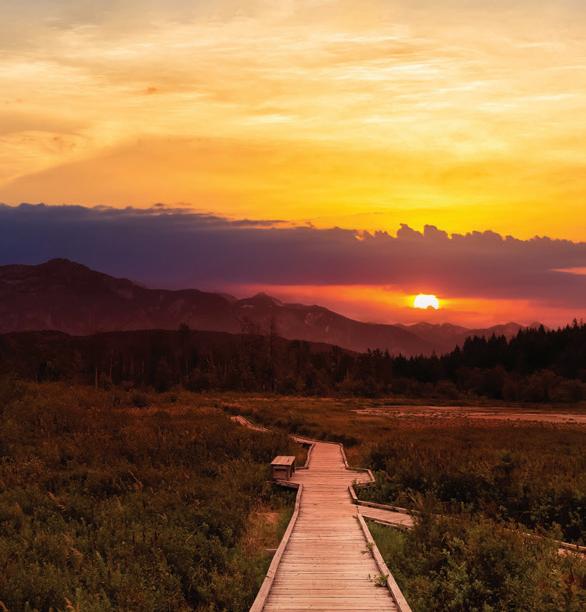
Book ing Deadline: Thursday, April 6, 2023






















father, so, naturally, the Niewerths became known as Jolly Green Giant and the Three Little Sprouts.
That same year, Casey and the kids were photographed in their matching outfits outside their Alta Vista cabin, a moment Steve had the idea to recreate in time for his dad’s birthday last winter.

“He turned 90 and it was my idea,” Steve said. “My sister went out and got all the green shells, and we all put them on and recreated it in front of the same A-frame cabin.”
Casey’s eldest son said he and his siblings wouldn’t be the people they are today without Whistler. The family has enjoyed dozens of ski seasons here, and spent summers in the local cabin long before Whistler was the fourseason resort it is now.


“We just had a blast up there. It was a real paradise,” said Steve. “It instilled in us a respect for nature, for sure, respect for time with the family. Being as athletic as we can and as outdoorsy as we can.
green shell jacket, partly by design as a colourful way to market his sports store. At the time, there was apparently a tailor in North Vancouver whose radio jingle, which featured the lyrics Jolly Green Giant, was all over the airwaves. Add to that the “green” theme at play on Whistler Mountain, where the original two-person Green Chair opened for the winter of ’68-69, and the name stuck. Casey’s kids, Judy, Steve and Greg, meanwhile, were often spotted in the same lime-green jacket as their
“All the kids have good work ethic because of him making sure we understood the value of work. He wasn’t a [strict disciplinarian] or anything; it was just a really fun thing to be around.”

As for Casey, who has watched Whistler evolve from a tiny ski-bum enclave to a massive tourism machine, he takes a moment to recognize his small part in it all. “I’m not totally responsible for putting Whistler on the map,” he said. “No, but I did my share along with a whole lot of people who came to Whistler from overseas. I did my share.” n
Pember ton

Visitor ’s Guide



















The official guide of Tourism Pember ton will be published May 19th, 2022 and will include editorial content on all four seasons, showcasing all that Pember ton has to offer year-round. Get a head-star t on marketing your business for this summer and the year ahead. Book ing Deadline: Wednesday, April 27th, 2023

NEWS WHISTLER
<< FROM PAGE 18
“We just had a blast up there.”
- STEVE NIEWERTH
GIANT LEGACY L to R: Judy, Casey, Steve and Greg Niewerth—a.k.a. Jolly Green Giant and The Three Little Sprouts—pictured in 2022, by their family cabin in Alta Vista.
20 MARCH 31, 2023 To book your adver tising space, call your sales rep: Pique Newsmagazine • 604.938.0202
PHOTO SUBMITTED
Y
N
When it comes to crime, Whistler has hit a ‘new normal’

RCMP’S ANNUAL CRIME STATS SHOW VIOLENT CRIME, SEX ASSAULTS AND DRUG CHARGES UP, WHILE PROPERTY CRIME AND VEHICLE INCIDENTS TRENDED THE OTHER DIRECTION
BY BRANDON BARRETT
WHISTLER RCMP presented its annual policing stats for 2022 last week, and they exemplified a resort that has seen its visitation rebound post-COVID, along with several new crime trends that can’t wholly be pegged to the community’s continued recovery.
“I’d say Whistler is definitely [in a] new normal. It’s not necessarily what it looked like pre-pandemic, in 2019, and we’re seeing that develop in the statistics,” said Sea to Sky RCMP operations commander, Staff Sgt. Sascha Banks, to mayor and council at the March 21 Committee of the Whole meeting.













Overall, violent crime was up five per cent, from 280 offences in 2021 to 301 last year. Last year’s total was also 13-per-cent higher than Whistler’s five-year average of 265.


Total assaults rose 17 per cent, from 142 offences to 166, while, within that same category, sexual assaults increased 18 per cent, from 28 to 33 offences.

“I would hedge a bet that the majority of this is occurring with the younger age group in sort of a nightclub-type, village [setting]. It’s that late-at-night-type mentality, whether the sexual assault could be an unwanted contact within the bar environment, or something that happens after the fact,” said Banks, adding that there needs to be more analysis done to better understand the trend.



“That is one of my goals with my Special Victims Unit investigator, to do a bit more of a deep dive into this.”



















Intimate partner violence was on the downswing last year, falling 11 per cent from 45 to 40 offences, while uttering threats (37 offences) and child pornography charges (six) largely stayed pat.




Drugs and/or alcohol were a factor in more than two-thirds of assault and domestic assault files last year, Banks said, and in 83 per cent of Whistler’s sexual assault offences.








Last year will of course be remembered for the brazen, daylight gang shooting that claimed two lives last July outside of the Sundial Hotel in Whistler Village. Banks said arrests were made within 40 minutes of the murders, and two men reportedly connected to the Brothers Keepers gang have been charged.

“On one our darkest days, the response from the RCMP was awesome. I was so proud of how quickly and effectively the response came,” said Councillor Jeff Murl during the meeting. A bigger spillover of gang activity from a growing Lower Mainland is one expected aspect of Whistler’s “new normal” for police. Banks, who formerly worked the gang beat in Surrey, said the detachment’s new Community Response Unit—a team of specially trained officers working with local
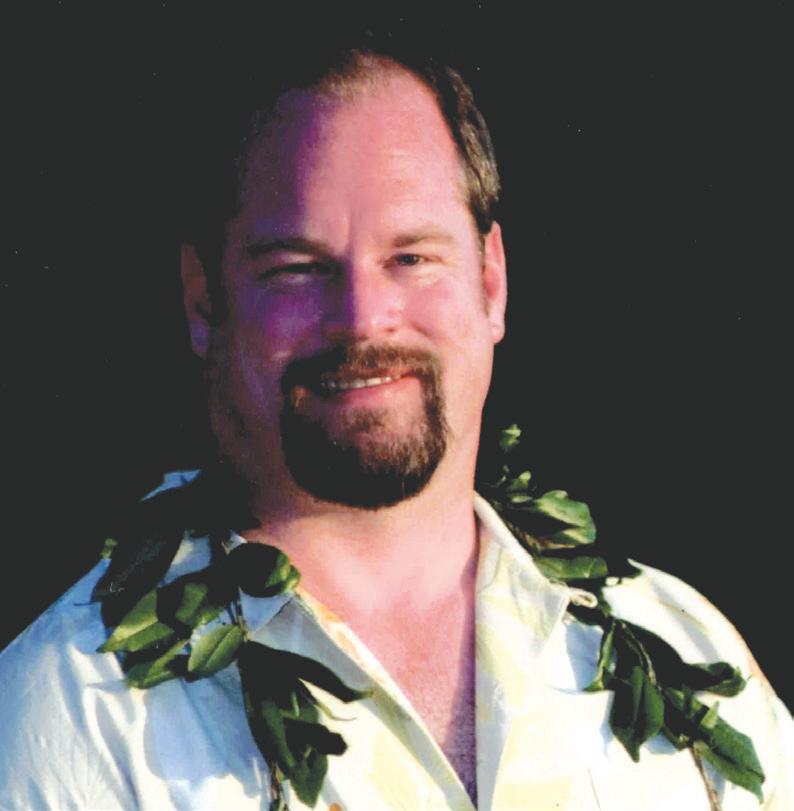
partners on specific areas of crime—as well as its inadmissible patron and bar watch program, which remains in development and has been for more than a year and a half, would help to keep known gang members out of Whistler establishments.
“I think almost every individual or every company that we’ve spoken to within the community is onboard with that,” she said. “It’s just how we effectively roll that program out, making sure that we are within the lines of not compromising the program, because somebody needs to have the skill set, they need to have the knowledge, they need to have the database to be able to roll that out properly.”
In property crime, offences rose 15 per cent, to 512, although 2022 was below the five-year average of 597. Virtually every property crime category highlighted was up last year, save for theft over $5,000, which dropped from six to five offences, and mischief over $5,000, which fell from four offences in 2021 to zero.

The highest percentage increases in property crime were auto theft, which rose 129 per cent, from seven to 16 offences; break-and-enters, which climbed 100 per cent, from 16 to 32 offences, and fraud, which rose 49 per cent, from 49 to 73 files. Bike theft, a persistent issue locally, stayed consistent across 2021 and ’22, at 30 and 32 offences, respectively, despite a busier year in terms of visitation.



“There’s no doubt over the last five years, throughout the Sea to Sky, and particularly in Whistler, we’ve really tackled bike theft, and it continues to be low,” Banks said. Local Mounties continue to emphasize road safety, which showed promising signs of improvement last year. There were no fatalities on Whistler’s roads in 2022, as in 2021, which Banks chalked up to officers’ proactive enforcement and a lack of extreme weather compared to past years. Vehicle collisions were on a downswing, dropping seven per cent, from 176 accidents in 2021 to 163, 22 per cent below the five-year average.
Impaired driving offences rose 10 per cent, from 161 to 177 offences, and three Whistler officers were awarded last year for the number of impaired drivers they took off the roads.
Another sign of Whistler’s continued rebound, drug offences skyrocketed 239 per cent last year, from 19 to 72, a total that police expect to drop significantly following B.C.’s recent decriminalization of up 2.5 grams of certain hard drugs.
Banks added that the local detachment, along with Vancouver Coastal Health and the municipal bylaw team, is planning to undertake an analysis of the impact of decriminalization on recreational drug use in Whistler.
Whistler RCMP hosted a community open house at the local library on March 29, after Pique’s press deadline. n
NEWS WHISTLER
MARCH 31, 2023 21
Busy March continues for Whistler Search and Rescue
CHALLENGES SECURING RESCUE HELICOPTERS LATE IN THE DAY MEANS SOME SEARCH SUBJECTS HAVE ENDURED UNCOMFORTABLE NIGHTS IN THE BACKCOUNTRY RECENTLY
BY MEGAN LALONDE
WHISTLER SEARCH and Rescue (WSAR) manager Brad Sills has a hot tip for anyone venturing into the Whistler backcountry this spring.




“More than ever, have extra clothing with you,” he said. “Down jackets and another base layer, some mitts. It’s not a lot of weight, just carry it with you.”
That’s not because Whistler is expecting to see temperatures plummet to unseasonablycold lows this April. (In fact, Whistler’s forecast calls for double-digit highs this weekend.) Even during mild spring conditions, if an unfortunate series of events has you waiting until daybreak for WSAR’s help, those extra layers would “make your night so much better,” he said.
Sills’ advice comes following a busy month for WSAR volunteers, and a couple of less-than-comfortable nights spent outdoors for search subjects.
Crews received four calls for assistance from Saturday, March 18 to Monday, March 27, beginning with two ski-tourers stuck on top of a cliff face in the Callaghan Valley that first Saturday. With WSAR unable to retrieve them by nightfall, the pair spent the
night outside before they were rescued the following morning.
On Tuesday, March 21, WSAR managed to pull two European visitors out of the Cake Hole after the pair found themselves lost on the south side of Whistler Mountain.
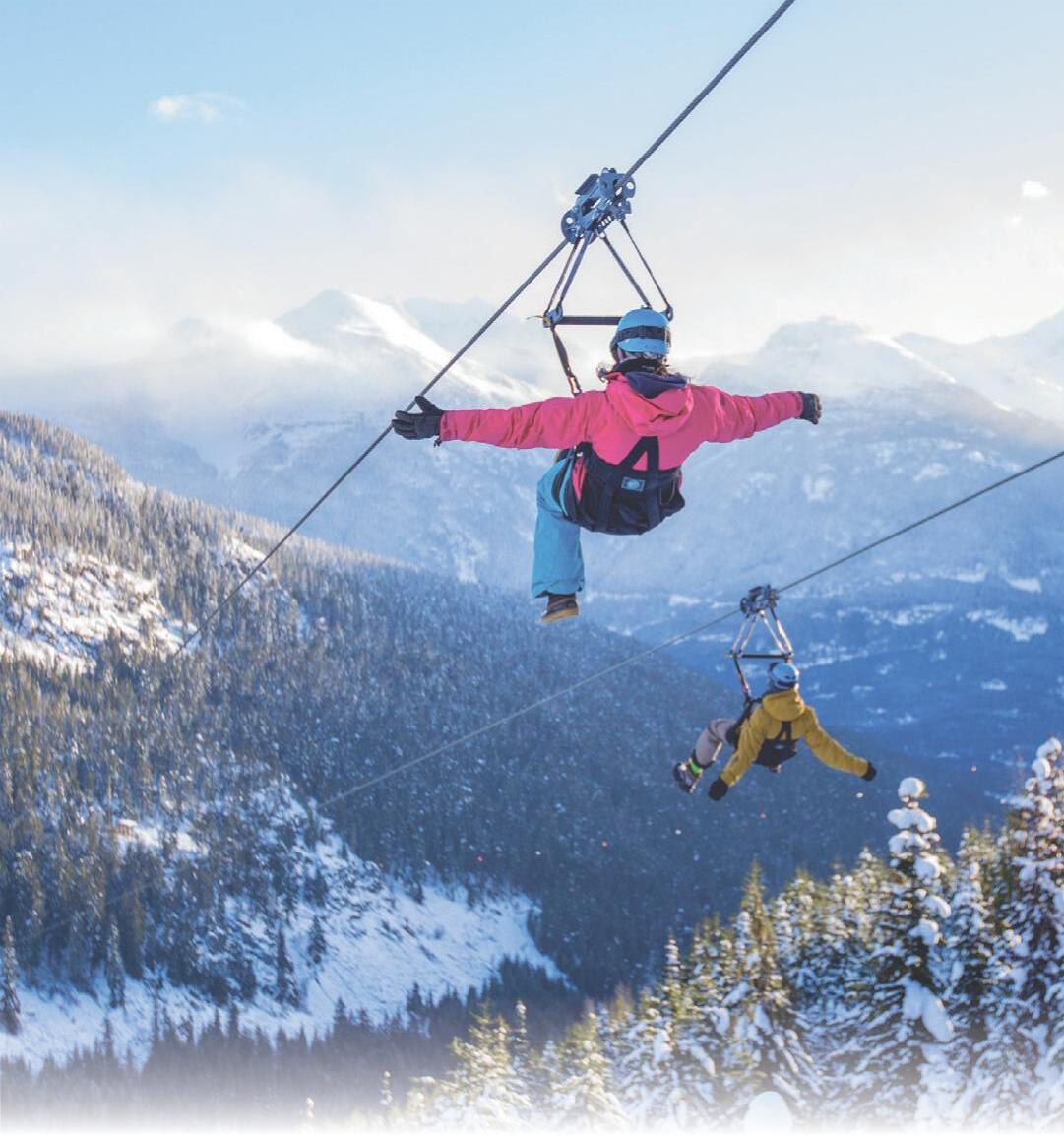

Then, on Saturday, an Ontario couple skiing Cowboy Ridge inadvertently skied parallel to Melody Creek on their way back down to the valley, missing the Singing Pass ski-out and suffering an equipment malfunction in the process. The pair ended up lost, deep in the trees. WSAR volunteers were in contact with the couple throughout the night, but weren’t able to retrieve the skiers by helicopter until the following morning. “They were excellent subjects,” said Sills. “They hung in there … They bedded down, made themselves somewhat comfortable. They had some extra equipment.”

The following day, Sunday, March 26, a group of four backcountry skiers heading down Whistler Mountain were met with a harsh reminder that ski tracks aren’t meant to be followed. The group had done just that, following in the couple’s tracks before realizing they were lost “slightly above,” where the pair found themselves stuck the previous night, said Sills.
“It’s the danger of people following tracks in terrain that they’re not completely familiar

with,” he added.

In the event of nighttime rescues, WSAR will often call on its counterparts from North Shore Rescue to respond with a night visionequipped Talon Helicopter, but Sills said the resource was unavailable while the equipment
on most helicopter pilots’ maximum flight and duty times, including limiting solo pilots to eight hours of flying time within a 24-hour period. The new limits are, in some cases, making it more challenging for WSAR crews to find available pilots towards the end of the day.
“It just raises the alarm bells about being prepared, because the likelihood that you are going to be spending the night out is increasing as we grapple with this new challenge,” said Sills.
For volunteers waiting to respond to those calls for assistance, “obviously your compassion is being tested to its fullest,” said Sills. Still, the decision to postpone a rescue is made carefully, by analyzing the urgency of the situation, he added.
was undergoing maintenance.
The lost party was fortunately able to bootpack back up to the Singing Pass trail and self-extricate at about 3 a.m., with the help of some guidance from WSAR and navigation apps.
A call-out to help a group of snowmobilers at Ring Lake after one member of the party dislocated their shoulder rounded out the busy 10-day period on Monday, March 27.
As Sills explained, the longer spring days have highlighted one unfortunate drawback for WSAR in the wake of new Canadian Aviation Regulations that went into effect on Dec. 12, 2022. The amended rules place further restrictions
“We have a metric that we use,” Sills explained. “We’re very fortunate at this time of year that, quite often, the atmosphere is inverted so the temperatures are actually warmer in the alpine than down below, and the overall temperatures are rarely much below zero.
“If you’ve been out ski-touring all day and you have good equipment on, you’re going to be fine ... Don’t get me wrong, you’re not going to be comfortable—there’s a difference—but you’re not in danger. You’re not going to lose any digits and you’re not going to die, you’re just going to really reflect on your next trip and what you’re going to bring.” n
NEWS WHISTLER
“It just raises the alarm bells about being prepared...”
22 MARCH 31, 2023
- BRAD SILLS
Motorists killed three bears on Highway 99 in 2022
ABOUT A DOZEN ANIMALS ARE KILLED ON SEA TO SKY HIGHWAY ANNUALLY, MOTI DATA SHOWS—BUT THE NUMBER IS LIKELY MUCH HIGHER
BY ROBERT WISLA

SINCE THE INVENTION of the automobile, collisions between people and wildlife have been a global problem. Seeing animals of every sort lying dead on the highway is a sight most drivers are all too familiar with, and the Sea to Sky Highway is no exception. According to new data released by the Ministry of Transportation and Infrastructure (MOTI), approximately a dozen animals are killed annually between Horseshoe Bay and Mount Currie.
“Over the past three years, an average of 10 animals a year have been reported to the ministry’s Wildlife Accident Reporting System as killed in collisions on Highway 99 between Horseshoe Bay and Pemberton, nine in 2020 and 2021 and 13 in 2022,” a MOTI spokesperson said in an email.
Two martens, four bears, six raccoons, 17 deer, and one unidentified animal made up the 31 critters officially listed as killed by motor vehicles. The data only paints a small picture of how many animals are lost annually on the province’s highways.
The Insurance Corporation of British Columbia (ICBC) reports that about 11,000 incidents involve wildlife across the province annually, with about 1,000 of those leading to injuries for the drivers and a little over half, 5,700, resulting in death for the animals. Between 80 and 85 per cent of the incidents involved deer.

The cost of collisions with wildlife is high for both the insurance provider and the public. In 2018, ICBC spent $41 million on claims related to injuries from wildlife incidents, while the Province of British Columbia lost an estimated $40 million from potential hunting revenue in 2007 and up to $390 million in possible wildlife viewing tourism revenue, according to the Wildlife Collision Prevention Program (WCCP).

WILDLIFE DEATHS UNDERREPORTED
WCCP finds that the number of animals killed is underreported, and that the number of animals lost yearly is significantly higher. Typically, ICBC only receives reports on collisions with wildlife if significant damage to a vehicle requires repairs. In numerous cases, animals can be struck by an automobile and manage to get away from the highway, only to later succumb to their injuries. The organization estimates that the number of animals killed is under-reported by 65 to 75 per cent, putting the actual number of wildlife killed on B.C. roads closer to 16,400 to 23,000 annually, which, if applied to the Sea to Sky, would result in an additional 124 animals lost over the last three years.
The wildlife collision data also leaves out incidents involving smaller animals like birds, amphibians, and reptiles, as the primary focus is on larger animals, such as deer and coyotes.
their Lower Mainland/Sea to Sky patient load.
“Over the last few years and from last year, about seven per cent of our patient loads, or birds, were suspected of being hit by cars, which was around 360 patients,” McQuillan said. “The number, of course, that are having automobile impacts would be much larger than that number, because many of them are not going to survive and are not going to be brought to us. So it’s good to keep in perspective that that number probably is a major under-representation of the number it’s happening to.”
McQuillan noted that automobile incidents occasionally lead to situations that require human assistance, such as in the case of orphaned wildlife.
“We get animals that are orphans because their parents have been hit by cars, so maybe they weren’t directly injured by a car, but I’m sure you’ve heard the stories of mum and dad taking her 10 or 12 ducklings across the highway and mum gets hit, and now there are 10 babies that need help.”
Drivers can help reduce collisions with wildlife by slowing down, being attentive to their surroundings, and knowing what to do if faced with a situation requiring action.
“I think that sometimes people aren’t aware that some basic changes in their driving habits can really benefit wildlife, like even just slowing down,” McQuillan said. “We talk about that quite often, but it’s something that can be huge, because having that extra bit of reaction time to anticipate what’s going to come out of the forest adjacent to the road and still have time to react can mean the difference between life and death for that animal.”

For more information on what to do if faced with wildlife on the roads, checkout wildlifecollisions.ca n


NEWS WHISTLER
BC Wildlife Rescue Association rescue support centre manager Jackie McQuillan finds that automobile incidents make up a significant amount of
WAY OF THE ROAD Provincial data shows how deadly the Sea to Sky Highway is for wildlife, but the numbers don’t paint the whole picture.
MARCH 31, 2023 23 P r e m i u m C a v i a r S e l e c t i o n F r e s h S e a f o o d + R a w B a r + S t e a k s E x t e n s i v e W i n e + C h a m p a g n e S e l e c t i o n P r i v a t e W i n e R o o m E L E V A T E D P A C I F I C N O R T H W E S T C U I S I N E E X P E R I E N C E A T W I L D B L U E 4 0 0 5 W H I S T L E R W A Y R E S E R V A T I O N S : 6 0 4 9 6 2 2 2 3 3 W I L D B L U E R E S T A U R A N T . C O M W H I S T L E R V I L L A G E N O W O P E N T U E S D A Y - S U N D A Y D I N N E R + B A R F R O M 5 P M
PHOTO BY EDB3_16 / GETTY IMAGES
‘My main goal, obviously, is to keep the community forest going’ CATCHING UP WITH THE CHEAKAMUS COMMUNITY FOREST’S NEW EXECUTIVE DIRECTOR, HEATHER BERESFORD
BY BRANDON BARRETT
IN MANY WAYS, the inherent dilemma— some might say, contradiction—at the heart of Whistler’s publicly managed forest, the Cheakamus Community Forest (CCF), is the same that the resort itself continues to grapple with.

Since its inception as a ski resort, Whistler has tried to strike a delicate balance of the ecological and the economic, teeter-tottering between the need to feed the chugging tourism engine that drives this town and the need to preserve the vital natural assets that attract legions of visitors here in the first place.

The CCF, meanwhile, is a 33,000-hectare forest, co-managed by the Resort Municipality of Whistler (RMOW), and the Lil’wat and Squamish Nations, that was one of the first forest operations in B.C. to employ a holistic, ecosystem-based management (EBM) approach that is designed to consider all aspects of ecosystem health and ensure its long-term viability. But, of course, the CCF is also a business, and the commercial logging that takes place there, as well as the jobs it provides, are important, and often misunderstood, aspects of that viability.
It’s a dynamic the CCF’s new executive director and former RMOW environmental
stewardship manager Heather Beresford knows full well.
“For me, my main goal, obviously, to keep the community forest going,” Beresford, who assumed the role in October, told Pique in an interview this month. “It’s a business. We have to be able to harvest enough to keep the business going. Because the alternative, in my mind, is way worse.”
That alternative would see the CCF revert from a publicly managed forest to a provincially managed one, which would inevitably result in more logging, not less, Beresford said.
“If we lose the community forest license … then all of the wood in this area goes on the auction block, and the [Ecosystem Based Management] plan, all that is just out the window,” she said. “It will [fall under] the province’s Forest & Range Practices Act, and their model is to cut all the old growth as fast as you can, get it replanted and cut the second growth. So, we are between a rock and a hard place.”
WILL THE CCF HARVEST OLD GROWTH AGAIN?
For years now, the CCF has had its annual allowable cut set by the province at 21,000 cubic metres, a total the forest’s partners have consistently struggled to meet, due in
part to a dearth of commercially harvestable old growth. (It’s worth noting that, generally speaking, the amount of timber harvested on public lands across B.C. regularly falls below the set annual cut.)
Even before protests at Fairy Creek put an international spotlight on the issue, old-growth logging in the CCF was a contentious issue locally. In June 2021, the board decided to defer old-growth logging for the remainder of the year, a moratorium that has continued until today. Local ecologists, conservationists, and the wider public, meanwhile, have called for that temporary ban to become a permanent one. So, does the CCF’s new director think Whistler’s public forest will ever see another old-growth tree—defined in B.C. as 250 years or older—logged commercially?
Well, it’s complicated.
“With the historical logging that has happened in the past, they went in and they just really took out all the stuff that was available in the lower areas. So, we’ve got this sort of 20-year gap where the trees are not big enough to harvest yet. And that’s why it’s kind of forcing us to go into those older-growth areas,” Beresford explained. “I think what we’re going to see is minimal. We want to harvest as little old growth as possible. I’m not the board; they’re going to make that final decision. But the scenarios that I’m seeing come out look like we’re going to have
to probably harvest some smaller portion of old growth, and try to do the selective harvesting in the second-growth areas as much as possible. We’re just fine-tuning those models right now.”
Of course, emphasizing second-growth harvest eliminates future old growth, a vital component of a forest’s health and an important recreational draw. Beresford said the CCF is factoring that into its modelling, with plans to focus on harvesting younger trees while preserving mature second growth.
“We’re trying to leave that older mature stuff, between 150 to 250 years old, so we’re not cutting into all the mature forest that’s going to graduate into old growth first,” she said. “We’re trying to even out the lumps. If you looked at a bar graph of the age demographic of the forest, it is like nothing, nothing, nothing, and then it gets quite lumpy. Because the original guys that were up here 100 years ago, they were doing it by hand. They couldn’t do that mass removal that happened starting in the ’60s, ’70s and ’80s. So, we can play a bit there. We’re definitely cognizant of that issue.”
INDIGENOUS RIGHTS
The CCF also provides needed employment to its partners, particularly for the Lil’wat Nation, which has in recent years trained several members as forest technicians and on whose unceded traditional lands the CCF
NEWS WHISTLER
24 MARCH 31, 2023 NEW WINTER WHISTLER MAGAZINE IS OUT! Get your new edition in hotel rooms and select locations around Whistler. WHISTLER’S PREMIER VISITOR MAGAZINE SINCE 1980 /whistlermagazine
sits. Beresford believes the continued push in B.C. from Indigenous communities to claim greater control of their lands and forests will signal a sea-change in how forests—the CCF included—are managed.
“If you look at the BC Declaration on the Rights of Indigenous People, I think that’s something that’s really going to play a key role in the future,” she said. “What does that look like? What do our forestry act and practices look like with Indigenous Nations having more of a say in it? I think that’s probably going to be the biggest thing that will influence what happens with forestry.”
CARBON CREDITS






Without the same level of available commercial timber as in the past, the CCF board has had to look at other ways to diversify its revenue. One stream that Beresford plans to grow as director is the CCF’s carbon credit program, which she estimated brought in just under $70,000 last year, the lion’s share of the forest’s revenue, with little commercial harvesting taking place. (In a more typical year, however, carbon sales would make up only a fraction of the CCF’s revenue. The most recent financial report posted on the CCF’s website showed the forest brought in roughly $2.5 million in revenue in 2020, for instance.)
While controversial in certain circles for effectively allowing large corporations to “greenwash” their emissions without having to take a hard a look at their own operations, Beresford said the CCF’s carbon sequestration initiative will target primarily Sea to Sky

and tourism-based companies and will have specific criteria attached to ensure purchasers have already taken concrete steps to reduce their carbon footprint.
“Certainly, there have been problems with carbon projects around the world. Some of them have been just outright B.S.,” she said, adding that there are two large credit sales currently being finalized. “We’re not just going to take your money. We want to see how


you’ve done other things that are reducing your operational carbon footprint before we’re just going to let you buy your way out of that.”




WILDFIRE MANAGEMENT

Managing the risk of wildfire is another important element of the CCF’s operations, but opinions have differed locally on the best approach to take. The debate centres around
a question that has divided researchers and ecologists: is it best to cut dedicated fuel breaks, or to largely leave the forest as is to regenerate post-fire?
“I’m in the middle on it,” said Beresford. “There just isn’t the research done here in the coastal forests, because we haven’t been as concerned about wildfire until the last five years. There’s been lots of work done in the Interior on those drier forests, but not on the coast. So, we don’t really know.”
Saying she often felt like “the monkey in the middle” on this debate in her former role at the RMOW, Beresford said the municipality will undergo its own research this year to come to a better understanding on the best approach to managing wildfire.
“We’ve got, I think, four or five locations that haven’t been touched. They’ll be studying wind and soil moisture and all that kind of stuff … and then looking at the areas we have treated to see what’s the difference and then keep this going over time,” she added.

But Beresford wants to be clear: managing the threat of wildfire must be a collective, community effort.
“The community really needs to dig deep and FireSmart their own properties,” she urged. “Don’t have a false sense of security that that forest thinning [in the CCF] is going to save this community. We have to take individual responsibility and make sure our homes are as FireSmart as possible.”
The CCF will host an open house on its three- and five-year plans sometime in May, with the exact date and location to be confirmed. Learn more at cheakamuscommunityforest.com. n


NEWS WHISTLER
THICK AND THIN Wildfire fuel thinning carried out in the summer of 2019 in the Cheakamus Community Forest.
MARCH 31, 2023 25 Yoga Teacher Training Whistler April 17 - 30 www.katecovello.com Online Yoga Classes EVERY Tuesday/Thursday 5:30AM HOT TUB SALE!! mountainsedgespas.ca (604) 966-8305 EQUINOX SPAS Four seats plus lounge seat $10,000.00 + TAX 30 Strategically placed hydrotherapy jets Seven seat lounger tub $13,500.00 + TAX 44 strategically placed hydrotherapy jets FREE DELIVERY TO WHISTLER We’ve got you covered. Pick up the latest issue of your favourite read in Whistler.
FILE PHOTO BY CLARE OGILVIE
Village of Pemberton hosts Community Open House to gather input for OCP Review

MAJOR TAKEAWAYS FROM THE OPEN HOUSE WILL BE PRESENTED IN APRIL
BY DAVID SONG
ON MARCH 6, the Village of Pemberton (VOP) hosted a Community Open House as part of Phase 1 of its Official Community Plan (OCP) Review. The event sought community input regarding issues that will shape the future of Pemberton to 2050.
The main takeaways from the Open House are being compiled into a “What We Heard” report. The report will be presented in April, and will include all the details gathered from various engagement activities to date.
“The Community Open House was extremely well-attended, with over 160 community members coming by to provide their input,” said Mayor Mike Richman in a press release. “This kind of engagement is a huge success that will guarantee a strong outcome for this OCP Review.”
At the gathering, VOP staff and consultants gave a short presentation to inform audience members about what an OCP is and how it affects Village bylaws, policies, and projects over its lifetime. Display boards at the Open House briefed visitors on Pemberton’s community values, character, and how the VOP can advance the path of
reconciliation.
Following the presentation, residents took part in smaller roundtable discussions about four main topics: reconciliation, housing, environmental sustainability and resilience, and the local economy.
“The roundtable discussions offered a cross-section of residents a chance to interact and consider how the Village can
opportunities for the community to get involved with the OCP Review since January.
Kitchen Table Discussion Packages have been available from the Village Office and the Pemberton and District Community Centre, designed for residents to host their own OCP discussion with family and friends. More than 100 residents have participated in these conversations to date.
of today] will be young adults when the OCP comes to fruition,” Brown said. “So, it’s very important that they feel included and that they have their say.
“We’re looking forward to speaking with the high school students as well, because they’re the ones that are about to graduate, enter the workforce and maybe look for their own housing. They’re going to have some really unique perspectives on how Pemberton works for them, and the areas we can improve upon.”
Phase 1 of the OCP Review continues until June, at which point a first draft of a vision, guiding principles, goals and objectives will be written.
address these important topics,” said planner Colin Brown in the release. “We developed Discussion Guides that provide background information on each of these topics and suggestions of things to think about. These are available on the project website.”
The OCP Review process is currently in Phase 1, which focuses on gathering information from the community and bringing together all relevant data and other plans, such as the Community Climate Action Plan. Concurrent to the OCP Review, the VOP is updating its Housing Needs Report that is due in June 2023.
VOP staff have offered several
Furthermore, staff and elected representatives have been engaging with local children and youth at Signal Hill Elementary and École La Vallée, with a visit to Pemberton Secondary School planned for some time after March break. Students have been encouraged to express what they love about their home and what they think could make Pemberton “even more fun.”
Although some youths may not yet recognize the importance of the OCP Review, Brown and his colleagues think it is vital for their perspectives to be acknowledged.
“The vision for this OCP is for the next five, 10 or even 20 years … so [the children
Pembertonians will have a chance to submit feedback about early OCP drafts to ensure that they have been heard correctly. Phase Two would involve further versions of the new OCP and engagement activities that will occur at popular local summer events.
“The Community Open House created space for many meaningful and constructive conversations, and we’re looking forward to hearing the details of these in the ‘What We Heard’ report,” said Richman. “The Village would like to extend its sincere thanks to the community for the tremendous turnout and for engaging in this process.”
The VOP welcomes all feedback and community inputs during this process. For more information about the OCP Review process, visit haveyoursay.pemberton.ca/ ocpreview or contact Brown at cbrown@ pemberton.ca. n
REVIEW CREW Phase 1 of Pemberton’s OCP Review continues until June.
PHOTO COURTESY OF THE VILLAGE OF PEMBERTON
“This kind of engagement is a huge success that will guarantee a strong outcome for this OCP Review.”
NEWS PEMBERTON 26 MARCH 31, 2023
- MIKE RICHMAN
Pemberton projects small operating budget surplus in 2023
DECLINING REVENUE, GROWING INFLATION AND HIGH STAFF TURNOVER ARE CHALLENGES IN THIS YEAR’S BUDGET
BY ROBERT WISLA

WITH GROWING INFLATION, rising costs, and a booming population, the Village of Pemberton’s (VOP) annual operating budget aims to address high staff turnover and declining revenue while striving to build reserves for the future.

At the VOP’s March 28 Committee of the Whole (COW) meeting, mayor and council received a presentation by manager of finance Thomas Sikora that doubled as council’s first opportunity to review the 2023 operating budget.
“We already looked at the capital budget. We’ve looked at the strategic direction, and I could translate those into a robust operating budget that follows some of the mandates around service and cost efficiency and accountability,” Sikora said in a presentation to council.
The key overlapping themes of the budget are organizational health, smart growth, emergency preparedness, the environment, and service excellence, with reconciliation, regional transit and flood mitigation among the other top priorities for the VOP.
The operating budget is currently in a deficit of $159,936; however, a surplus of $275,529 will carry over from the previous year, resulting in an overall net surplus of $21,094. The presented budget does not include tax increases, which council will discuss at the next COW meeting.
The VOP expects application and building permit revenue to decrease in 2023 compared to previous years.
“It’s a challenging forecast, but as we look at some of the views of where the markets are going and what we’re hearing from developers in the community, the view in developing this budget is that we are not likely to see as strong of a year as we’ve seen in the past, and year to date, so we took a very conservative view when forecasting revenue,” Sikora said.
Sikora noted that the VOP’s costs had significantly jumped across the board due to rising inflation, citing the British Columbia Consumer Price Index (CPI), which measures changes in prices as experienced by the average consumer.
Adjusted over the year, the CPI rose by 6.6 per cent compared to Dec. 2021. Inflation meant double-digit cost increases for the village, resulting in officials challenging, rejecting and retendering bids or deferring construction activity due to rising costs.
Labour and staff recruitment is another focus of the budget. Over the last two years, the VOP has experienced incredibly high staff turnover, at a rate of 25 per cent in 2022 and 35 per cent in 2021.
“A large theme this year, and a challenge we’ve seen over the last number of years that we’re trying to address in this year’s budget, is the turnover and staffing challenges that we’ve seen,” Sikora said.
WWW.WHISTLERLAWYER.CA
adam@whistlerlawyer.ca | 604.905.5180


“We’ve seen a lot of expenses to support finding new people, and through initiatives in this budget, we’re very hopeful to see our stability measured through pension and growth of people in this organization.”
The VOP aims to bring in a variety of initiatives in 2023 to address these challenges, such as increasing staff compensation annually to stay competitive (four per cent in 2023) and investments in training, development and succession planning.
But Pemberton’s growth may soon pose a different financial strain.
Under provincial legislation, when a municipality hits 5,000 people, it must pay 70 per cent of its policing budget, resulting in hundreds of thousands in additional costs for the village. In 2023, the VOP police budget stands at $288,447. Pemberton’s population, according to the 2021 Census, was 3,407.
Councillor Ted Craddock voiced concern about the amount of capital in the policing reserve, saying he wanted to see the municipality better prepare for the transition with moderate tax increases over several years so that future councils are ready for the change.
“I’ve brought it up before, and I hate to keep hitting on reserves for the RCMP, and I know this year it’s $288,000, but in five or seven years, it may be [over $1 million]. And I want to get an idea of how we’re going to get there,” Craddock said.
“My point is, I would rather fill up the reserve by taxation going forward every year for the next number of years so that when we hit this … limit, we’ve got the money all ready and can be sure that will cover it,” he added.
According to Sikora, in conversations between the RCMP and VOP staff, the current view is that Pemberton will not reach the 5,000 population threshold in the next five years. He pointed out the Union of BC Municipalities (UBCM) is working on the issue, but will consider Craddock’s concern as the VOP works on taxation implications for the coming years. n
SPECIALTY HONEYS
pure local honeys • liquid honey

creamed honey •raw honey

infused honey • honeycomb
honey sticks
HEALTH & NUTRITION
bee pollen • royal jelly
propolis • supplements
oral health
HAIR & BODY CARE PRODUCTS
soaps • skin creams
hair care • lip balms PLUS beeswax candles

NEWS PEMBERTON
BUILD BRIGADE The Village of Pemberton expects to take in less permitting revenue in 2023.
MARCH 31, 2023 27
FILE PHOTO BY ROBERT WISLA
VISIT US INSIDE THE WESTIN Level 1, 4090 Whistler Way We h a v e m o v e d ! N o w l o c a t e d i n F u n c t i o n J u n c t i o n 1 4 - 1 1 0 0 M i l l a r C r e e k R d , W h i s t l e r C o n t a c t u s a t 6 0 4 9 3 8 0 0 7 5 OPEN 10-6 FUNCTIONJUNCTION WE MOVED!HAVE Now Hiring!
and wax that burn bright & are smokeless
Decisive climate action will bring a healthier, more prosperous future
THERE’S NO SHORTAGE of available, affordable solutions to avoid the worst impacts of a changing climate—and more are being developed every day. Employing them will also bring many other benefits. But with the world rapidly heading toward the threshold of 1.5 C warming beyond which we will likely reach irreversible tipping points, there’s no time to lose.
That’s the message—and warning—from the Intergovernmental Panel on Climate Change’s sixth assessment report, released on March 20. It synthesizes three previous reports on the physical science, impacts, adaptation, vulnerability and mitigation,
 BY DAVID SUZUKI
BY DAVID SUZUKI


and three special reports on the basis for the 1.5 C threshold and impacts on land, the cryosphere and oceans. It’s based on research from tens of thousands of scientific studies gathered over the past five years by three working groups of dozens of scientists and experts from around the world.

Scientists are unequivocal that human activities—mainly burning coal, oil and gas— are warming the planet to unsustainable levels. The average global temperature has already increased by 1.1 C since 1880, with most of the heating in recent years—and the IPCC warns, “current climate policies are projected to increase global warming by 3.2 C by 2100.”
“Global surface temperature has increased faster since 1970 than in any other 50-year period over at least the last 2,000 years,” the report states, noting emissions continue
drastic measures unless we act quickly.
That means wealthy, overconsuming nations responsible for much of the problem, including Canada, need to aim for net-zero emissions by 2040, 10 years earlier than the previous target. The world will also need zero-emissions electricity by 2035, meaning none from coal, oil or gas. Net zero means lowering emissions to the point where nature or technology can capture any that remain.
It can be done, as research from the David Suzuki Foundation and other organizations shows. The foundation’s “Shifting Power” report outlines how Canada can get to zeroemissions electricity by 2035 with wind, solar, energy storage, energy efficiency and interprovincial transmission—without relying on expensive and sometimes unproven and dangerous technologies like nuclear or fossil gas with carbon capture and storage. Solutions such as geothermal energy and storage, tidal power and various energy storage methods can get us even closer to a healthier country and planet.

One of the biggest stumbling blocks, here and elsewhere, is constant pressure from the fossil fuel industry and its supporters— including governments that rely on the industry for short-term gain—to slow or stall the necessary transition. And despite overwhelming and indisputable evidence, climate science denial still exists in influential spheres like government and media. Most are rejecting a healthy future in favour of short-term profit and benefits for a dwindling minority of people.
Addressing the climate crisis by rapidly shifting from fossil fuels to clean energy, and by protecting and restoring nature, will cut pollution and improve health, create good employment in green technology, ensure greater energy security and affordability for more people and lessen costly, devasting
to rise, with people and communities least responsible being hit hardest.

To slow the kinds of climate-related disasters we’re already seeing—from extreme heat, droughts and water shortages to increasingly intense storms, flooding and pollution—we must cut emissions by at least 43 per cent over the next seven years by shifting rapidly from coal, oil and gas to zerocarbon energy sources.
It’s a challenge, but it’s possible, and it will bring numerous benefits: reduced pollution, better public health and lower death rates, more jobs, better economic outcomes and, if done right, greater equality. But given the slow pace of progress since the IPCC published its first report more than 30 years ago, we’re running out of time and will face increasingly harsh consequences and require increasingly
climate change impacts such as heat domes, massive floods, droughts and refugee crises.
Emissions spewed into the atmosphere today will remain for years, causing more frequent and intense climate effects and pushing us closer to irreversible tipping points. It’s a sobering reality, and change is always difficult, but the benefits to acting swiftly and decisively are numerous.
As the IPCC states, “There is a rapidly closing window of opportunity to secure a liveable and sustainable future for all.” Let’s seize that opportunity now.
SCIENCE MATTERS
It’s a challenge, but it’s possible, and it will bring numerous benefits: reduced pollution, better public health and lower death rates...
David Suzuki is a scientist, broadcaster, author and co-founder of the David Suzuki Foundation. Written with contributions from David Suzuki Foundation Senior Writer and Editor Ian Hanington. ■
28 MARCH 31, 2023 Celebrating
HAPPENING APRI L 2N D AT THE G LC! Whistler “Shave For The Brave” Help raise $15,000 in suppor t of k ids with cancer and blood disorders at B C Children’s Hospital Register online today whistlerbaldingfordollars.com WITH SUPPORT FROM Silent Auction Glacier Media Digital experts help businesses succeed online. Contact your Sales representative at Pique Newsmagazine today for a free digital audit Get noticed! • Social • Google • Websites • Programmatic • SEO/SEM • Sponsored content 604-938-0202 sales@piquenewsmagazine.com
21 Years
There’s never been a better time to buy a bike
IT WAS JUNE, 2021 when I wrote a feature story for Pique titled “Metal on Metal: Navigating the global dearth of bike parts.” Back then, we were all very much in the midst
BY VINCE SHULEY
of the pandemic, travel was all but essential, and seemingly everyone in the world had money to burn on outdoor recreation, with a lot of that money going into bikes.
I interviewed sales reps who spoke of lead times of more than 365 days, and bike shop owners who had to curtail customers’ toilet paper-style hoarding of critical components like chains. Shimano’s global sales for the 2021 season were up by as much as 76 per cent over the previous year. The bike industry experienced some of its highest growth in the shortest possible time, with a caveat that the growth was limited by what could get manufactured, shipped and sold during the boom.
The great pandemic bike boom is officially over.
Just like return to work, return to the office, return to (mostly) normal travel and
return to typical consumer spending, bike demand has returned to normal. There is greater demand than pre-pandemic, of course, and it’s great to have more people in the world on bikes. But all of those big orders that bike brands put in last year have now arrived with relatively few consumers looking for new product.
This is evidenced by core brands such as Trek, Specialized, Rocky Mountain, Santa Cruz, and Transition having sales on their entire lines of bikes this month. Warehouses are stacked to the rafters with bike boxes, and more shipping containers of new gear are arriving every day.
second-hand bike purchase.
Before I get into some of the new tech making strides in the bike industry, I’ll remind everyone that, while blowing your hard-earned cash on bikes is fun, don’t forget to support your local trail association with your membership dues. Mountain bikes are great, but they’re nothing without great trails to ride. Also, don’t underestimate the benefits of quality coaching. You can get a lot more out of a cheaper bike if you work on your skills.
Taipei Cycle took place last week in Taiwan, one of the bigger spring tradeshows for the bike industry. While there was no shortage of weird
riders standing on very expensive derailleurs to demonstrate its strength and resilience to impacts. For reference, if you tried this on your regular derailleur hanger-mounted drivetrain, it probably wouldn’t shift very well again, at least until a bike shop straightens it out for you. The reason it’s so strong is because it uses a universal derailleur hanger system that bolts straight to the axle. Read: no more vulnerable (and bendable) derailleur hanger. Once set up in three easy steps, the transmission system also says goodbye to limiting screws, those little annoying fasteners that amateur home mechanics always seem to struggle with. The system also revamps the rear cassette to shift smoothly under any load, including that of pedal-assist e-bike motors. If you’ve ever heard (and felt) the disturbing, teethgnashing crunch of a gear shift gone wrong, you can appreciate the significance of this. There’s a lot more engineering tech to it, of course, which you can read in your gear review channels.
Same goes for apparel, parts, and accessories. What was scarce is now abundant, putting mountain bikers like you in the position to choose what you want while paying less.
The glut of bikes and bike gear is also trickling into the used market, conversely making it probably the worst time to sell a bike. So if you’re looking to grab one of those new bikes on sale, you may get less than you wanted for your old rig. This is good news for mountain bikers entering the sport, who’ll get a bit more bang for their buck on their initial

and wonderful bike products on display, a lot of the mountain-bike brands tend to launch their new products at the Sea Otter Classic, which takes place April 20 to 23 this year in California. Check out pinkbike.com for some great videos and reports on the latest bike-related gadgets showcased at these events.
Speaking of gadgets, last week SRAM launched its new electronic and wireless Eagle Transmission drivetrain. This came with a lot of tech fanfare in mountain-bike media channels, including a lot of photos of
The elephant in the room with the Eagle Transmission is its price. At USD$1,599, it’s not a drivetrain many will be rocking this summer. I’m waiting for the inevitable trickle down of tech to more affordable components, as well as what Shimano will respond with. In the meantime, enjoy some relative affordability in the mountain-bike industry.
Full disclosure, Vince Shuley works for a mountainbike company that was not mentioned in this column. For questions, comments or suggestions for The Outsider email vince.shuley@gmail.com or Instagram @whis_vince. ■

THE OUTSIDER
The great pandemic bike boom is officially over.
BIKE BIZ After more than two years of supply chain shortages, bikes are back in stock and on sale.
MARCH 31, 2023 29
PHOTO BY VINCE SHULEY
BY DAVID SONG
s much as the Olympic Games are cherished for creating unforgettable moments of athletic triumph, they are also derided for various social, cultural and political reasons. One such reason is the infrastructural detritus that the Games can leave in their wake, as exorbitant venues are inexplicably abandoned after the flame goes out.
Maracana Stadium in Rio de Janeiro. The Hellinikon Olympic Canoe/Kayak Slalom Centre in Athens. Jesse Robinson Olympic Park in Compton, Calif. These are just three examples of formerly majestic arenas that at some point have been allowed to languish in disrepair. It’s wasteful, it’s unfortunate and it generates rightfully negative press. Thankfully, it’s not the whole story.
A May 2022 report released by the International Olympic Committee (IOC) claims that 85 percent of all permanent venues built since 1896—the beginning of the modern Olympic era—remain in use today. Only 35 out of 817 structures erected from 1896 to 2018 were inactive, abandoned or otherwise closed at the time of the study.
One of those fortunate 782 is the Whistler Sliding Centre (WSC), which is still going strong 13 years after the Vancouver Olympics.
Many have never laid eyes on a proper, world-class track before. Fewer still actually envision themselves competing in luge, skeleton or bobsleigh, hurtling down thousands of metres of ice at speeds that would get you arrested were you to drive them on a city road. Sliding athletes understand the risks, and that countless hours of unheralded work are required in exchange for their fleeting moments in the public eye.
They love what they do anyway—and that passion extends to everyone around them.

I’ve covered all three sliding sports during my first few months in Whistler, and it didn’t take long for me to realize that something was different about the community here. Thus, I decided to spend an entire day at the track and see what the fuss is about.
TRACK PREP 101
My grand tour began courtesy of Robb Zirnhelt, WSC’s track operations manager. The Kamloops native and his crew are responsible for grooming and curating the fastest sliding track on Earth.
Built from 2005 to 2007, the WSC boasts 1.7 kilometres of icy runway linked to 55 kilometres of power distribution. Its iconic features challenge the world’s best athletes, from the hairpin Lueder’s Loop to the nerve-wracking 50/50 (so called because late American bobsledder Steve Holcomb remarked that one has a 50 per cent chance of wiping out in that section), and of course, the mighty Thunderbird Corner that racers must face at top speed just before the finish.
When the entire beast is humming, a four-man bobsled and its crew weighing around 635 kilograms can reach 157 kilometres/hour down its length.


It’s all thanks to gravity—and to the daily toil of people who rarely, if ever, see the spotlight.


























There’s no such thing as “an average day” at WSC because each day could bring new weather patterns, a different sport and a different calibre of athlete. Track crews must be cognizant of all three elements.
First, let’s talk about weather. Over 600 retractable shades line the track, keeping out unwanted precipitation. If left unchecked, accumulating snow can steal a sled’s velocity and hinder athletes from precise steering, while rain can freeze and make the ice thicker, changing the track’s profile at the entrances and exits of curves.
The latter can be a major safety risk, as an elevated curve essentially reduces the height of the sidewall and can launch sleds out of the track when they are moving at high speeds.
An equally big problem, surprisingly enough, is sunlight.


Abundant sunshine is the ideal condition for numerous sports, but not for sliding. Why is that? Well, the sun can easily warm up the concrete base of the track, causing ice to delaminate and fall off in large pieces.
“No matter how much refrigeration we crank through it, we can’t beat the sun,” Zirnhelt said.

FEATURE STORY HOW
SLIDING CENTRE AND
CONTINUE
THE WHISTLER
ITS STAFF
30 MARCH 31, 2023
That’s why most of the track’s shades are extended on sunny days. Coaches may request that some sections be made viewable so they can record their athletes’ performances, but WSC staff must ultimately prioritize the integrity of the race surface.









Plus, luge and skeleton sleds generate less wear and tear than do heavy bobsleds, especially the four-man vehicles previously alluded to. As a result, track crews need to maintain the ice more frequently during bobsled events. Different athletes slide through different portions of the track, too: youth typically only use half the available racecourse or so, while national team bobsledders and skeleton racers begin from the very top.
Zirnhelt and his crew employ an arsenal of tools in their daily duties. Hoses are used to spray—or spritz—the ice with water, building thickness and repairing damage caused by sleds. At the beginning of each winter, a group of 10 to 15 individuals spritz bare concrete for up to 10 days, building approximately two to five centimetres of ice and molding it into an elite race surface.

Spritzing isn’t done every day during the season, especially during cold snaps, but experienced crew members can get the job done in about 20 minutes during International Luge Federation (FIL) or International Bobsleigh and Skeleton Federation (IBSF) World Cup events if need be.

While some man the hoses, others wield custom-made scraper blades to shave off excess frost and tailor the ice’s profile in desired ways. Snow created as a byproduct of the scraping process is swept up with brooms and dumped outside the track with shovels.
Any local knows how cold a Whistler winter day can feel, yet track crews almost never wear heavy coats to work. Instead they are dressed in hoodies, sweaters and sometimes even T-shirts to go with their rugged pants and crampon-equipped boots— and are nonetheless drenched in sweat every day.
Trust me: ice-scraping is serious business. Crew supervisor Mike Lambert tried to teach me a few techniques, but as someone who isn’t used to manual labour, I struggled to get through five consecutive reps without fatiguing. That’s when I realized that Lambert and his men do not need gym memberships at all—they get more than enough exercise at work.
“If you’ve got a toque, a puffy coat and two hoodies on, you’re not working hard enough,” Lambert remarked.











COMMAND AND CONTROL

Any legitimate sliding venue, like any legitimate airport, has a control tower. The WSC’s is located next to the finish line: an angular silver building with generously-sized windows and a roomy interior. Passers-by would likely take notice of the structure, but there’s no way to tell from the outside just how vital it is to everyday track operations.
Inside the tower, one will find a collection of six monitors at the primary workstation—a setup that might make PC gamers a little jealous. Four of the monitors are each divided into nine separate camera feeds that give the tower operator a comprehensive view of the track. The other two screens display statistical information about the athletes of any given session.
Brad Bailey and Emily Nichols are two of the WSC’s control and timing supervisors. Bailey has spent 13 seasons in the role, while Nichols has just over two years under her belt. The local sliding community is well-acquainted with their crisp, clear voices over the facility’s PA system.
Unlike announcers at a professional or collegiate sports game, Bailey and Nichols aren’t there to hype up the crowd. Their job is to let everyone know exactly what is happening at any given moment.
Bailey was in the tower on the day of my visit. I stood next to him for a few minutes to watch him work.
“Clear for Vincent from Maple Leaf [start],” he announced during a training session for youth lugers. Then he pointed out one of the camera feeds to me, where a young man sat on his sled. “That’s him at Maple Leaf, getting ready.”

About one second later, Vincent launched himself down the ramp, and Bailey called it without skipping a beat: “Athlete’s ready, luge in track, Maple Leaf.” His words were





FEATURE STORY CONTINUE TO BREATHE NEW LIFE INTO CANADIAN
SLIDING SPORTS
MARCH 31, 2023 31
heard over the PA system and on the two-way radios carried by staff members.
It appears to be a simple job, but things get much busier when the FIL or IBSF World Cups come to town. Bailey and Nichols are practiced at digesting and disseminating information, and their skills are vital when hundreds of athletes, coaches, broadcasters and reporters are at the track.
“It is a lot of people you have to communicate with, so it is a balance, trying to make sure everybody’s on the same page,” Nichols said.

Unlike many lower-level races, the World Cup circuit is usually broadcasted or streamed. This adds an extra layer to the control tower’s job: pacing. FIL and IBSF organizers set a fixed amount of time—say, 90 seconds—between sleds at each race to let broadcasters know how long they have to deliver commentary, replays and advertisements.
To manage such a pace, Nichols and Bailey often work together at major competitions. One will act as PA announcer and control the facility’s Olympic-calibre timing system, while the other communicates with race officials and broadcasters. Sometimes, the tower will accommodate a third staff member to help shoulder the load.
“The control tower is the main point of contact for everything,” said Nichols. “[In case of an incident], track workers are letting us know how long they need to make sure the track is good to go again, medics are telling us how long they need to make sure the athletes are okay, and then we have to communicate to broadcasters how much time they need to fill in, before we’re able to get back [to action].
“It’s a very tight ship that runs during the World Cup.”
Later in my visit, a bobsled hurtled past me—on its side. Most crashes aren’t serious, but needless to say, they are unpleasant for those involved. Track medics stand by at all times, ready to respond the moment a sled overturns.
SAFETY FIRST
I attended my first race, a North American Cup event, in November of 2022. At that point, I was new to covering bobsleigh and skeleton—in fact, new to Whistler in general Despite being armed with a modicum of sliding-sport knowledge thanks to my passionate love of the Olympics, I wasn’t sure what to expect.
When I laid eyes on a group of medics that day, wearing black jackets marked with white crosses, I assumed that they were just there to keep everyone safe. I wasn’t expecting them to actually talk to me. I definitely wasn’t expecting them to invite me out to High Mountain Brewing Co. with them later that week.
It was there, over drinks and wings that I first learned how much most medics care about the athletes they watch over.
“We put in an awful lot of work in support of athletes on our track, day in and day out,” said head medic Nelson Dow. “To know that they appreciate that work, and that they value how it contributes to them reaching their goals, is really special. We get to know some of these athletes closely, and our hearts are in it just as much as theirs are.”
Originally from Ontario, Dow and his wife landed in the Sea to Sky region in the late-2000s to support the Vancouver Olympics. Dow once worked the ski jumps at Whistler Olympic Park (WOP), but these days he splits his time between Callaghan Valley and the WSC.
The medics often help Zirnhelt’s gang with morning preparations. They, like the track crew, need to know which athletes are using the facilities on any given day.
“A part of why it’s fun to work at [the WSC] is that every day is a little bit different,” said Brittani Schick, a Manitoba native serving in her fourth season as a medic. “The positioning of our emergency transit vehicle around the track is important, because each sport has a different crash zone. For a quick example, our skeleton crashes are often more in corners six and seven, bobsled would be corner 13 and then luge is in the lower half of the track.”
Despite the high-octane nature of any sliding sport, crashes do not occur as often as one might fear. New athletes usually begin from the aforementioned Maple Leaf start area located about halfway down the track. Coaches ensure that no one progresses further up the course—and to higher top speeds—until they have mastered the fundamentals of their chosen discipline.
“There’s potential that things can get bad, obviously, but that’s like anything in life. Driving a car, nobody thinks about the dangers in that,” remarked Zach Choboter from Aldergrove, B.C., who was hired as a track worker in 2019 before transitioning to the role of medic last October. “A lot of people think these sports are super dangerous…but I have to tell them that I’m like a glorified Band-Aid putter-onner.”
Tongue-in-cheek modesty aside, medics do a lot more than sit around waiting for accidents to happen. For instance, they also perform sled arrests, which can be necessary when a younger athlete beginning their run from a lower start point fails to generate enough velocity to clear the steep, uphill braking area—or outrun—located immediately after the finish line.
Medics stand by at the outrun with long hooks to arrest stalled sleds and prevent them from moving back down towards the finish. It’s a simple but necessary task to prevent avoidable delays. Once the athlete is clear, medics bring the vacant sled onto level ground, where it is removed from the track manually or via crane.
Now, accidents can and do still occur. Even veteran sliders may crash in their quest for gold, in which case medics react immediately to secure the downed athlete and his or her sled. Most are able to walk away from their mishaps, but lugers and skeleton racers
tend to be more vulnerable than bobsledders, who have a much more substantial vehicle to protect them from impact.

Jaxon Craig knows firsthand how it feels to wipe out. The Vancouverite has been a track medic since 2021, but was inspired late last year to take up bobsledding himself via the WSC’s in-house BC Sliding Development Centre (SDC).
“Having been involved in a number of crashes this year already, I’ve definitely felt the ice burn,” Craig admitted. “I can only imagine what it’s like when you’re going an extra 20 kilometers an hour faster [than I was].”
Once in a blue moon, something truly unexpected happens. Take for instance the IBSF World Cup season opener on Nov. 26, 2022, where a four-man bobsled driven by Olympic bronze medallist Christoph Hafer experienced brake failure. The massive German vehicle rumbled all the way up the outrun and past the finish dock before burying its nose into a parking lot at the very end of the track.
“It’s really important [during an unusual incident] for track medical responders to stop, assess and plan so that we’re not running into situations without ensuring our own personal safety—or contributing more chaos,” Dow explained. “[When Hafer’s sled crashed], we slowed down, caught our breath and started to assess the situation from a broader perspective before moving in. Nobody was injured, and it was mostly kind of a chaotic scene.”
BELLY OF THE BEAST
Of course, the combined efforts of track workers, control tower operators and medics would amount to very little without a healthy dose of remarkable engineering.
Fueling the ice upon which sliding sports rely are over 100 kilometres of refrigeration piping linked to a 600 000-litre water reservoir. Engineers preside over this setup to help the track maintain its shape and integrity.
“We couldn’t do our job without the track crew, and the track crew couldn’t do their job without us,” said chief engineer Glenn West.
Engineering personnel are on duty 24 hours a day, seven days a week throughout the winter. They monitor the outside temperature, relative humidity and dew point on a daily basis in shifts. Engineers also drive around to observe ice conditions before comparing notes with Zirnhelt’s track crew and deciding how to approach each day.
When they’re not out and about, West and his colleagues keep watch from the on-site refrigeration plant—their own control tower, if you will—to manage the amount of refrigerant being delivered to the track via four large compressors and more than 80 valve stations. Each station must be set manually in response to changing weather conditions.
Refrigerant, meanwhile, is a chemical that regulates temperature by absorbing heat from one area and bringing it to another area to dissipate. In the process, a mixture of liquid and vapour chemical returns to the plant, where it is changed back into liquid and recycled out to the track.

Additionally, the WSC is equipped with a heat reclamation system that harnesses any heat lost on track to warm up buildings like the guest services centre and the refrigeration plant itself.
A layperson might assume that West and his peers are trying to keep the ice as cold as possible, but that’s not the case. Too much refrigerant relative to outside humidity levels can generate excess frost, which would then have to be scraped off by track workers to maximize athlete performance. On the other hand, not enough refrigerant could cause sections of ice to melt, particularly on sunnier days.
When West began working at the WSC, he was well-versed in the technical aspects of the facility’s refrigeration cycle—not so much in the physical and mental attributes of elite sliders. That began to change once he and his fiancée got their first taste of public bobsled: a tourist-friendly jaunt down the track that is consistently one of the WSC’s most popular offerings.
“The next time we watched the Olympics, we all became professionals,” West recalled with a laugh. “We became the biggest critics ever from the couch…but it gives you a huge appreciation of what those guys do, the way they train, the meticulous corners. It’s incredible what they do.”
West and his team don’t just show up to collect paychecks—they take pride in maintaining the greatest race surface that WSC visitors have ever experienced. Above all, it’s the joy that kids express after watching top Canadian sliders race or train that never gets old.
“I joke with [our young athletes] out and about that I can’t wait to see them at the next Olympics,” West said.
A TIGHTLY-KNIT CADRE







Sliding athletes can be nearly as unheralded as the track workers, medics and engineers who make their pursuits possible. After all, lugers, bobsledders and skeleton racers spend hundreds of hours maintaining equipment and pushing themselves in training runs that no one except their coaches and teammates will likely ever watch.
And when they do compete, the differences between a gold-medal run and a 10th-place effort are often imperceptible to the untrained eye.
“The spotlight is on us for such a small portion of our careers, whether it’s at a World Championship, or a local World Cup, or the Olympic Games,” said four-time Olympic bobsledder Chris Spring. “Many people don’t see the hours, the days, the years of
FEATURE STORY
32 MARCH 31, 2023
dedication [we put in], and they might not even see the athletes that didn’t make it.

“They don’t know their stories and the amount of sacrifice that they’ve gone through to try and compete at that highest level.”
Spring remembers his first World Cup race in Whistler vividly. It was 2009 and he was still representing his native Australia. That year, the brand-new WSC was big, bright, sexy and overwhelming—elite in every way.
Since then, Spring’s become a Canadian citizen, added four top-10 Olympic results to his resume and begun to coach the sport that he’s given his life to. He’s mentored a number of bobsled newbies who initially struggled, but refused to give up. Now, some of them are capable of runs that Spring is extremely proud of, and it’s been eye-opening for him to witness their resilience.
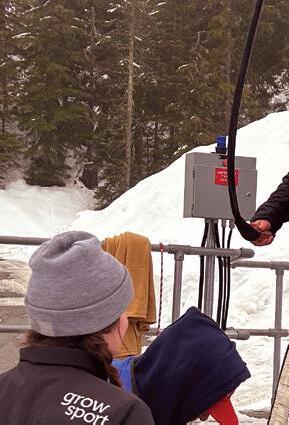















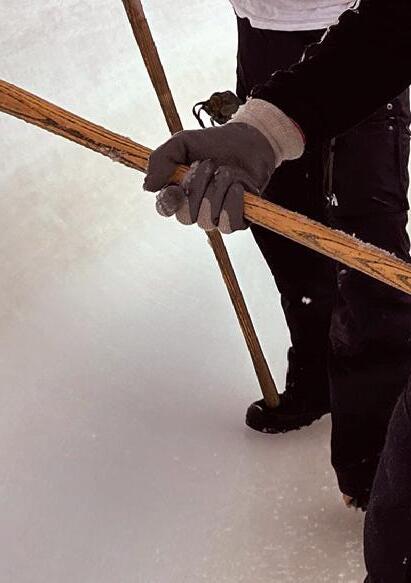


He’s not the only one who’s been witnessing it, either. WSC staff members ooze enthusiasm for the racers they support.



“Recently, I had a couple of athletes take their first runs from the very top of the track,” Spring said. “Every time they progress to a new start height, it’s a big milestone… and when they got to the bottom, the cheers from the track crew and the medics and from everyone there? That’s the community the Whistler Sliding Centre has.”

Track work can feel thankless at times. Days are short, cold and dark through the heart of winter, and World Cup athletes can scarcely afford to pay staff members much attention when medals are at stake. Nonetheless, WSC personnel find gratification within themselves to operate one of the best sliding facilities on Earth.
Their efforts do not, and have never, gone unappreciated.

“We get to see all the tracks in the world, pretty much, and nothing really compares to the work that’s done here in Whistler, and all the people that are just caring about it so much,” said Pembertonian Trinity Ellis, a member of Luge Canada’s national “A” team.



“The track crew and medics are all so personable. They know all of our names, and they know some of our stories,” added Ellis’ teammate Caitlin Nash, a Whistlerite and one of the first women’s doubles medallists in Canadian history. “Especially within such a small sport, it’s really cool that we get to experience that sense of community with these people, because nobody’s making them [show up to work].
“They do it out of the kindness of their own hearts, and because they love their jobs.”
‘EVERYBODY’S CHEERING’










With the track at WinSport Olympic Park in Calgary out of action since 2019, Whistler has become Canada’s lone hub for luge, skeleton and bobsleigh. The future development of Canadian sliding will likely be inseparably tied to the WSC. It’s no light burden, but one that the facility and its personnel are prepared to bear.

Indeed, by showing up each day with a positive attitude and a tradition of excellence, WSC coaches and staff have contributed to the Canadian sliding pipeline by helping to win over the parents of prospective athletes.

Stacey Spence is not your typical Sea to Sky mom. Three of her kids are sliders: her oldest son, Connor, drives bobsleds, her eldest daughter, Payton, is a skeleton racer and her youngest girl, Allie, competes in luge.



Why is Spence so comfortable with watching her children fly around at breakneck speeds? It has a lot to do with the people surrounding them.




“It just seems like everybody enjoys what they’re doing [at the WSC],” she said. “They’re great with the kids. It’s track workers, it’s coaches, everybody comes together. I can spend 14-hour days on track and say I had a great day.
“The kids have such a great rapport with the medics. They have secret handshakes, and they have high fives, and everybody’s cheering.”
Likewise, Karen Lara was impressed by the WSC’s commitment to professionalism. Her daughter, Tirza, was hooked on skeleton after day one—so much that she wanted to move to the Sea to Sky as a 16-year-old and jump start her career. Karen gave Tirza her blessing to do so, in large part because she trusted that her daughter would be safe.

“Having not come from a sliding sports background, I appreciated the progression approach that the WSC took,” explained Karen. “In other words, I felt more confident with Tirza’s ability to drive as she continually learned new skills and built run volume, starting at the lower corners and gradually moving up the track.
“The move to Whistler to train happened quite quickly, from Tirza trying out skeleton in January 2018 to living in Whistler full-time in June 2018. However, Tirza has always been an independent and self-motivated person, so she’s managed this really well.”



That’s an understatement. Tirza Lara is now part of the Bobsleigh Canada Skeleton (BCS) NextGen roster and showed her potential with a 14th-place result at her inaugural Junior World Championships.

Every slider in Canada wants to see the Calgary track back up and running, though that may or may not ever happen. Regardless, we are blessed to have the WSC: a community that embodies the ideals of becoming faster, higher and stronger—and doing it all together.
“When I was a kid, to be an Olympian seemed almost supernatural because it was such a great feat for any athlete to accomplish,” Spring remembers. “And I didn’t really get exposure to Olympic athletes or venues where I lived growing up.
“To have the Olympic spirit alive and well within the WSC can, I think, continue to inspire the next generation of athletes. That’s not just in the sports of bobsleigh, skeleton and luge, but in any Olympic sport.” ■
FEATURE STORY
MARCH 31, 2023 33
CLOCKWISE FROM TOP: Track crew supervisor Mike Lambert shows off a custom-made ice scraper as fellow crewman Rhys Bridge looks on. FOUR-TIME OLYMPIC BOBSLEDDER CHRIS SPRING reviews film as a coach during a late-January training session for developing athletes. THE INTERIOR OF THE CONTROL TOWER features an array of camera feeds and statistical software to help tower operators keep an eye on everything happening at the track. TRACK MEDICS USE LONG, multicoloured hooks and a crane to perform a sled arrest. TRACK MEDICS RIDE A BOBSLED down to level ground after halting its momentum. PHOTOS BY DAVID SONG
Amalia Pelchat of Whistler continues to build her burgeoning career
THE TEENAGE SNOWBOARDER WON THREE MEDALS AT THE CANADA WINTER GAMES
BY DAVID SONG
AMALIA PELCHAT first stepped onto a snowboard at three years of age. As the daughter of Whistler backcountry legend JF Pelchat—and the younger sister of Team Canada’s Juliette Pelchat—her early exposure to multiple sports was inevitable.
Nowadays, Amalia is 15 and putting her all-terrain aptitude on display.
The junior Pelchat locked up three medals in a standout performance for Team BC at the recent Canada Winter Games in P.E.I. Two gold medals came in her familiar disciplines of slopestyle and big air. The third, a bronze, was earned in snowboard cross—which Amalia does not normally train for.
“I was very surprised [to get on that podium],” she admitted. “But just by living in Whistler … you can become a strong athlete overall. I was like: you know what; I’m just going to try [boardercross]. Why not?”
After making the quarterfinals, she realized she had a chance to go all the way.
Amalia found herself trailing for much of the big final in Brookvale as more experienced contenders jumped out in front. Yet she kept at it, using her grasp of terrain and technique to build momentum. Eventually, the Whistlerite overtook Quebec’s Rose Savard-
Ferguson and joined her teammate Hannah Turkington on the podium—much to her own surprise and excitement.
Overall, Amalia is “over the moon” about her Canada Winter Games experience. She is proud to have represented not just herself, but her province and a sport she deeply loves. Competing for Team BC also generated a bevy of new friendships.
“There are many girls that I’ve met [in P.E.I] from all around Canada who were at the same contests as me, but I didn’t know them,” Amalia said. “But meeting all these
founded together.
Both are driven and competitive, with lofty aspirations in life, but neither allows those things to get in the way of family.
Amalia is no doubt gunning to match or exceed her sister’s considerable athletic feats.
Juliette has had a robust taste of FIS World Cup action, testing herself against Olympic and X Games medallists like Quebec’s Laurie Blouin and Reira Iwabuchi of Japan. Back on Dec. 10, 2022, the elder Pelchat got to be part of history: the first World Cup big air contest ever held in a stadium.
the Dirksen Derby, a banked slalom contest held from Dec. 16 to 18 in Oregon. Amalia bested her older sister on the weekend she turned 15, and remembers how supported she felt by Juliette that day.

“I know it must be hard, having your younger sister being a bit better than you in some things, but it’s just so incredible to see how she’s dealing with it, and she’s still so happy with me,” Amalia said.
“Whenever I win … [Juliette] is just always there to support me and be excited for me, even if she is feeling a bit sad sometimes.”
The Pelchats will forever be bonded by their love of board and backcountry. JF and his daughters still race together at times, and Mount Baker’s Legendary Banked Slalom is one of the family’s favourite events. Other key contests on Amalia’s radar include the FIS Park & Pipe Junior World Championship in Wanaka, New Zealand this August, and the 2024 Winter Youth Olympics in South Korea.
new girls and even guys that are just such strong athletes has made me better. These bonds, I’ll have forever.”
A REAL WILD SISTERHOOD
Another bond that Amalia will cherish for the rest of her life is the one she has with her sister, Juliette. The two have grown up on mountainsides and in skate parks together, and they continue to redefine the local skateboarding scene with the Real Wild Kittens (RWK) girls-only skateboard camp they
The pressure can cut both ways, too.
Juliette admits that Amalia has become a more capable skateboarder than her—not an easy realization about one’s younger sibling. For a brief time, this sapped Juliette’s drive to keep at it with skateboarding, but it never diminished the love they have for each other.
“We kind of feed off each other and we’ve learned how to ride with each other more … with the competitiveness—but in a good way, in a positive way,” Juliette said in a 2021 interview with Pique.
An example of that healthy dynamic was
Practicing multiple sports has taught Amalia fundamental skills that make her the all-around athlete she is today. It has also taught her the importance of supporting others.
“This year’s National Junior Championships in Calgary were difficult for me, because I fell on my runs [and finished fourth],” Amalia said. “Obviously, you want to spend time acknowledging what you just went through … but I had to put that aside for a bit and be excited for all of my friends who won, and who were just experiencing a really important part in their life.
“One of the big things I’ve had to learn was just to be excited for everyone around you, and always be positive.” n
PODIUM PURSUIT Whistler’s Amalia Pelchat won three medals at the 2023 Canada Winter Games in Prince Edward Island.
PHOTO BY ARMANDO TURA / COURTESY OF TEAM BC
“One of the big things I’ve had to learn was just to be excited for everyone around you, and always be positive.”
SPORTS THE SCORE 34 MARCH 31, 2023
- AMALIA PELCHAT
THE BEST DEALS OF THE SEASON

ON YOUR FAVORITE BRANDS



YOUR STORE
FIND
Who, who, who cooks for you?
WHEN IT COMES TO KITCHEN FARE, WHO’S THERE—MEN OR WOMEN?
IF YOU’VE EVER wandered in Sea to Sky forests, you might have heard someone call out, “Who-o-o, who-o-o, who cooks for yo-oo-u-u?” in an owlish way. No, they’re not some kind of weirdo looking for kitchen help, or doing a quick survey, like I did. They’re a birder trying to elicit a response from barred owls.
BY GLENDA BARTOSH
The first time I heard that call I was hiking Black Tusk at dusk with a good friend who was also a very good birder. It cracked me up, and I’ve used it often since, but this is the first time in print—it felt right for a column about the kitchen scene, given the issues still swirling around women’s roles. I mean, we first started questioning all that back in Suffragettes’ time, never mind the ’60s.
Sadly, women are still widely underrepresented in the public arena. Good to see gender parity on Whistler’s council, but only one third of our MPs in Ottawa are women. Female board members in the U.S. also constitute about a third; in Canada, it’s a pathetic 18 per cent.
In sports, there’s another twist. Terry
O’Reilly, in his CBC Radio show Under the Influence, recently featured a New Zealand ad agency, DDB. When they were pitching FIFA Women’s World Cup, DDB found so many biases and errors they had to act. For instance, which boxer has defended their title the most? The internet says Joe Louis, with 27 matches. But it’s really Regina Halmich, with 45. So DDB created a website, Correct the Internet for doing just that—correcting gender-based biases toward men, and making women more visible in sports whenever they get the short end of the stick online.
On the local kitchen scene, I’ve been wondering how it’s going in a place as seemingly progressive as Whistler. Are women still doing most of the traditional cooking? Or have we corrected that gender bias, too?
I know it’s not scientific, but last week I did a straw poll, emailing 58 people—half men, half women—connected to Whistler, around the question “who cooks for you?” Here’s what I learned.
First, it was pretty interesting who responded. Of all the replies I received, only one was from a man! What’s that about!? Maybe because he cooks 80 per cent of dinners?
Otherwise, based on my all-female cohort of respondents, there’s no doubt women are still doing most of the cooking.
Sure, there are variations around meal planning, grocery shopping and the actual cooking, and many men clean up. There were also quite a few 50/50 or 60/40 splits, especially in younger households, plus some pretty funny stories and circumstances.
(“Our general approach is, if the food used to move independently, he is responsible for
it. If it never moved independently, she is responsible for it—except for pancakes.”)
But bottom line: the majority of respondents may not be barefoot and pregnant, but they’re still in the kitchen way more than men—even when they work fulltime. And a surprising number cook nearly every meal.

“Ray and Pauline are old school... mostly because the kitchen is Pauline’s comfort zone …,” writes Pauline Wiebe, who does 95 per cent of the cooking. “I always say, if you like doing something, then do it. I love cooking, so I do it. And, there are always two choices for dinner: take it or leave it.”
Joan Richoz is also a 90-per-center. “Marcel only cooks when he has an audience!! Like raclette, fondue,” she writes, adding a real Marcel story: When he tried cooking a spicy pasta dish, to give Joan a break, he had no idea how much heat to add. “Our poor friend was crying, the food was so spicy! This eventually turned into a signature dish called, ‘Come on baby light my fire!’”
There were also some cool role reversals, like this one: “Our household has been “nontraditional” for years! My husband does most of the shopping, laundry and cooking at home,” writes Isabel Chung, former head chef at Whistler’s Fairmont Chateau, now at the Fairmont Orchid on Hawaii’s Kohala coast. “Truth is I could not be as successful as I have been without his support … He is a great cook, and was a Red Seal chef long before me.”
Stella Harvey, a novelist who started the Whistler Writers Festival, is the first to admit cooking is not in her genes, but she and hubby Dave have figured out a 50/50

split “because we’ve come to understand our individual strengths.
“When I tell [people] that Dave does all the cooking, he perks up (typically a man of few words), and says, ‘I’d starve if I didn’t cook,’” she writes. “That is likely very true. My idea of cooking is making good use of my cellphone, to call for delivery. Just saying.”
Sure, we’ve come a long way from the days when a man “did not even make his own cup of instant coffee.” But we’ve got a long way to go. So I was heartened that several respondents said their boys—and girls—are learning to cook. A few young men who graduated in Whistler in 2002 have even become professional chefs. And kids as young as five are at home in the kitchen.
At Plenty Wild organic farms in Pemberton, David Tanner has been cooking the lion’s share for years, but lately he and his partner Alyssa Belter have landed on a true 50/50 system. They note two things: At farmers’ markets, it’s roughly 25-per-cent men, 65-per-cent women, and 10-per-cent couples. And Felix, their five-year-old, is very happy in the kitchen, doing age-appropriate things (no knives!). “He likes to pretend he has a restaurant,” says Alyssa.
As for those barred owls, if you’re ever lucky enough to have one answer your call, be respectful, as with any wildlife. Keep your distance. And never feed it, despite asking who cooks for it.
Glenda Bartosh is an award-winning journalist who thanks Claire Ruddy at AWARE for her story idea about how solo dwellers handle meals. n
TEACH ’EM YOUNG David Tanner, of Plenty Wild Farms in Pemberton, whips up some carrot “noodles” with a spiralizer while son, Felix, supervises.
FORK IN THE ROAD
PHOTO BY ALYSSA BELTER
36 MARCH 31, 2023
MEADOW PARK SPORTS CENTRE SWIM • SKATE • SWEAT • SQUASH


OPEN DAILY: 6 a.m. to 9 p.m.
F FLEXIBLE REGISTRATION
Flex-reg’ classes have a separate fee and allow you to register for classes on the days that fit your schedule.


R REGISTERED FITNESS
Registered fitness classes have a separate fee and a defined start and end date. Pre-registration is required for the entire set of classes.


I INCLUDED FITNESS
These classes are included with your price of admission for no extra charge.

ARENA SCHEDULE
Please see whistler.ca/recreation for the daily arena hours or call 604-935- PLAY (7529)


POOL HOURS* MAR 31 APR 01 APR 02 APR 03 APR 04 APR 05 APR 06 FRIDAY SATURDAY SUNDAY MONDAY TUESDAY WEDNESDAY THURSDAY MAIN LAP POOL 6 a.m.- 3:45 p.m. & 6-8 p.m. 8 a.m.- 4 p.m. 8 a.m.- 4 p.m. 6 a.m.- 3:45 p.m. & 6-8 p.m. 7:45 a.m.- 8 p.m. 7:45 a.m.- 8 p.m. 6 a.m.- 3:45 p.m. & 6-8 p.m. LEISURE (KIDS) POOL 4-8 p.m. 9 a.m.- 4 p.m. 9 a.m.- 4 p.m. 9-11 a.m. & 4-8 p.m. 4-8 p.m. 4-8 p.m. 9-11 a.m. & 4-8 p.m. HOT SPOTS 6 a.m.- 8 p.m. 8 a.m.- 4 p.m. 8 a.m.- 4 p.m. 6 a.m.- 8 p.m. 6 a.m.- 8 p.m. 6 a.m.- 8 p.m. 6 a.m.- 8 p.m. *Schedule subject to change without notice whistler.ca/recreation | whistler.ca | 604-935-7529 @RMWhistler | @rmwhistler | @rmowhistler FITNESS CLASS SCHEDULE MAR 31 APR 01 APR 02 APR 03 APR 04 APR 05 APR 06 FRIDAY SATURDAY SUNDAY MONDAY TUESDAY WEDNESDAY THURSDAY I Kin Stretch 7:30-8:30 a.m. Elliot I Strong Glutes & Core 7:30-8:30 a.m. Liz I Mountain Ready 7:30-8:30 a.m. Steve I Strength & Mobility 7:30-8:30 a.m. Anna F Swim Fit 7:45-8:45 a.m. Marie-Anne F Swim Fit 7:30-8:30 a.m. Marie-Anne I Aqua Fit Deep 8:45-9:45 a.m. Marie-Anne I Functional Strength & Conditioning 9-10 a.m. Roos I Aqua Fit Shallow 8:45-9:45 a.m. Marie-Anne I Full Body HITT 9-10 a.m. Alex I Low Impact Strength 9-10 a.m. Diana I Yin & Yang Yoga 9-10 a.m. Heidi I Mountain Ready 9 -10 a.m Anna R Mom & Baby 2.0 12-1 p.m. Sara I Low Impact Strength 9-10 a.m. I Gentle Fit 1:30-2:30 p.m. Diana I Zumba 10:30-11:30 a.m. Susie R Mom & Baby 2.0 12-1 p.m. Sara I Gentle Fit 1:30-2:30 p.m. Diana I Girls Learn to Strength Train 3:45-4:45 p.m. Roos I TRX Mixer 5:15-6 p.m. Mel R Pilates 5:30-6:30 p.m. Erin I HIIT Express 5:15-6 p.m. Alex R Prenatal Fitness 5:30-6:30 p.m. Sara F Spin 6:15-7:15 p.m. Marie-Anne I Strong Glutes & Core 6:45-7:45 p.m. Jess F Spin 6:15-7:15 p.m. Alex F Bike Fit 6:45-7:45 p.m. Katrina I Power Play Bootcamp 6:15-7:15 p.m. Mel I Slow Flow Yoga 8-9 p.m. Laura I Zumba 6:30-7:30 p.m. Carmen I Mobility: Roll & Release 8-9 p.m. Sara
Anonymous Art Show transforms councillors, musicians, and dabblers into artists
THE ANNUAL ARTS WHISTLER FUNDRAISER KICKS OFF MARCH 31 WITH BUYING NIGHT SET FOR APRIL 14
BY ALYSSA NOEL
IT APPEARS WHISTLER has more budding artists in 2023 than ever before—at least judging by the number of pieces submitted to this year’s Anonymous Art Show.
Last year, Arts Whistler saw a recordbreaking number of submissions with 333, but “this year it was 404 pieces from 247 artists,” says Mo Douglas, executive director of Arts Whistler.
In fact, that’s more art than they can feasibly hang on the walls at The Gallery at the Maury Young Arts Centre for the exhibit and its electric “buying night” event.
Their solution: each artist was allowed to submit three pieces, so those who maxed out their allotment will see their selections curated down to two.
However, “there are surprises coming about what will happen with the final wave of work,” Douglas says. “We’re dealing with great challenges to have.”
The list of locals who submitted art this
year ranges from well-established artists to more than a few musicians and even a handful of Resort Municipality of Whistler councillors. (If you’re curious: artswhistler. com/anonymous-art-show-artists-2023.)
Part of the event’s charm is that the talent is kept under wraps until the pieces are purchased.
mingle with artists and peruse the work ahead of the buying night on Friday, April 14.

For the uninitiated: that event requires a $30 entrance ticket (with appetizers, live music, a silent auction and pop-up bar). If you want to buy art, you have to purchase a ticket to reserve your spot. The more
artswhistler.com/gallery_anonymous_2023) and selecting their top 10 or 12 so they know exactly what to choose when their turn comes.
If you’re unable to attend in-person, Arts Whistler will also offer a proxy to take your list.
“We were really trying to bring the colour back into it last year,” Douglas says of the first post-COVID-restrictions event. “There’s a giddy energy that comes from that.”
If you prefer a more laidback buying experience, after selections are done for the evening, the remaining art will also be on sale for $50 a piece (and will remain on sale throughout the rest of the show’s run).
“What a lot of people will say to me is, ‘I have to come back and focus beyond my initial choices,’” Douglas says. “It’s almost hard to comprehend them all.”
“It’s so fun,” Douglas says. “We know a lot of this art is coming from people who dabble, or may never have done anything, and it’s anonymous.”
The exhibit itself (which will feature decals of pieces once they’re purchased and removed) will run from Friday, March 31 until April 29. But there’s also a free, official event on April 5 from 6:30 to 9 p.m., where you can
expensive it is, the higher up your buying slot (it is a fundraiser for Arts Whistler, after all). The first, second and third spots—$500, $400, and $300, respectively—have already sold out. But there are still tickets for the four tiers below, which drop down to $50 (those are more than half sold out).
Most people at least spend some time perusing the images of the art online (at
Meanwhile, if you’re looking for an additional way to support Arts Whistler, some of the pieces from its new 40 More Years Silent Auction will be available for bidding at the event as well. (You can check out all the items up for grabs from now until April 14 at 32auctions.com/40moreyears.)
“Coming out of COVID, it’s harder [to secure funding],” Douglas says. “Some sources have dried up … The fundraising [aspect of Anonymous Art Show] is a wonderful end result, but the process has so much entertainment value and community building.” ■
UNDERCOVER ART The Anonymous Art Show’s popular buying night is April 14, but the exhibit itself opens on Friday, March 31.
PHOTO COURTESY OF ARTS WHISTLER
“It’s so fun. We know a lot of this art is coming from people who dabble, or may never have done anything...”
ARTS SCENE 38 MARCH 31, 2023
- MO DOUGLAS
Squamish author turns family story into Canadian art history
SHAWN HENSHALL CELEBRATES THE LIFE OF GREAT-GRANDFATHERIN-LAW—THE ARTIST, COMEDIAN AND ILLUSTRATOR, JACK MCLAREN—IN THE FORGOTTEN LEGEND
BY ALYSSA NOEL
ALMOST EXACTLY 17 years ago, Shawn Henshall walked into a friend’s Guelph home and was immediately entranced by the art on the wall.
While the paintings shared a passing resemblance to work by the Group of Seven, they also had a “distinctive, identifiable style of their own,” he wrote.
That friend wound up becoming his wife—and those paintings, created by her great grandfather, J. W. “Jack” McLaren, sent him on a quest for nearly 12 years.
“If you look at all of the artists that made a name for themselves in Canada, they heavily promoted themselves,” says Henshall, who has been based in Squamish for the last four years. “I don’t mean that in a negative way. Sometimes you have to do that to survive … But Jack McLaren refused to promote himself. He thought it was a negative thing to promote yourself.”
But because of that, the impact of his art, comedy, and illustrations is largely uncelebrated in Canada, despite their widespread reverberations.
Henshall recently marked the publication of his book, The Forgotten Legend: The Life Story of John Wilson McLaren O.S.A. (via Friesen Press), documenting those accomplishments and showcasing his work.

“It’s not quite a coffee-table book,” he says. “It is, in a way, but it’s a biography as well. I pictured a glossy-style book because it’s art and you want to show the art.”
It’s hard to condense all of McLaren’s accomplishments (backed up by hard-earned facts that Henshall gleaned from various libraries, archives, and galleries over the years), but the book starts with his time as a soldier on the frontlines of the First World War, where McLaren helped form the Princess Patricia’s Canadian Light Infantry Comedy Company, which entertained troops with comedy skits during the war—even performing for the King and Queen of England in London.
That later led to The Dumbells, a comedy troupe that toured Canada after the war and
SPUD VALLEY NORDICS
even made a Broadway debut in 1921.
“It was like uncovering a mystery,” Henshall says of the research process. “I’m standing here in my office looking at a shelf that is four-and-a-half-feet long, and on it, every book has a mention or something to do with Jack McLaren. I ordered books thinking I could find some juicy info and, in some of them, there was nothing. But others I got an angle. The detective work was fun.”
McLaren’s contributions to the art world, meanwhile, were deep and varied. He worked as a graphic artist for various firms in Toronto—pioneering the use of plasticine in advertising—and, eventually, was invited to join the city’s famed Arts and Letters Club. It was there he reconnected with some of the members of the Group of Seven.
Later, he was welcomed into the Ontario Society of Artists, the country’s longestrunning art society. He also delved into engraving linoleum, creating caricatures that gained him acclaim, and caught the eye of famous portrait photographer Yousuf Karsh.
“I absolutely loved discovering the relationship with Yousuf Karsh,” Henshall adds. “It was a two-way relationship.”

Karsh photographed McLaren, and also collected his linocuts.

McLaren contributed graphic art to publications like Esquire (there’s an interesting backstory involving Ernest Hemingway there, Henshall says), Chatelaine, and Maclean’s Magazine
While McLaren’s family knew some of his backstory, it was far from complete. (McLaren died in Goderich, Ont. in 1988.)
“It was a huge deal [to his family],” Henshall says of the book. “There were his diaries, written in foolscap in pencil, stuffed in a filing cabinet, but no one had seen them.”
Since the book was published during the height of the pandemic, Henshall has given several talks on it, including to the Arts and Letters Club and on CBC radio.
“I think the good news is he didn’t feel the need to be celebrated,” Henshall says.
The Forgotten Legend is available at Armchair Books in Whistler and the Little Bookshop in Squamish. Find more info at theforgottenlegend.ca. ■
Spud Valley Nordic Ski Association would like to thank the Village of Pemberton, the SLRD and the Pemberton &


District Initiative Fund Program
for the PVUS grant the we received for the 2022/2023 ski season which subsidized the registration fees for the Spud Valley kids who joined the Track Attack Corridor Race team as well as contributed to the race coach salary and covered the cost of race fees for all Spud Valley Nordics kids competing in events at various locations throughout the province

PHOTO SUBMITTED ARTS SCENE MARCH 31, 2023 39 ICBC & INJURY CLAIMS ■ Minor to catastrophic injur es ■ Car accidents ■ Wrongful death claims BUSINESS & PERSONAL LAW ■ Corporate and Commercia ■ Real Estate Deve opment ■ Buying/Se ling Property or Business ■ Wi ls & Estates ■ Fami y Law ■ Immigration Law 604 892 5254 301-37989 Cleveland Ave RACEANDCOMPANY COM FREE CONSULTATION ■ In person or by phone Does not apply to Fam y or mmigrat on Consu tat ons
STUFF OF LEGEND The Forgotten Legend, written by Squamish author Shawn Henshall, is available in Whistler at Armchair Books.
Pemberton Arts Council springs into fundraising
ARTS NEWS: LITERARY MAGAZINE SEEKS SUBMISSIONS; BETWEEN SHIFTS THEATRE STAGES NEW PRODUCTION; WE HEART LOCAL ART ISSUES CALLOUT
BY ALYSSA NOEL
THE PEMBERTON ARTS Council (PAC) is gearing up for a pair of fundraisers next month.

First up is the “Proudly Pemberton” enamel pin sale. Designed by local graphic designer (by way of Chile), Fredy Valencia, the one-inch pin packs in the iconic Mount Currie, along with sunflowers from the annual sunflower maze down Pemberton Meadows Road, with the aim of reflecting the organization’s tagline, “Art Lives Here.”
Pre-sales are open now for the $10 purchase—which will support PAC’s events and programs—with arrival set for April. Get them at pembertonartscouncil.com/store.
If you prefer your fundraisers with a few more hops, The Beer Farmers have you covered. Pairing up with PAC, the brewery has created the Pint for Pemberton, an Englishstyle pale ale that has a limited run both on tap and in four-packs.
The cans will feature art by Pemberton illustrator Aurora Moore with proceeds also going towards PAC.
The launch for that initiative is set for Sat., April 8. Families can come out to the farm from 1 to 4 p.m. for an Easter egg hunt (with hourly hunts on the schedule), face-painting, bunny-mask making, and “fairy hair.”
The cost is $5 per activity with no admission fee.
However, adults 19-plus can enjoy an evening of music from 7 to 9 p.m. with Ottawa folk group, Old Man Grant. Tickets are $50—
including a Proudly Pemberton pin—and the event is outdoors, so organizers encourage you to dress for the weather.
Tickets are available at pembertonartscouncil.com/event-5202840.


WWF LITERARY MAGAZINE SEEKS SUBMISSIONS
The Whistler Writers Festival is seeking submissions—flash fiction, non-fiction, poetry or visual art—for its literary magazine.
With the aim of showcasing emerging talent from Mount Currie to Horseshoe Bay, all accepted submissions will be presented at the October festival with authors receiving a ticket to the Literary Cabaret.

The deadline is May 1.
For a detailed list of guidelines and how to submit, head to whistlerwritersfest.com/ programs/sea-to-sky-literary-magazine.


Additional questions can be sent to submissions@whistlerwritersfest.com.
BETWEEN SHIFTS STAGES THREE TALL WOMEN
Squamish’s Between Shifts Theatre has a new production coming to the stage from March 29 to April 1 and April 5 to 8.
Three Tall Women, a two-act, Pulitzer Prize-winning play, about (you guessed it)
three women, one in her 90s, another in her 50s and a third in her 20s, stars Kathryn Daniels, Christine Gavin-Bartlett, and Alejandra Chavarria.
Directed by Carla Fuhre, the production takes place at the Eagle Eye Community Theatre and is aimed at an adult audience. Tickets are available at betweenshiftstheatre.com.
CALL FOR LOCAL ARTISTS
Arts Whistler is bringing back the We Heart Local Art exhibit, highlighting an eclectic mix of local talent, from Lions Bay to Lillooet.
As part of the show, running from June 6 to July 15, artists chosen will receive “an allocated wall space to showcase their creative style (kind of State of the Art-style for those who remember that exhibit from Ski and Snowboard Festivals of the past),” according to the Arts Whistler website. “Whether you are a professional or an emerging artist, we want you to apply!”
Submitted art can be any medium or theme, ranging from acrylic to photography or mixed media, but it must be original pieces that are for sale.
Submit your work before the April 27 deadline. For more on rules and the submission process, head to artswhistler. wufoo.com/forms/m1ugounx0ul2w7w/. ■
ARTS SCENE
PINWORTHY Part of the inspiration for the Pemberton Arts Council’s new “Proudly Pemberton” enamel pin fundraiser is the annual sunflower maze, located at The Beer Farmers and run by Laughing Crow Organics.
40 MARCH 31, 2023
Big
His
He
We wish him all the best in his new adventures! We love you Big! Come say goodbye to this legend on Friday March 31st from 5-10pm
PHOTO BY ALYSSA NOEL
We are saying goodbye to one of Whistler’s favourite bar tenders ‘Big’ Rich Poehlmann.
Rich was instrumental in opening Roland’s Pub in July
2008 and making it a locals favourite.
passion for football & baseball made Roland's a great place to watch spor ts.
is one of the friendliest people out there and we are going to miss him dearly!
PIQUE’S GUIDE TO LOCAL EVENTS & NIGHTLIFE

Here’s a quick look at some events happening in Whistler this week and beyond. FIND MORE LOCAL EVENT LISTINGS (and submit your own for free!) at piquenewsmagazine.com/local-events

EASTER BRUNCH BUFFET
Sunday, April 9th
Reservations Available from 7 am - 2 pm
$89 per adult
$29 per child (12 years old and under)
STITCHES IN THE STACKS
MAR31-APR.6
COMMUNITY
STITCHES IN THE STACKS: KNITTING NIGHT AT THE LIBRARY








Calling all knitters and crocheters! Join us at the library for Stitches in the Stacks, a “fibre arts” night. This group is free to attend, but you’ll need to bring your own supplies. Let’s curl up by the fire and make something beautiful together.
Please note: these meetings are not lessons, but they will have some yarn and needles available for beginners who would like to try some basic knitting! Drop-ins welcome, no registration required.
> April 6
> Whistler Public Library, Fireside Lounge, 7 to 8:30 p.m.




> Free
SPRING YOGA AT THE AUDAIN ART MUSEUM




Join registered yoga instructor, Amanda Drage, amidst the stunning architecture of the Audain Art Museum for a calming Hatha practice that will expose you to a variety of poses at an easygoing pace. The classes will emphasize breathing, alignment and ease as you stretch and strengthen your body and mind. Registration includes access to the museum galleries
on the day of the yoga session from 11 a.m. to 6 p.m. Bring your own mat and enjoy some mind and body wellness!

> April 6
> Audain Art Museum, 9:30 to 10:30 a.m.

> $5 for museum members, $20 non-members
ALTA LAKE BIRD WALK

Join the Whistler Naturalists on the first Saturday of the month for a walk to Rainbow Park from the bottom of Lorimer Rd. Open to anyone interested in learning about birds. There will be experienced birders on hand who are happy to share their knowledge while monitoring bird activity. More information at whistlernaturalists.ca/birding.



> April 1, 8 a.m.
> Meet at the bottom of Lorimer Rd. by the catholic church
> Free


SVAVA TERGESEN: ORNAMENTAL COOKERY
Ornamental Cookery by Vancouver-based, emerging artist Svava Tergesen, explores the symbolic potential of everyday objects. Tergesen’s work often starts as a sculpture or collage in which she employs foods and other household items to create intricate, surreal arrangements. Combining handicraft techniques such as cooking and textile art with photography, Tergesen’s practice explores the domestic sphere and the gender roles therein.
> April 1
> Audain Art Museum (special exhibit)













> $20
Prime rib, honey glazed ham and salmon carving
Eggs benny station
Charcuterie and seafood bar
Dessert buffet
Excellent vegan options
Easter egg hunt and activities for children
Learn more at www nitalakelodge com/theden | @thedenwhistler
ARTS SCENE
PHOTO BY BETSIE VAN DER MEER / GETTY IMAGES
MARCH 31, 2023 41
NEW WINTER WHISTLER MAGAZINE IS OUT! Get your new edition in hotel rooms and select locations around Whistler. WHISTLER’S PREMIER VISITOR MAGAZINE SINCE 1980 /whistlermagazine Get all the local headlines in your inbox every day! Scan the QR code to receive your daily newsletter.
have time for a 5 minute read?
miss a local story again
Only
Never
Questionable UFOs
BY ALLYN PRINGLE
WHEN PAUL AND JANE Burrows began printing the Whistler Question in their Alpine Meadows home in 1976, they created an incredible resource for researching happenings in Whistler. The Question reported all sorts of stories, which means that you never know what you’ll come across when scouring the archives. Recently, while looking into a story about a strata that passed a bylaw banning owners from having tourists or employees as tenants, one headline from Sept. 5, 1996 jumped out: “UFO hotline gets report of strange sighting in Whistler.” A few days later, while confirming the origin of a photograph from 1986, we came across another headline referring to UFOs in the issue from July 10.
It seems that in June 1986, Squamish RCMP had a higher-than-usual number of reported sightings of unknown objects in the sky around the area. It began with a report of what appeared to be a meteor crashing behind Blackcomb Mountain on the night of Thursday, June 12. Two men were driving on Highway 99 when they saw “a small, spherical fireball” moving quickly to the northeast before crashing into the ground. According to the men, the object “lit up the trees like the northern lights” then flickered out after a few seconds. While the incident was reported to the RCMP and then the Squamish Forest Service office and the Rescue Coordination Centre on Vancouver Island according to procedure, there were no follow-up explanations published.
Unlike the sighting on June 12, Squamish RCMP were able to give explanations for sightings reported towards the end of the month. On June 27, a number of Squamish residents reported an amber light rising above the Stawamus Chief. One resident, however, was able to get a good view of the light using
binoculars and described it as “a parachute device with three highway emergency flares attached.” A similar incident occurred a couple of days later over Garibaldi Highlands. Squamish RCMP concluded that both were probably pranks.


The last incident brought to the attention of Squamish RCMP in June 1986 came when a person walked into the detachment and described a UFO in the sky over Squamish. This one was cleared up quickly, according to Sgt. Lee Joubert, who reported that “We were directed to the object which was obviously a star.”

The RCMP were not the first stop for people who saw something strange in the sky by 1996; that summer a B.C. UFO hotline was set up, and people could call a number in Vancouver to report any mysterious sightings. This is what a Whistler resident named Haley did when she, her friend Simon and her roommates saw strange lights in the eastern sky. At least two other people also witnessed the lights and called the hotline to report them.
At the time, it was unusual for the hotline to get calls from outside of the Lower Mainland, and hotline coordinator David Pengilly was surprised to receive multiple calls from Whistler in one night. He thought at first that they might be looking at Venus, but was told that they could see Venus in the background of the light. According to Haley, the light would “hover for a while and then go zipping around, spiralling from side to side” and “was so bright it was strobing.” She and her friend watched it for quite a while, and then got her roommates up to see it as well. Like the supposed meteor in 1986, there was no follow-up story to explain this sighting.

We often get questions about various aspects of Whistler at the museum and, depending on the type of question, the Question can be a good place to start to find answers. Because of the scope of the paper, however, you never know what other information you’ll find along the way. n

MUSEUM MUSINGS
OUT OF THIS WORLD Attaching a few lights to this paraglider would probably have created a mystery for those watching from the valley below.
42 MARCH 31, 2023 April 9th, 12PM-4PM $110 including a glass of prosecco EASTER BRUNCH
Come be a part of our awesome team as The Squamish Chief ’s new Multi-Media Account Manager WE ARE HIRING Please submit your cover letter and resume in confidence to: Cathie Greenlees cgreenlees@squamishchief com Closing date is March 3, 2023
GEORGE BENJAMIN COLLECTION
TER B
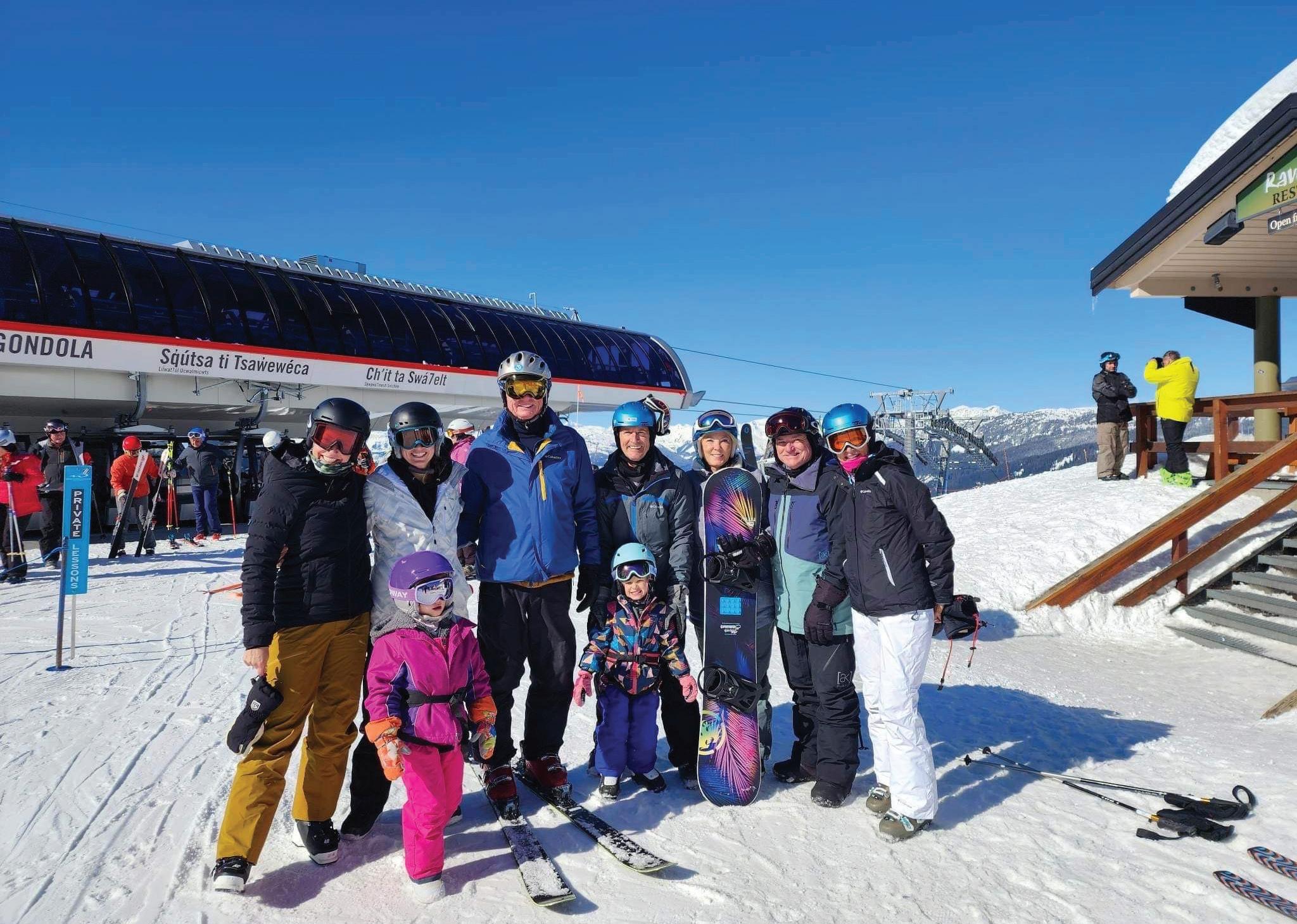










PARTIAL RECALL
SEND US YOUR PHOTOS! Send your recent snaps to arts@piquenewsmagazine.com 1 2 6 4 3 MARCH 31, 2023 43 OF THE WEEK LOUNGER S Stay Stinky! 21-4314 Main Street Go Sports! Monday - Friday 12pm-11pm Saturday and Sunday 11am-11pm Happy Birthday Jaqs Recycle? Yes or no? Get the BC RECYCLEPEDIA App www.rcbc.ca RECYCLING COUNCIL OF B.C. MEMBER
1 FAMILY AFFAIR Four generations of the Lee/Pasternak family, who grew up skiing in Whistler, enjoyed a March visit to the mountains. PHOTO SUBMITTED 2 SILVER SPRINGS Racing for Team Canada at the World Junior Championships in Passo San Pellegrino Italy last week, Whistler ski cross athletes Emeline Bennett and Nick Katrusiak won a silver medal in the team event. PHOTO SUBMITTED 3 PALESTINE Pique reporter Brandon Barrett joined Playground Builders founder Keith Reynolds, moderator Kirby Brown and a packed audience for “Peek into Palestine,” a talk at the Whistler Public Library on Wednesday, March 22 discussing Barrett’s and Reynolds’ 2022 travels to the region. PHOTO SUBMITTED 4 MAGIC MOOD Spring sun and mild temperatures made for a slushy ski-out under Blackcomb’s Magic Chair on Tuesday, March 28. PHOTO BY DAVID SONG 5 DOG DAYS Whistler pup Mud wanted to join the crew for a day of sledding this March—maybe next time. PHOTO SUBMITTED
Free Will Astrology
WEEK OF MARCH 31 BY ROB BREZSNY
ARIES (March 21-April 19): Sometimes, I give you suggestions that may, if you carry them out, jostle your routines and fluster your allies. But after trying out the new approaches for a short time, you may chicken out and revert to old habits. That’s understandable! It can be difficult to change your life. Here’s an example. What if I encourage you to cancel your appointments and wander out into the wilderness to discuss your dreams with the birds? And what if, during your adventure, you are flooded with exhilarating yearnings for freedom? And then you decide to divest yourself of desires that other people want you to have and instead revive and give boosts to desires that you want yourself to have? Will you actually follow through with brave practical actions that transform your relationship with your deepest longings?
TAURUS (April 20-May 20): You have done all you can for now to resolve and expunge stale, messy karma— some of which was left over from the old days and old ways. There may come a time in the future when you will have more cleansing to do, but you have now earned the right to be as free from your past and as free from your conditioning as you have ever been. APRIL FOOL! I lied. In fact, you still need to spend a bit more time resolving and expunging stale, messy karma. But you’re almost done!
GEMINI (May 21-June 20): Businessman Robert Bigelow hopes to eventually begin renting luxurious rooms in space. For $1.7 million per night, travellers will enjoy accommodations he provides on his orbiting hotel, 322 kilometres above the Earth’s surface. Are you interested? I bet more Geminis will be signing up for this exotic trip than any other sign. You’re likely to be the journeyers most excited by the prospect of sailing along at 27,000 kilometres per hour and witnessing 16 sunsets and sunrises every 24 hours. APRIL FOOL! In fact, you Geminis are quite capable of getting the extreme variety you crave and need right here on the planet’s surface. And during the coming weeks, you will be even more skilled than usual at doing just that.
CANCER (June 21-July 22): The coming weeks will be a favourable time for you to become the overlord of your own fiefdom, or seize control of a new territory and declare yourself chieftain, or overthrow the local hierarchy and install yourself as the sovereign ruler of all you survey. APRIL FOOL! I was metaphorically exaggerating a bit—but just a bit. I do in fact believe now is an excellent phase to increase your clout, boost your influence, and express your leadership. Be as kind as you can be, of course, but also be rousingly mighty and fervent.
LEO (July 23-Aug. 22): In his poem “The Something,” Charles Simic writes, “Here come my night thoughts on crutches, returning from studying the heavens. What they thought about stayed the same. Stayed immense and incomprehensible.” According to my analysis of the astrological omens, you Leos will have much the same experience in the coming weeks. So there’s no use in even hoping or trying to expand your vision. APRIL FOOL! I lied. The truth is, you will not have Simic’s experience. Just the opposite. When your night thoughts return from studying the heavens, they will be full of exuberant, inspiring energy. (And what exactly are “night thoughts”? They are bright insights you discover in the darkness.)
VIRGO (Aug. 23-Sept. 22): If there will ever come a time when you will find a gold bullion bar on the ground while strolling around town, it will be soon. Similarly, if you are destined to buy a winning $10 million lottery ticket or inherit a diamond mine in Botswana, that blessing will arrive soon. APRIL FOOL! I was exaggerating a bit. The truth is, I suspect you are now extra likely to attract new resources and benefits, though not on the scale of gold bullion, lottery winnings, and diamond mines.
LIBRA (Sept. 23-Oct. 22): Do you have a muse, Libra? In my opinion, all of us need and deserve at least one muse, even if we’re not creative artists. A muse can be a spirit or
hero or ally who inspires us, no matter what work and play we do. A muse may call our attention to important truths we are ignoring or point us in the direction of exciting future possibilities. According to my astrological analysis, you are now due for a muse upgrade. If you don’t have one, get one—or even more. If you already have a relationship with a muse, ask more from it. Nurture it. Take it to the next level.
SCORPIO (Oct. 23-Nov. 21): Dear Valued Employee: Our records show you haven’t used any vacation time over the past 100 years. As you may know, workers get three weeks of paid leave per year or else receive pay in lieu of time off. One added week is granted for every five years of service. So please, sometime soon, either take 9,400 days off work or notify our office, and your next paycheck will reflect payment of $8,277,432, including pay and interest for the past 1,200 months. APRIL FOOL! Everything I just said was an exaggeration. But there is a grain of truth in it. The coming weeks should bring you a nice surprise or two concerning your job.

SAGITTARIUS (Nov. 22-Dec. 21): Sagittarian poet and artist William Blake (1757–1827) was a hard-working visionary prophet with an extravagant imagination. His contemporaries considered him a freaky eccentric, though today we regard him as a genius. I invite you to enjoy your own personal version of a Blake-like phase in the coming weeks. It’s a perfect time to dynamically explore your idiosyncratic inclinations and creative potentials. Be bold, even brazen, as you celebrate what makes you unique. BUT WAIT! Although everything I just said is true, I must add a caveat: You don’t necessarily need to be a freaky eccentric to honor your deepest, most authentic truths and longings.
CAPRICORN (Dec. 22-Jan. 19): Some of my friends disapprove of cosmetic surgery. I remind them that many cultures throughout history have engaged in body modification. In parts of Africa and Borneo, for example, people stretch their ears. Some Balinese people get their teeth filed. Women of the Indigenous Kyan people in Thailand elongate their necks using brass coils. Anyway, Capricorn, this is my way of letting you know that the coming weeks would be a favourable time to change your body. APRIL FOOL! It’s not my place to advise you about whether and how to reshape your body. Instead, my job is to encourage you to deepen and refine how your mind understands and treats your body. And now is an excellent time to do that.
AQUARIUS (Jan. 20-Feb. 18): I invite you to make a big change. I believe it’s crucial if you hope to place yourself in maximum alignment with current cosmic rhythms. Here’s my idea: Start calling yourself by the name “Genius.” You could even use it instead of the first name you have used all these years. Tell everyone that from now on, they should address you as “Genius.” APRIL FOOL! I don’t really think you should make the switch to Genius. But I do believe you will be extra smart and ultra-wise in the coming weeks, so it wouldn’t be totally outrageous to refer to yourself as “Genius.”
PISCES (Feb. 19-March 20): Your body comprises 30 trillion human cells and 39 trillion microbial cells, including the bacteria that live within you. And in my astrological estimation, those 69 trillion life forms are vibrating in sweet harmony with all the money in the world. Amazing! Because of this remarkable alignment, you now have the potential to get richer quicker. Good economic luck is swirling in your vicinity. Brilliant financial intuitions are likely to well up in you. The Money God is far more amenable than usual to your prayers. APRIL FOOL! I was exaggerating a bit. But I do believe you now have extra ability to prime your cash flow.
Homework: What’s the best blessing you could give someone right now? Newsletter.FreeWillAstrology.com

In addition to this column, Rob Brezsny creates
In-depth
ASTROLOGY
EXPANDED AUDIO HOROSCOPES
weekly forecasts designed to inspire and uplift you. To buy access, phone 1-888-499-4425. Once you’ve
the Block of Time you like, call 1-888-682-8777 to hear Rob’s forecasts. www.freewillastrology.com
chosen
44 MARCH 31, 2023 Friends of the Whistler Public Library 50/50 RAFFLE 2023 Buy a Ticket to support the purchase of digital whiteboards for the upcoming small meeting rooms! Spread the Word to help us build a big jackpot! Scan the QR code to get started or visit tinyurl.com/mw4sps5x Tickets are available from February 13 to March 30 Draw at 2 p m on March 30 at the library! We’ve got you covered. Pick up the latest issue of your favourite read on stands and in hotel rooms throughout Whistler. VISITORS’ GUIDE 2017-2018 FRE






MARCH 31 , 2023 45 W H I ST L E R ’ S P R E M I E R V I S I TO R M AG A Z I N E S I N C E 1980 /whistlermagazine D O N ’ T M I S S O U T ! Booking Deadline is April 11, 2023 Call Catherine today to book your combined print and digital ad for Summer/Fall 2023. 604-932-1672 Planning your perfect Whistler wedding? PICK UP YOUR COPY TODAY!
RENT SELL HIRE



Accommodation SEEKING
Fairmont


Whistler Resort is growing its Housing portfolio and sourcing additional Chalet and Condo Rental contracts for our Hotel Team Members. Our leaders are mature, career driven drivers that know the word respect. Contract terms for property Owners are stress free with no commissions and includes representation from our 4 person fulltime Housing Department working with you 24/7; maintaining all aspects of the tenancy including quarterly inspections.

A great next move for Whistler property Owners that have tired with the Airbnb game or Property Fees. Let’s see if we can make a match and develop a long-term relationship here. General inquiries please email mark.munn@fairmont.com











RE-USE-IT CENTRE Donations daily
10 am to 4 pm
Accepting pre-loved clothing, gear and household items. Shopping daily




10 am to 6 pm 8000 Nesters Road 604-932-1121
RE-BUILD-IT CENTRE Donations daily
10 am to 5 pm
Accepting pre-loved furniture, tools and building supplies Shopping daily 10 am to 5 pm 1003 Lynham Road 604-932-1125 Visit
46 MARCH 31, 2023 Accommodation LONG-TERM RENTALS MULTIPLE LOCATIONS MOUNTAINCOUNTRY.CA Long Term Rental Management Victoria
SENIOR PROPERTY MANAGER E victoria@mountaincountry.ca T 604-932-0677 x4 PROPERTY EMERGENCIES: 604-932-0677 ANNUAL & SEASONAL For Whistler Property Owners 604-932-0677 info@mountancountry.ca
SEEKING
WANTED accommodationwanted Retiredteacherseeksquietsuite forskiseason,pkg,NS,NP,refs. psutkap@gmail.com.orcallPaulat 416-999-3831
Shilston
Accommodation
ACCOMMODATION
ACCOMMODATION WANTED
Chateau
MARKETPLACE
SALE - MISC
FOR
COMMUNITY LOVE
PRE-LOVED RE-LOVED =
mywcss.org and our social channels for updates. HOME SERVICES BUILDING AND RENOVATIONS • Kitchen and Bath • Renovations & Repairs • Drywall • Painting • Finishing • Minor Electrical & Plumbing Serving Whistler for over 25 years Wiebe Construction Services Ray Wiebe 604.935.2432
Wiebe 604.902.9300
DISPLAY ADS DEADLINE FOR PRINT ADS Tuesday 4pm
Classifieds Where locals look Î Secure & scamless Î Fully searchable Î Targeted online community Î Categorised listings Î No reposting Î Trusted by locals Î Make your listing stand out with featured locations CALL OR PLACE YOUR CLASSIFIED WITH OUR ONLINE SERVICE FOR EITHER PRINT OR ONLINE...OR BOTH! Get the added punch to make your business ad standout with a classified display ad. Free ad design, colour options, incentives for ad frequency. Contact a sales rep today. List your accommodation rental in print & online from only $5* a week Sell your stuff Advertising Options Î Packages start with 4 lines of text. Additional text $1/line Î Add one image in print and up to three online as per package level. Î Bolding .50¢/word Î Border $2 * Rates are based on using Pique’s selfserve online application at classifieds. piquenewsmagazine.com piquenewsmagazine.com 604-938-0202 online only Free* for 30 days print & online $11* per week PRINT & ONLINE SELF-SERVE CLASSIFIEDS.PIQUENEWSMAGAZINE.COM www.whistlerwag.com Looking to adopt? For an updated list of who is available, check out our website. Whistler’s premier visitor magazine is on stands now! Look for our Winter 2023 Issue! Find it on select stands and in Whistler hotel rooms.
Pat
raymondo99.69@gmail.com
Become
CAT LAKE SITE OPERATOR REQUEST FOR PROPOSAL
Recreation Sites and Trails BC is requesting proposals for a Site Operator for Cat Lake Recreation Site, located 10 minutes north of Squamish. The Site operator is responsible for the collection of camping fees, site maintenance and day to day operation of the recreation site from May 15th to September 15 yearly. The successful proponent will operate the site under a Partnership Agreement with the Province for a period of at least 5 years.
Cat Lake is heavily used in the summer months for overnight and day use. It has 4 day use areas with swimming docks, 48 walk in campsites and associated facilities around a 300 m. wide spring fed lake.
Please contact Alistair McCrone, Recreation Officer at Alistair.McCrone@gov.bc.ca to obtain a complete RFP information package or more information.

Deadline for the submission of proposals is April 16th, 2023 at 11:59 pm.


WHISTLER’S #1 NEWS SOURCE

PLAY HERE
Fridays – Kin Stretch 7:30-8:30 am w Elliot

Saturdays – Zumba
Mondays –TRX Mixer

pm w Mel
Tuesdays – Strength & Mobility 7:30-8:30 am w Anna


Wednesdays – Gentle Fit
1:30- 2:30 pm w Diana

Thursdays – Swim Fit
7:30-8:30 am with M-A
MARCH 31, 2023 47 HOME SERVICES BUILDING AND RENOVATIONS Located in Function Junction For Free consults and Quotes call 604-935-8825 mariomarble@shawbiz.ca Showroom #103-1010 Alpha Lake Rd.
FLOORING Open Monday through Friday 8:30 - 4:30 Saturday 10:00 -4:00 Sundays and Evenings by appointment only. 3-1365 Alpha Lake Road Whistler, B.C, V0N1B1 Phone 604-938-1126 email shawcarpet@shaw.ca Family owned & operated SHAW CARPET & FLOOR CENTRE MOVING AND STORAGE Call 604-902-MOVE www.alltimemoving.ca big or small we do it all! HOME SERVICES MOVING AND STORAGE NORTHLANDS STORAGE STORAGE SPACE AVAILABLE BEST PRICES IN WHISTLER FURNITURE, CARS, BOATS & MOTORCYCLES ETC STORAGE AVAILABLE 604.932.1968 ofce@northlandstorage.ca APPLIANCE REPAIRS LocallyOwnedandOperated -Residential/Commercialservices -Furnace,Fireplace,Boilerinstall/ service/maintenance
-HeatpumpsandA/C -In-floorheating -Domestichotwater -Snowmeltsystems
Services HEALTH & WELLBEING SPORTS & ACTIVITIES See our full page schedule ad in this issue of Pique for details Group Fitness Classes
Big Blowout SLATE TILE SALE
-HighlySkilledClassAGasFitting
-Commercialboilercontractor -Commercialkitchenequipment Email:phil@idealcombustion.ca Website:www.idealcombustion.ca
10:30-11:30 am w Susie
5:15-6
» piquenewsmagazine.com/jobs
Sign up at www.whistlerwag.com
a monthly donor today!
thingDifferent! workingwithourteamtomake yachtsshine,insideandoutsideexperiencenotrequired-enthusiasmis abilitytoworkatheights,inconfinedspaces,overthewater,in teamsorsolo,physicallydemanding,liftingofreasonableweight(50 lbs),communicatewellinEnglish, withbasiccomputerskills driver’slicense&PleasureCraft Operator’sCardassetsbutnot critical startingwage$22.00perhourwith benefitsafter3-months yachts@philbrooks.com https://philbrooks.com/














48 MARCH 31, 2023
EMPLOYMENT OPPORTUNITIES EMPLOYMENT OPPORTUNITIES FullTime
FOR SALE
Asking $5,000 Canadian. Email Patrick at C21mcm@aol.com for details. Housekeepers Chefs Cooks Massage Practitioner Groundskeeper Email us at careers@tyax.com or scan the QR code below Enjoy accommodation with a view & a balanced, outdoor loving lifestyle. Work away this summer! SoundGardenLandscape &DesignLtd. NOWHIRING-ApplyNow TEAMLEADER-Min2yrsexp. $30/hr+ContractFulfillmentBonus TEAMMEMBERS-Exp.Preferred $23/hr+$16DailyBonus PaidStatutoryHolidays WeeklyPayroll RecruitmentBonus EarnExtrawithPaidOvertime info@asoundgarden.com www.asoundgarden.com 604-905-9008 AN OFFICIAL PUBLICATION OF THE 2022-2023 PEMBERTON GUIDE on stands now! 2023 TheultimateguidetoSeatoSkyweddings 2023 Whistler’s only dedicated wedding magazine. AVAILABLE ON STANDS IN THE SEA TO SKY OUT NOW!
EMPLOYMENT EMPLOYMENT
SouthVancouverIsland-Some-
MARCH TIMESHARE
Westin Whistler time share week #13, one bedroom unit #907. For 2024 the week begins 3/30 and is the 13th Saturday every year thereafter.
Roland’s Pub is looking for an Assistant Kitchen Manager.






Position is full time, year-round. Starting salary is $52,000 + tips, staff meals, and other perks.


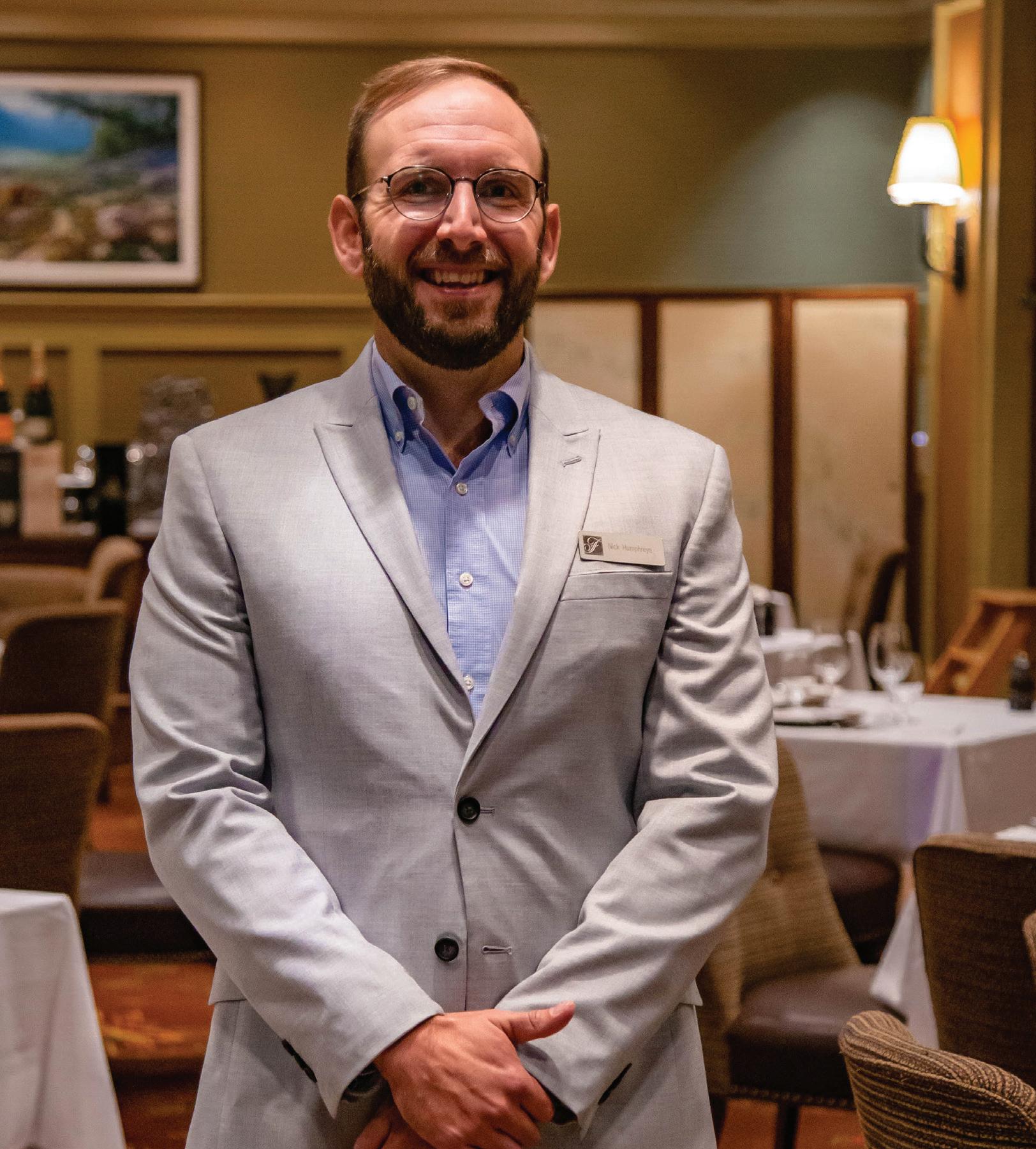
Extended Medical and Dental, ski pass, golf pass, and staff discounts at Roland’s Pub & Red Door Bistro. Must have line cooking experience, food safety certification, and some management experience is beneficial. Duties will include cooking on the hotline, assisting with ordering & receiving of food products, creating specials and new menu items, organizing freezers & fridges, and ensuring kitchen staff are properly stocked and prepared for busy lunch & dinner rushes. Temporary staff housing is available. Please email resume to info@rolandswhistler.com or apply in person at 2129 Lake Placid Road in Whistler’s Creekside.

MARCH 31, 2023 49
Whistler’s only dedicated wedding magazine. AVAILABLE ON STANDS IN THE SEA TO SKY The ultimate guide to Sea to Sky weddings 2023
The Mallard Lounge is hiring an http://bit.ly/3YSxxOM YOUR EXPERIENCE & SKILLS: WHAT YOU WILL BE DOING: WHAT IS IN IT FOR YOU: HOW TO APPLY: • Minimum 2 years food & beverage leadership experience • University/College degree in related discipline an asset • Thorough knowledge of wines, liqueurs and other beverages • Sommelier designation an asset • Ability to work well under pressure in a fast paced environment • Assist in positioning the Mallard Lounge as one of the top dining choices in Whistler • Have full knowledge of all restaurant and bar menus • Create unforgettable experiences for our guests and colleagues • Assist in achieving financial goals through revenue maximization and managing expenses • Competitive Benefits • Career Growth Opportunities • Extensive Travel Perks APPLY HERE
Assistant Food & Beverage Manager
We’ve got a job
you’ll
love.












50 MARCH 31, 2023 JOIN OUR TEAM We are currently hiring for the following positions Project Manager Site Supervisor Project Coordinator Labourer Send your resume to connect@peakventures.ca PLAY HERE » piquenewsmagazine.com/jobs Director of Banquets We are hiring http://bit.ly/3IUCi3R YOUR EXPERIENCE & SKILLS: WHAT YOU WILL BE DOING: WHAT IS IN IT FOR YOU: HOW TO APPLY: • Previous food & beverage leadership experience required • University/College degree in related discipline an asset • Ability to work well under pressure in a fast paced environment • Computer literate in Microsoft applications • Strong interpersonal and problem solving abilities • Manage all activities related to the Banquets Department • Attend pre-conference meetings with clients to confirm all relevant details are confirmed • Create unforgettable experiences for our guests and colleagues • Ensure all financial reporting is maintained and accurate • Competitive Benefits • Career Growth Opportunities • Extensive Travel Perks APPLY HERE We’ve got a job you’ll love. • ROOM ATTENDANTS • HOUSEMAN Please reply by email: parmstrong@pinnaclehotels.ca The Pinnacle Hotel Whistler has the following positions available:
Become part of a creative team and surround yourself with art.






The Museum is currently seeking:









Visitor Services Associate




















































Permanent, Part-Time $23 per hour


Responsibilities include:









































































































• Providing friendly and helpful customer service to guests




• Following opening and closing procedures






























• Selling admission tickets, memberships, and Shop merchandise

MARCH 31, 2023 51 whistlerdental.com/ liz@whistlerdental.co APPLY TODAY: Registered Dental Hygienist Certified Dental Assistant Amazing opportunities available: LOVE WHERE YOU WORK! JOIN OUR TEAM OF DEDICATED PROFESSIONALS Competitive Wages | Hiring Bonus | Relocation Bonus We've Got You Covered VISITORS’ GUIDE 2017-2018 FRE FIRST NATIONS USING TO ECONOMIC GROWTH COMMUNITIES COLLABORATION MARCH 10, 2023 ISSUE 30.10 WWW.PIQUENEWSMAGAZINE.COM HOW A GROUP OF FIVE LOWER MAINLAND SCHOOLTEACHERS BROKE CONVENTION AND CHANGED THE SHAPE OF WHISTLER FREE FROM WORRIES OCTOBER 20, 2022 ISSUE 29.42 WWW.PIQUENEWSMAGAZINE.COM ALPINE EXIT? WB open ‘compromise’ with Whistler Meadows 14 PARK-USE PERMITS fees for user groups aim address capacity, safety 18 FAMILY AFFAIR Jonah Waterous prep gallery reception Whistler 50 ? FEBRUARY 16, 2023 ISSUE 30.07 WWW.PIQUENEWSMAGAZINE.COM FREE THE CATS OCTOBER 27, 2022 ISSUE 29.43 WWW.PIQUENEWSMAGAZINE.COM GLACIAL PACE New WB staff 16 ICE BREAKER Whistler 40 PEAKTOVALLEYRACE BLACKCOMB THIS MONTH AFTER A PANDEMIC HIATUS RETURNS TO WHISTLER ISSUE 30.08 WWW.PIQUENEWSMAGAZINE.COM ISSUE 29.45 WWW.PIQUENEWSMAGAZINE.COM FREE TO INDULGE DREAMS DASHED support 2030 Olympics 14 YOUR WORSHIP Whistler’s new mayor and council officially sworn 15 LITERARY LIFELINE and-rescue book offers lessons for 38 raise a glass Whistler Cornucopia returns for a monthlong celebration of food and drink NOVEMBER 3, 2022 ISSUE 29.44 WWW.PIQUENEWSMAGAZINE.COM O’Hara series Into the light WARNING SIGNS Signs report highlights challenges with affordability 14 SOCIAL TIES strengthen Whistler’s social 16 HIDDEN GEMS Duo champion unsung Whistler show 36 As tourism hotspot, increasingly relies on an ‘invisible’ population to function; the people locally ARMS �Seppo's Bagel Bowl Tokum Alley Bowl Burnt McConkey's Franz's Run Ego Bowl� Chunky's Choice Name? in a What’s The stories behind the weird and wonderful ski-run names found on Whistler’s mountains FREE YOUR SKI LEGS GRAND OPENING Whistler opens for skiing week 14 TAX TOOL Officials question timing new tax tool on heels Olympic bid nix 18 ROCK DOC New film life of music icon, Sainte-Marie 58 Tales of Whistler’s ultimate storyteller, Paul Burrows, by the players in his own stories Tales of Whistler’s ultimate storyteller, Paul Burrows, by the players in his own stories PAGES FROM HIS OWN PLAYBOOK RAY OF SUNSHINE SAR STATS Call volume third year 14 CHURCH GOER Whistler Community Church welcomes pastor 22 PARTY ON WSSF return after COVID 36 PAGES FROM HIS OWN PLAYBOOK PAGES FROM HIS OWN PLAYBOOK WWW.PIQUENEWSMAGAZINE.COM ISSUE 29.47 WWW.PIQUENEWSMAGAZINE.COM FREE HOT BEAN JUICE WHISTLER HOUSING Clothing optional, corporal punishment mandatory 14 LOCAL HEROES Lil’wat recount courageous mountainside rescue 28 SMOKE EATER Former Whistler 46 NOVEMBER 17, 2022 ISSUE 29.46 WWW.PIQUENEWSMAGAZINE.COM ISSUE 30.12 HOMING IN RMOW launching Whistler’s first long-term housing strategy 14 CITIZEN HISTORIAN Remembering Paul Burrows, Whistler’s first newsman 15 STEVE AND EVE Local author born-in-Whistler kids’ 40 AS BIRD A Whistler poet explores the beauty and mystique of bird feathers, which have sat at the centre of culture, art and mythology for centuries MARCH 17, 2023 ISSUE 30.11 WWW.PIQUENEWSMAGAZINE.COM Please send your cover letter and resume to: Sonya Lebovic, Museum Shop & Admissions Manager: slebovic@audainartmuseum.com
Mirae
Campbell Photography






52 MARCH 31, 2023 ARE YOU LOOKING FOR A NEW CAREER IN CONSTRUCTION? WANT TO COME AND WORK FOR A GREAT TEAM WITH LOTS OF ROOM FOR CAREER GROWTH? APPLY TO CONNECT@TMBUILDERS.CA STAFF ACCOMMODATION AVAILABLE, RETENTION BONUS, BENEFITS, FULL TIME WORK We’re Hiring! Labourers, Carpenters, Foreman, Project Managers » piquenewsmagazine.com/jobs PLAY HERE BEARFOOT BISTRO, Whistler’s premier fine dining restaurant is hiring. bearfootbistro.com/careers info@bearfootbistro.com 4121 Village Green - Adjacent to Listel Hotel • SOMMELIERS • BARTENDERS • FOOD EXPEDITORS • CHEFS DE PARTIE STAFF HOUSING AVAILABLE Industry leading wages, extended health & dental benefits, signing bonus, RRSP / TFSA matching, staff meals, staff discounts at our restaurant & hotel properties in Whistler and Vancouver. JOIN OUR TEAM! JOIN OUR TEAM! Apply to: jobs@pembertonvalleylodge.com Employment Opportunities: Part Time or Full Time Night Auditor Flexible Hours, Health Benefits, Casual Environment Resort Municipality of Whistler whistler.ca/careers Resort Municipality of Whistler Employment Opportunities · Lifeguard/Swim Instructor · Skate Host · Wastewater Treatment Plant Process Supervisor · Labourer I – Village Maintenance · Youth and Public Services Specialist · Legislative and Privacy Coordinator · Program Leader · Lifeguard/Swim Instructor · Solid Waste Technician · Accountant Resort Municipality of Whistler whistler.ca/careers Resort Municipality of Whistler Employment Opportunities · Lifeguard/Swim Instructor · Skate Host · Wastewater Treatment Plant Process Supervisor · Labourer I – Village Maintenance · Youth and Public Services Specialist · Legislative and Privacy Coordinator · Program Leader · Lifeguard/Swim Instructor · Solid Waste Technician · Accountant • Capital Projects Coordinator, Infrastructure Services • Custodial Guard • Engineering Technologist - Utilities Maintenance Planner • Engineering Technologist • Lifeguard/Swim Instructor • Records Digitization Assistant • Waste Operations Coordinator • Paid On Call Firefighter
IS HIRING
H e l p u s e n d y o u t h h o m e l e s s n e s s
Youth Case Worker
W e b e l i e v e t h a t e v e r y o n e d e s e r v e s a p l a c e t o c a l l h o m e Z e r o
C e i l i n g i s a s o c i a l s e r v i c e n o n - p r o f i t c o m m i t t e d t o e n d i n g y o u t h
h o m e l e s s n e s s W e p r o v i d e y o u n g a d u l t s w i t h h o u s i n g , s u p p o r t i v e e m p l o y m e n t p l a c e m e n t s , l a n d - b a s e d p r o g r a m m i n g , a n d i n d i v i d u a l i z e d s u p p o r t W e s t r i v e t o c r e a t e a n e n v i r o n m e n t i n w h i c h y o u n g p e o p l e h a v e a s e n s e o f b e l o n g i n g a n d a r e s u p p o r t e d t o h e a l a n d g r o w J o i n o u r t e a m o f e m p a t h e t i c , s t r e n g t h - b a s e d Y o u t h W o r k e r s to p r o v i d e w r a p a r o u n d , h o l i s t i c c a r e f o r y o u n g a d u l t s i n o u r W o r k 2
2 + y e a r s i n y o u t h w o r k o r r e l a t e d f i e l d
S o c i a l / y o u t h w o r k o r e q u i v a l e n t l i v e d e x p e r i e n c e
C a s e m a n a g e m e n t e x p e r i e n c e
T o a p p l y , s e n d a r e s u m e a n d c o v e r l e t t e r t o : i n f o @ z e r o c e i l i n g o r g D e a d l i n e : O p e n u n t i l f i l l e d
L i v e s u p p o r t i v e h o u s i n g a n d e m p l o y m e n t p r o g r a m R e q u i r e m e n t s : F o u r d a y w o r k w e e k $ 2 6 / h r s t a r t i n g w a g e , e x t e n d e d h e a l t h b e n e f i t s & R R S P m a t c h i n g W h i s t l e r B l a c k c o m b s e a s o n p a s s ( s u m m e r a n d w i n t e r ) T h r e e w e e k s o f p a i d v a c a t i o n a n d t e n p e r s o n a l d a y s
W e o f f e r c o m p e t i t i v e w a g e s a n d f u l l - t i m e s t a f f w h o p a s s p r o b a t i o n r e c e i v e : W e e n t h u s i a s t i c a l l y w e l c o m e a p p c a t o n s f r o m a l l q u a l i f i e d p e o p l e , i n c l u d i n g t h o s e w i t h l i v e d e x p e r i e n c e , r a c i a l i z e d p e o p l e , p e o p l e o f a l l s e x u a l o r i e n t a t i o n s , w o m e n a n d t r a n s * p e o p l e , I n d i g e n o u s p e o p l e s , t h o s e w i t h d i v e r s e a b t i e s , m e n t a i l l n e s s , a n d f r o m a l l s o c i a l s t r a t a
M o r e i n f o a t z e r o c e i l i n g o r g / j o i n - o u r - t e a m
HERE’S TO THE JOURNEY
SERVICE EXPRESS: Concierge Guest Service Manager
FOOD & BEVERAGE Junior Server Server F&B Supervisor
PEOPLE & CULTURE : Associate Housing Manager

WE OFFER:

• Subsidized Staff Housing
HOUSEKEEPING:
Room Attendant
House Attendant
Housekeeping Manager
Uniform Room Attendant Housekeeping Coordinator
CULINARY: Cook Steward Chef de Partie Demi Chef de Partie

• World Wide Hotel Discounts
• Complimentary Staff Meals
• Best Team in Town!
• Summer Incentive
LOSS PREVENTION:
Overnight Loss Prevention Officer
Loss Prevention Supervisor
ENGINEERING:
General Maintenance
Power Engineer Lead Engineer
Vacasa’s forward-thinking approach and industryleading technology help set us apart as the largest full-service vacation rental company in North America. We are seeking individuals with a passion for providing exceptional vacation experiences for our Owners and Guests.

We offer competitive wages and benefits: Travel allowance for Squamish/Pemberton-based employees OR Ski Pass/Activity allowance, Extended Medical, RRSP match, Fun & Safe Work Environment-Great Team, opportunities to grow and more.
**SIGNING BONUS** $1000 (FT)
Housekeeper (Cascade Lodge)
Night Auditor
Guest Service Agent
Maintenance Technician
Assistant Housekeeping Manager
Full Time all year round
Apply online today!
https://www.vacasa.com/careers/positions or email: paul.globisch@vacasa.com or call to find out more details at 604-698-0520
We thank all applicants for their interest but only those selected for an interview will be contacted.
WE ARE HIRING!
We have the following positions available to join our well established family practice: REGISTERED DENTAL HYGIENIST (FT OR PT). New grads welcome! DENTAL RECEPTIONIST (FT OR PT). Previous hospitality, customer service and/or medical receptioning experience is preferred.
COMPETITIVE WAGES BASED ON EXPERIENCE.
NO EVENINGS OR WEEKENDS! Great extended benefit package and uniform allowance (after 3 months of employment) & free parking!
We pride on being a supportive and positive work family while always providing honest, quality dental care for all our patients. We are locally owned and operated. Our staff are long term residents of Whistler, Pemberton & Squamish. Is this you too? If so, we want to hear from you!
Please send your resume and a little about yourself to: managercreeksidedentalwhistler@gmail.com.

MARCH 31, 2023 53








54 MARCH 31, 2023 Are you ready to join us? WE ARE HIRING NOW! The Pemberton&District Health Care Foundation is looking for a PartTime Coordinatorto facilitate ourCommunications Plan! info@pembertonhealthcarefoundation.org $25-$30/hr depending on experience 5-8 hours per week Contract to end September15th 2023 Applications accepted until April21st, 2023 Details: www.whistlerexcavations.com The Sea to Sky corridor’s top civil construction company. We are currently recruiting professionally minded people to join our team. Required: Commercial Transport or Heavy-Duty Technician *Competitive wages, extended health benefits & tool allowance (after 3 months) Please send resume to: Email: info@whistlerexcavations.com www.whistlerexcavations.com The Sea to Sky corridor’s top civil construction company. We are currently recruiting professionally minded people to join our team. Required: Commercial Transport or Heavy-Duty Technician. *Competitive wages, extended health benefits & tool allowance (after 3 months) Please send resume to: Email: info@whistlerexcavations.com HERE Grow. Contribute. Explore. Apply by scanning the QR code now Full-Time Zipline Tour Guides Get paid to Zipline! Training dates starting as early as April 7th Starting wage of $20/hour Ziptrek Ecotours is now hiring:
Lil’wat Nation Employment Opportunities

Please
our career page for more information: lilwat.ca/careers/career-opportunities-2/
Parents of New Grads: Is your new graduate mechanically minded and not going to school in September?
Black Tusk Fire and Security Inc. provides apprenticeships and a supportive learning environment through on-the-job training and a four-year Sprinkler Fitter Apprenticeship Program.

Overview
Black Tusk Fire & Security is one of BC’s most trusted fire safety and security providers, servicing the Sea to Sky region and the Lower Mainland. The Fire Sprinkler apprenticeship is a full-time, paid position, working Monday-Friday; based out of our office in Whistler to service customers within the Sea to Sky corridor.
Job Duties
• Install wet and dry sprinkler systems as per the NFPA and Building Code;
• Install fire sprinkler systems for residential and commercial applications;

• Service, inspect and repair wet and dry sprinkler systems;
• Service, inspect and repair backflow systems
Requirements
• Self-starter who takes initiative
• Mechanical aptitude and basic knowledge of hand tools
• Strong attention to detail


• Excellent communication skills
• Valid drivers’ license
• Must reside within the Sea to Sky corridor
• We offer competitive wages, extended medical/dental benefits and growth potential with paid education/training.
This is a great opportunity to get your foot in the door within the industry or advance your current work experience into a long-term career with a growing company. Please respond with your resume and current references.
We thank all applicants for their interest, but only those qualified will be contacted.

Starting wage: $18.00 per hour

SEND YOUR RESUME TO: hr@btfsi.com
109-1330 Alpha Lake Rd., Whistler, BC V0N 1B1
Whistler: 604.935.1140 | Squamish: 604.892.9793

Vancouver: 1.877.657.1140 | www.BTFSI.com

MARCH 31, 2023 55 Life & Leisure Program Extended Health Benefits Retirement Savings Program Free Staff Parking Free Staff Meals Education Reimbursement 50% Discount in our Food & Beverage outlets Go Hilton Team Member Travel Program (including Friends & Family Benefits) WE OFFER AMAZING EMPLOYEE PERKS & BENEFITS! FOOD & BEVERAGE Banquet Server Restaurant Host CULINARY Cooks Chef de Partie Dishwasher SALES Sales Coordinator HOUSEKEEPING Room Attendant House Attendant APPLY TODAY THROUGH OUR QR CODE! We are currently hiring for the following positions: Carpenters Apprentices Labourers For more information on all we have to offer, please visit www.evrfinehomes.com or send your resume to info@evr finehomes.com Ullus Community Center · Early Childhood Educator · Director of Community Programs · Director of Community Development · General Manager, Community Services · Finance Assistant · Family Enhancement Worker · Transition House Support Worker · Projects & GIS Manager Ts’zil Learning Center · Indigenous Advocate Supervisor · Indigenous Support Worker – Culture & Language · Receptionist Youth Centre · Administrative Assistant · Youth Program Coordinator · Youth Centre Coordinator Lil’wat Business Group · Forestry Summer Students · Junior Saw Labourer · Senior Saw Labourer
Benefits Pension Plan • Employee Assistance Program • Gym facility Extended Health Benefits • Professional Development
visit
Lifeguard 1 – Regular Part-Time (20-30 hours)
Utility Operator 2 - Wastewater Collections - Casual/ On-Call


Finance Coordinator - Regular Part-Time
Assistant Recreation Facility Maintenance Supervisor - Regular Full-Time
Occupational Health & Safety (OHS) Advisor - Regular Full-Time

Economic Development Coordinator – Casual/On-Call
Front Counter Clerk – Regular Full-Time

Labourer 2 – Regular Full-Time
Utility Operator 1 – Water Distribution – Regular Full-Time
Recreation Program Instructor 1 – Biking – Temporary Part-Time (4-19 hours) (2 Positions)
Recreation Program Instructor 1 – Biking – Casual/On-Call
(Multiple Positions)
Building Official – Casual/On-Call
Labourer 2 (Multiple Positions) – Temporary Full-Time
Economic Development Specialist – Regular Full-Time
Small Equipment Operator and Winter Truck Driver 3 – Regular Full-Time
General Manager of Community Planning and Sustainability – Regular Full-Time
Financial Services Specialist – Temporary Full-Time
squamish.ca/careers

56 MARCH 31, 2023 PLAY HERE » piquenewsmagazine.com/jobs FRONT OFFICE SUPERVISOR, OVERNIGHT CLEANER, MAINTENANCE, DIR-SALES&MARKETING, HUMAN RESOURCES MANAGER (18-months Maternity Coverage) WE'RE HIRING DELTA WHISTLER VILLAGE SUITES COMPETITIVE RATES & BENEFITS.GLOBAL DISCOUNTS.GLOBAL CAREER. Join the #1 Global Leader in Hospitality. Apply at Jobs.Marriott.com. Contact Barbara.Fraser@deltahotels.com for more information, or drop by and talk to us - we love to meet new people. DISTRICT OF SQUAMISH
WE ARE HIRING
Hiring – Dump Truck Driver
Corona Excavations Ltd is a civil based construction company with a professional and enjoyable working environment working in the sea to sky corridor from Pemberton to Squamish.
We are looking for an experienced dump truck driver to join our crew. We are offering full time hours from April 1st with competitive wages and benefits. You would be driving a 2018 Mack Tandem dump truck servicing our job sites in Whistler and Pemberton.
If you are interested or have any questions please call 604-966-4856 or email me with your CV at Dale@coronaexcavations.com
Hiring – Yard/Delivery Person
Corona Excavations Ltd is a civil based construction company with a professional and enjoyable working environment working in the sea to sky corridor from Pemberton to Squamish.

We are looking for a person to drive around small tools/ equipment and parts to sites as well as help maintain our yard. Any mechanical or equipment experience would be beneficial in the growth of the role. We will provide a work vehicle and the potential for development within the company.
If you are interested or have any questions please call 604-966-4856 or email me with your CV at Dale@coronaexcavations.com.
Hiring – Ground Staff
Corona Excavations Ltd is a civil based construction company with a professional and enjoyable working environment working in the sea to sky corridor from Pemberton to Squamish. We are looking for ground staff to work for the upcoming construction season. Experience with operating, pipelaying and landscaping are beneficial. We are offering full-time hours with wages and benefits dependant on experience.
If you are interested or have any questions please call 604-966-4856 or email me with your CV at Dale@coronaexcavations.com.
is now hiring for Guest Service Agent
This dynamic role include the following Perks and Benefits:
• Extended Benefits
• $20 per hour, plus Commissions
• $500 signing bonus
• Discounted F&B and Hotel Stays
• Development for Supervisory Positions
• Seasonal Bonuses of up to $1000 Staff Accommodation Available
Please reply with a cover letter and resume to hr@listelhotel.com
Thank you for your interest. Only those applicants being considered for an interview will be contacted.
Come be a part of our awesome team as The Squamish Chief’s new Media Account Manager.
YOU




If you don’t already live in Squamish, you should know it’s one of the most innovative and attractive communities on the West Coast just a short commute from the North Shore of Vancouver. It has a growing worldwide reputation for outdoor recreation with world-class mountain biking, rock climbing, water sports and skiing, boarding and the backcountry in the winter. We’re youthful, engaged and passionate about where we live!
And if you’re a local – well, you know you’re in the right place to forge a career and lucky to call Squamish home.
We’ve got an opportunity to work and truly be a part of this inspired community at its media hub, The Squamish Chief. We’re part of Glacier Media Group and Local News Network, the largest local digital network in Canada. We work with our clients to offer cutting edge solutions like programmatic, Social, SEO, sponsored content and community display advertising on our website – and yes, we reach customers through our trusted newspaper as well. We’ve got media opportunities covered.
Here’s what we’re looking for:
• You have sales experience and are comfortable making cold calls and setting up/ leading meetings with new and existing clients.

• A self-starter with a consultative selling approach working with clients planning both digital and print advertising campaigns.
• Building and maintaining client relationships with your exceptional communication skills comes easy to you.
• You are a goal orientated individual with a positive attitude and a willingness to learn.
• You possess strong organizational skills and have the ability to multitask in a fast paced environment.
Here’s the essentials of what we offer:
• Competitive salary + uncapped commission package.


• Comprehensive health and dental coverage and extended benefits.
• Extensive onboarding training and ongoing support.



Come join us!
Please submit your cover letter and resume in confidence to:
Cathie Greenlees cgreenlees@squamishchief.com
Closing date: Open until filled
MARCH 31, 2023 57
ARE
A SELF-MOTIVATED INDIVIDUAL LOOKING TO GROW YOUR CAREER IN SQUAMISH?
We offer:
• Extended Health and Dental benefits for you and your family
• 20cm snow rule & mental-health bike days


• Flexible schedule & awesome staff parties!
•
58 MARCH 31, 2023
VISION PACIFIC CONTRACTING LTD. is hiring new team members: EXPERIENCED CARPENTERS LABOURERS
Work-life balance is as important to us as it is to you!
in
Home Builder www.vispacific.com PLAY HERE » piquenewsmagazine.com/jobs
Send your resume to info@vispacific.com 30 Years
Business Whistler’s Award-Winning Custom
" T h e h o t t a b l e t o b o o k t h i s s e a s o n i s n e w s u s t a i n a b l e s e a f o o d s p o t W i l d B l u e R e s t a u r a n t + B a r "C
WE OFFER:
w : w i l d b l u e r e s t a u r a n t c o m / c a r e e r s e : c a r e e r s @ w i l d b l u e r e s t a u r a n t c o m



ACCOUNTANT, WHISTLER.COM

Full Time, Year Round
The Whistler.com Accountant is responsible for assisting with the day-today operation of the Finance department and all aspects of accounting policy and procedure related to the operational departments within Whistler.com.
We’re looking for community-loving, mountain-appreciating, environmentrespecting people to join our team. Our ideal candidate has experience in fullcycle accounting and is a collaborative team player with excellent interpersonal and organizational abilities. Come collaborate with us.
What we offer: a flexible schedule offering work-life balance, a commitment to health & wellness, competitive compensation and benefits package, and a great team environment.

We’re also recruiting for: Maintenance Technician/Cleaner, Visitor Centre Agent.
TO VIEW OUR CAREER OPPORTUNITIES, AND TO APPLY, VISIT US ONLINE AT: WHISTLER.COM/CAREERS.
YOUTH OPPORTUNITIES –CANADA SUMMER JOBS
Full Time, Summer Contract
Canada Summer Jobs is a program under the Youth Employment and Skills Strategy, which aims to provide flexible and holistic services to help all young Canadians develop the skills and gain paid work experience to successfully transition into the labour market.
Tourism Whistler has applied to participate in the Canada Summer Jobs Program, and if program funding is approved, will hire for the following opportunities:
• Finance Assistant
• Marketing Assistant
• Human Resources Assistant
• Web & Operations Assistant
Results of application funding will be confirmed in April. As a requirement of the Canada Summer Jobs Program, these positions are available to youth up to 30 years of age, who are Canadian Citizens or Permanent Residents of Canada.
TO VIEW OUR CAREER OPPORTUNITIES, AND TO APPLY, VISIT US ONLINE AT: WHISTLER.COM/CAREERS.




MARCH 31, 2023 59
Answers #21825461973 473259168 619378245 781945326 562813794 394627851 238594617 947186532 156732489 #22 #22 56189 9486 56 7182 27 1437 94215 872964153 563718294 941532876 239856741 716349582 485271369 124685937 398427615 657193428 #23 HARD#23 5421 25 391725 96 5473 174 1 698573124 371642589 542918367 265489731 439167258 187235946 926851473 813724695 754396812 #24 HARD#24 76 837 2315 87 465 95 6812 491 28 715924683 483516279 296783154 859372461 321465897 674891325 968147532 547238916 132659748 www.sPage6of25 udoku.com4/11/2005 We've Got You Covered VISITORS’ GUIDE 2017-2018 FRE W O R K W I T H U S OPEN FOH POSITIONS LEAD HOST FINE DINING SERVER SERVER ASSISTANT OPEN BOH POSITIONS EXPERIENCED LINE COOKS PASTRY COOKS KITCHEN STEWARDS S T A F F A C C O M M O D A T I O N G U A R A N T E E D U P O N H I R I N G W I T H I M M E D I A T E S T A R T D A T E C O M P E T I T I V E W A G E S + G R A T U I T I E S E X T E N D E D M E D I C A L + D E N T A L B E N E F I T S U N P A R A L L E L E D S T A F F A M E N I T I E S
W O R K W I T H O N E O F C A N A D A ' S T O P C H E F S A N D M E N T O R S , A L E X C H E N , I N A K I T C H E N E N V I R O N M E N T S T R I V I N G F O R G R O W T H , E D U C A T I O N A N D R E S P E C T
O N
A S
T R A V
E
D É N
T
E L
R















CALL THE EXPERTS Want to advertise your service on this page? Call Pique at (604) 938-0202, or email sales@piquenewsmagazine.com 60 MARCH 31 , 2023 DOUG BUSH SURVEY SERVICES LTD DOUGLAS J BUSH AScT, RSIS p: 604-932-3314 c: 604-935-9515 Engineering & construction layout Topographic & site improvement surveys Municipal, volumetric & hydrographic surveys GPS - global positioning systems www.dbss.ca // dougb@dbss.ca SURVEYING AUTO GLASS SPECIALISTS Frameless Shower Enclosures Complete Window/Door Packages · Custom Railing Glass Systems Fogged/Failed Window Replacements mountainglass.ca | info@mountainglass.ca 604-932-7288 THE COMPLETE GLASS CENTRE GLASS Residential/Commercial Heat Pumps Boilers-Furnaces-Chillers Design Build Call us today! 778-994-3159 www.westerntechnical.net Western Technical System Inc HVAC/R HEATING AND COOLING Offering unparalleled products and services to our community since 1964 Let one of our qualified paint consultants help brighten your life with new selections of Benjamin Moore coatings. 604 894 6240 | 7426 Prospect Street PAINT BLACKCOMB CHIMNEY PATROL LTD. Serving Whistler since 1986 Specialized in cleaning Chimneys, Furnace & Airducts, Dryer vents. 604.932.1388 / 1.877.932.5775 blackcombchimney@yahoo.ca CHIMNEY BLACK BEAR CARPET CLEANING LTD. www.blackbearcarpetcleaning.ca • 604 698 6610 100% ECO FRIENDLY CERTIFIED • Carpets • Upholstery • Tiles • Car Interiors • Furnace • Airducts • Dryer vents CARPET CLEANING www.summersnow.ca Summer Snow Finishings Limited WIND OW COVERINGS Whistler’s Source forBlinds since1989 David Weldon david@summersnow.ca 604-938-3521 •Wood blinds •Sunscreens •Shades •Motorization BLINDS ETC. A professional and personalised cleaning service offering residential, construction and commercial cleaning in Whistler and Pemberton areas. NOW HIRING rhys@buffcleaningwhistler.com • 604-902-9983 CLEANING Coast Mountain Cleaning •Full service cleaning• Residential &Commercial •Carpet &UpholsteryCleaning •Property Maintenance •Established 2011 We follow allVCH, Min of Health andWHO Covid 19 protocols Insured &Bondable •Criminal background checks on all staff 604-966-1437 coastmountaincleaning@gmail.com We use teatreeoil based cleaning products. CLEANING Tel: 604-935-2101 Email: windowcov@shaw.ca www.whistlerwindowcoverings.ca Custom Blinds • Shades • Draperies Connie Griffiths BLINDS ETC. SUNCREST WINDOW COVERINGS • BLINDS • SHADES • SHUTTERS • DRAPERY Custom Window Treatments Contact us today for a free quote or consultation info@suncrestwindowcoverings.com 604.698.8406 BLINDS ETC. Full Service Plumbing & Heating northridgemechanical.ca 604-262-6801 RESIDENTIAL INDUSTRIAL COMMERICAL STRATA PLUMBING AND HEATING 604-815-4545 • www.avesta1.com KEEP IT LOCAL PROPERTY MANAGEMENT LONG TERM RENTALS BOUQUE STYLE STRATA MANAGEMENT Info@avesta1.com Call for a free consultation PROPERTY MANAGEMENT WANT TO ADVERTISE your service here? Call Pique at (604) 938-0202 , or email sales@piquenewsmagazine.com
ACROSS
DOWN
LAST WEEKS’ ANSWERS





PUZZLES
Strode along 6 MP quarry 10 Wet 15 Football or tennis 20 Urgent 21 It may be airtight 22 Rock ‘n’ roll classic 23 Underground worker 24 Fling 25 School kid 26 Stretches across 27 Link up 28 Golf bag item 29 Disgrace 31 Italian wine city 33 Witty remark 35 Mouths, in zoology 36 Short distance 38 Tall vases 39 Silo companion 40 Clean -- -- whistle 41 Granny or square 42 Christmas visitor 44 Came afterward 46 Deep distress 48 Dangerous bear 51 Honor 53 Encroached 58 Guitar, slangily (var.) 59 Finish a dress 61 Damage the nish 62 Smooths feathers 63 Traveler’s guide 65 Costa -67 Unpaid factory worker 69 Sell moonshine 71 Square of glass 72 Vote to accept 74 Complain incessantly 75 Messenger 76 Jumps about 77 Like some hillsides 79 Board member 80 Rainbow color 81 Memorial Day race 82 Intoned 83 Solemn promise 84 Library shelves 87 Happier 88 Become serene (2 wds.) 92 Prohibitions (hyph.) 93 Spoke slowly 94 Physics unit 95 Old photo color 96 Rolling -- -- (rich) 97 Algae 98 Daffodil or tulip 100 Kind of board 101 Young Cratchit 102 Perfectly clear 103 Computer key 104 Apprehend a suspect 106 Allow 107 Montreal puckster 109 Pekoe packet (2 wds.) 112 Elegant 114 Friend in Paris, perhaps 115 Harshly 117 Strong devotion 119 Pitfall 122 Fox competitor 125 Norwegian name 126 Not busy 127 Splash out 131 L-o-n-g time 132 Fairy-tale giant 133 Huge containers 134 Fridge maker 136 Search engine nd 137 Microwaved 139 Kept the engine running 141 Seraglio 143 “Thank you,” in Grenoble 145 Gawked at 146 Steel plow inventor 147 Unseals 148 Joyous outburst 149 Is malodorous 150 Rewrites 151 Compass reading 152 Foamy
1
1 Persists 2 Sonnet stanza 3 Use a blender 4 Bastille Day season 5 Grass droplets 6 Most Vassar grads 7 Uses a paper towel 8 “Shogun” apparel 9 Dogpatch resident (2 wds.) 10 Speaker’s platform 11 Of high mountains 12 Mountain overlooking Troy 13 Shogun’s warrior 14 “Oui” and “da” 15 Chimney deposit 16 Brooch 17 Pungent vegetable 18 Of an earlier style 19 Foot the bill 21 Not together 30 Squat down 32 Return env. 34 Woodworking chore 37 Air-pump meas. 41 Small cask 43 Sigh of content 44 French political division 45 Smudged 47 Switch positions 48 Jeweler’s unit 49 Nitrous -- (laughing gas) 50 Furnishings 52 Air pollution 54 Free-for-all 55 Nobleman 56 Internet note 57 Italian poet 60 Lettuce 62 Railroad employee 64 Bug spray victim 66 Fuzzy fruit 68 Awful 69 Leaped 70 Sent packing 71 Trudged 73 Propane holders 75 Bassinet 76 Companies 78 Bank offerings 79 Defrosted 80 Remote abbr. 82 Scratching 83 Prairie schooner 84 Fit of pique 85 Old-fashioned remedy 86 Jung’s inner self 87 Purple color 88 -- -Magnon 89 Translucent gems 90 Sends a telegram 91 -- Bumppo 93 Half, in combos 94 Napoleon’s island 97 Cedar shakes 98 Overindulge 99 Infuriate 102 On the -103 Daytime TV program (2 wds.) 105 Sis’s sib 108 Take a snooze 109 Diatribes 110 Give off heat 111 Skirt or blouse 113 Sounds of hesitation 116 Fall back 118 Paper measures 119 It’s above baritone 120 Roulette wheel color 121 Shin neighbor 123 Bouquet bearer 124 Granted 126 Ticket prices 128 Enticed 129 Ocean predators 130 Roman naturalist 132 Track postings 135 Roadie gear 138 Reaction to a mouse 140 Flower adornment 142 Tarzan friend 144 -- Claire, Wisc.
Solution, tips and computer program at www.sudoku.com ANSWERS ON PAGE 59 Enter a digit from 1 through 9 in each cell, in such a way that: • Each horizontal row contains each digit exactly once • Each vertical column contains each digit exactly once • Each 3x3 box contains each digit exactly once Solving a sudoku puzzle does not require any mathematics; simple logic suf ces. LEVEL OF DIFFICULTY: HARD HARD#21 251 46 784 19 52174 78 359 42 748 HARD#22 56189 9486 56 7182 27 1437 94215 MARCH 31, 2023 61
The Fourth Dimension—Part II

“In the long run, we are all dead.”
-John Maynard Keynes
THE IMPORTANT thing, the thing Keynes went on to build his version of economics on, is what we do until our long run comes to an end. Born out of the economic and social devastation of the Great Depression—a crash he laid at the feet of unbridled, free-market capitalism—Keynes’ macroeconomic model hung its hat on a form of liberal capitalism
BY G.D. MAXWELL
that envisioned a regulated market economy with coordination between governments and central banks manipulating fiscal and monetary policy to smooth out the wild swings of free markets chasing a balance between supply and demand.
Have I put you to sleep yet?
While Keynesian thought held sway in most western democracies after the Great Depression and through the post Second World War boom, a competing school of thought, the Chicago School, built momentum beginning in the mid 1950s. Reduced to a far too simplistic explanation, the Chicago School believed markets, left to their “rational” expectations, could do no wrong. Profit good; regulation bad. Reganomics. Thatcherism. Mulroony.
So what in the world does any of that have to do with Whistler’s current housing issues?
There was a moment of realization, in 1974, that Whistler wouldn’t be well-served by allowing land owners to develop whatever they wanted, wherever they wanted, whenever they wanted. The development freeze that was mandated by the province provided a breather during which those charged with planning for Whistler’s development would have a chance to think about how and how fast the town evolved.
As Jim Moodie—part of the management team along with Doug Sutcliffe and Neil Griggs who put together the first development plan for the town centre—reminded me last week, those key ingredients still seen in the Village, things like the grocery store, hardware store, book store and others, were all identified and planned as integral to a well-rounded, wellfunctioning town.
This was no cowboy development, where buildings were going to be built with no plan for how they were going to be used. “It was considered a really communist, total-control sort of concept,” Moodie quipped.
But a combination of brutal interest rates, a government bailout that included development rights to what would become Village North, the development of Blackcomb, snowboarding breathing life into what was considered a sunset industry, and a robust rebound accelerated development of Whistler. In record time. Far faster than the early planners expected, the town grew from an interesting regional ski hill to a nascent
world class resort.
That growth set the stage for what’s happening now.
From then on, what had been a tough housing market slowly developed into an impossible housing market. Impossible in the sense that, like so much of the rest of the world’s enchanting places to live, Whistler’s growing pool of residents—people lured here by a luxurious lifestyle accompanied by service-sector wages—can no longer afford to live here absent non-market housing alternatives or an unlikely lottery win.
retreats. Few were purchased by local residents. Many were purchased by investors. Most were bulldozed. Virtually none were rebuilt with suites.
Whistler has been bleeding market rentals, largely suites, at a pace far exceeding the construction of resident-restricted employee housing, which is to say rental and ownership properties managed by the Whistler Housing Authority (WHA). Foreseeable? Probably.

Adding to that loss has been the Olympic™ legacy. In the buildup to the Olympics™, two fronts on the affordable housing war
threw a wrench into the plans of quite a few landlords in town who woke up in the post-Olympic™ hangover to find their tenants were either gone or refusing to pay the outrageous rents they’d been paying. I vividly remember one of them accosting the then-head of WHA, one day when he and I were skiing, and accusing him of ruining his comfortable income stream using language no editor of Pique would ever let me repeat in print.
What followed was a few years when the annual survey of employers in town reported to WHA they weren’t having any issues finding employees who already had housing. For a brief period, it was harder for newbies in town to find jobs rather than housing!
The upshot of that was a number of years where virtually no new housing was added to the employee housing stock, a lull, in retrospect, that looks increasingly like a missed opportunity.
Early skiers, largely from the Lower Mainland, built fairly simple homes here. Many had suites local workerbees lived in. This provided some security for the homeowners who were absent mid-week, as well as financial help paying a second-home mortgage.
It was entirely foreseeable—at least to anyone who had a grasp of the fourth dimension: time—there would come a time many of the weekend warriors would be lured to Whistler as a wonderful place to retire. Many did. Few continued to need or desire full-time residents in those suites. They disappeared as rec rooms, media rooms and suites for grown children of the owners.
Also foreseeable that skiers who didn’t retire to Whistler would sell their weekend
developed simultaneously—Rainbow and the Athletes’ Village. Rainbow was a plan brokered between developers and the Resort Municipality of Whistler to convert the tract previously housing a few commercial offices and the local paintball operation into a mix of restricted, market housing and commercial development. It began to come online around the time of the 2010 Games.
At the same time, the Athletes’ Village was transformed into Cheakamus Crossing and, in a stroke of genius and good planning, was also transformed into resident-restricted, employee housing. If you don’t think that was genius, look up what happened to the Athletes’ Village in Vancouver. It could have been so much worse.
The confluence of the two developments
Having wrestled 300 acres (121 hectares) in Cheakamus from the province, earmarked largely for resident housing, it seemed the town had ample employee housing and the luxury of time to plan and develop that legacy slowly. Oops.
When it became clear in the latter part of the last decade that was an illusion, when the market rental housing stock continued to bleed away and no new housing was being built, the machine was kickstarted again, and for half a decade when we enjoyed relatively low interest rates and ample supplies of building material and labour, new building took place in Cheakamus.
Then, as in the late 1970s, early 1980s, the unthinkable happened. An era of low, almost no, interest rates came to an end.
As has this instalment. What I hoped would be two parts is going to take three. My apologies. Next week, The Fourth Dimension—Part III. ■
MAXED OUT
In record time. Far faster than the early planners expected, the town grew from an interesting regional ski hill to a nascent world class resort.
62 MARCH 31, 2023
WHISTLER VILLAGE UNDER CONSTRUCTION IN THE SUMMER OF 1979. BECK COLLECTION / WHISTLER MUSEUM AND ARCHIVES
GLOBAL REACH, LOCAL KNOWLEDGE FOLLOW YOUR DREAM, HOME
WHISTLER VILLAGE
423 - 4295 Blackcomb Way Freehold full ownership Phase II property. This studio has a full kitchen, A/C, fireplace, queen size bed, and a Muffphy bed. Great revenue for investment. $215,000
Ruby Jiang
SOLD
BENCHLANDS
WHISTLER VILLAGE
329 - 4314 Main Street Beautifully updated, bright and spacious one-bedroom condo in the heart of Whistler Village. Selling fully furnished and turn key. The perfect investment property or unlimited owner use. $1,050,000

778-834-2002
Maddi MacDonald
604-313-2029
WHISTLER VILLAGE
702 & 704 4050 Whistler Way Hilton Owners enjoy unlimited stays and a central village location offering all the amenities of a resort hotel. This lock-off 2 bed, 2 bathroom, with storage may also be rented nightly though the Hilton full-service, rental management program. $949,000

Nick Swinburne prec* 604-932-8899
3 - 4894 Painted Cliff Road Mountain Star 3 is your private and peaceful slopeside retreat on Blackcomb. Ski access, a private hot tub, a ski locker and secure underground parking offer ultimate Whistler conveniences plus strong revenue opportunities with a Phase One rental covenant. $2,499,000

Katherine Currall
604-966-1364
BENCHLANDS
4653 213 G2 & G3 Blackcomb Way 2 weeks every 4 weeks in Horstman House on Blackcomb. This quiet 1 bedroom offers owners the perfect home away from home with the option for nightly rental managed by the front desk. Price is per share.


$219,900
Sam Surowy
604-902-9754
BRIO
3283 Arbutus Street Looking for an AMAZING INVESTMENT OR Whistler home with NO strata fees? Enjoy a private, large, fenced and bright back yard in this spacious 4 bed/3 bath duplex with mountain views. This property offers everything and is located a short walk to the Village. $2,099,000 Allyson Sutton prec* 604-932-7609
CREEKSIDE
4 – 2400 Cavendish Way WHISKI JACK Complex, near Creekside Gondola for skiing and summer mtn biking access. Cozy 2 bed, 1 bath townhouse just under 800 sq.ft. Enjoy this as your home or rental investment property. $950,000

Kathy White prec*
604-616-6933
CONTRIBUTION AT CLOSING
BLACK TUSK
73 Garibaldi Drive 73 Garibaldi Drive is a spacious 3,170 sq/ft home that is situated on a quiet 7,535 sq/ft lot within the quiet & serene Black Tusk development that is a short 15 minute drive to Whistler! $1,899,000

Maggi Thornhill prec* 604-905-8199
Engel & Völkers i s a proud c hampion of Special Olympics. Many o f our a dvisors donate a p or tion of t heir commissions to Special Olympics o n behalf o f their clients. This simple p rogram m eans t hat ever y time we help our c lients realize their real estate goals, we are helping a Special Olympian get j ust a bit closer to theirs.

Whistler Village Shop
36-4314 Main Street · Whistler BC V8E 1A8 · Phone +1 604-932-1875
whistler.evrealestate.com

SQUAMISH
40846 The Crescent This University Heights dream home captures stunning mountain and valley views. Modern and sleek design throughout, the primary bedroom is equipped with its own balcony and jaw-dropping ensuite bathroom. Close to epic mountain trails and more. $1,850,000

Angie Vazquez prec* 778-318-5900
Squamish Station Shop 150-1200 Hunter Place · Squamish BC V8B 0G8 · Phone +1 778-733-0611 squamish.evrealestate.com
*PERSONAL REAL ESTATE CORPORATION Each brokerage independently owned and operated. Engel & Völkers Whistler
NEW PRICE
NEW TO MARKET












P E M B E R T O N O F F I C E 1 4 1 1 P o r t a g e R o a d , P e m b e r t o n , B C V 0 N 2 L 1 6 0 4 8 9 4 6 6 1 6 o r To l l F r e e 1 8 8 8 6 8 9 0 0 7 0 W H I S T L E R O F F I C E 1 0 6 - 7 0 1 5 N e s t e r s R o a d , W h i s t l e r, B C V 8 E 0 X 1 6 0 4 9 3 2 2 3 0 0 o r To l l F r e e 1 8 8 8 6 8 9 0 0 7 0 * P E R S O N A L R E A L E S TAT E C O R P O R AT I O N r e m a x- w h i s t l e r. c o m Property Management remaxseatoskypm.com S a lly Wa rn er * 6 0 4 9 0 5 6 3 2 6 U rs u l a M o rel* 6 0 4 9 3 2 8 6 2 9 Alexi H a m il to n 6 0 4 9 3 5 07 5 7 #352 - 4899 Painted Cliff Road $819,000 Rare 2 Bedroom at the Blackcomb Springs Suites by Clique Spectacular, refurbished, lodge style fully equipped suite with private deck tucked away on Blackcomb Mountain This is the ultimate ski in ski out lodging! In the summer enjoy the proximity to top notch hiking and mountain bike trails or our world renowned ski slopes in the Winter 6500-Lot172 In-Shuck-Ch FSR $140,000 This charming vacation home is located with n the pristine wilderness of L llooet Lake, just north of Whistler Extensive improvements have been made on this 1/3 of an acre property that comes with a modern mobile cabin that can sleep up to seven Walk down to the commun ty beach where you can launch your boat or paddleboard during the summer S h err y B a ker * 6 0 4 9 3 2 1 3 1 5 Th eres a M cC a ff rey 6 0 4 9 0 2 1 70 0 #4415 - 4299 Blackcomb Way $999,900 This luxurious suite at the Pan Pacific Whistler Village Centre is a perfect mountain getaway A spacious open-concept living and dining area features a cozy gas fireplace and a fully-equipped kitchen for a home-away-from-home fee With 2 bedrooms and 2 bathrooms, this suite comfortably sleeps 6 #406G4 - 4653 Blackcomb Way $365,000 Fabulous two bedroom top floor quartershare located in Horstman House on Blackcomb Take advantage of this larger 2 bedroom floor plan and the quiet forest views This home features a ful y equipped kitchen with new stainless steel appliances gas fireplace 2 full bathrooms in suite laundry and comfortably sleeps 6 900 Erickson Road $2,290,000 Mid-century modern home with architectural updates 5 acres in the Pemberton Meadows with unobstructed views from majestic Mt Currie to the Pemberton Icefields A comfortable living environment with three bed two bath storage and a two-car garage natural light views from all rooms radiant hot water heat and a wood-burn ng stove B o b C a m e ro n 6 0 4 9 3 5 2 2 1 4 Dave S h a rp e 6 0 4 9 0 2 2 7 7 9 D e n ise B rown 6 0 4 9 0 2 2 0 3 3 K rist i M cM illin 7 7 8 8 9 9 8 9 9 2 #60 - 4355 Northlands Blvd. $1,798,000 This stunning two-bedroom, two-bathroom property offers the ultimate combination of lifestyle and income potential as it s zoned for nightly rentals while also offering un imited owner use Upon entering the unit you ll be immediately struck by the inviting l ving space featuring a cozy fireplace and a generous living area #20 - 4375 Northlands Blvd. $28,000 SPRING BREAK !!! WEEK 11 is a grrrreat ski week to own in a luxury 3 bedroom townhome on the edge of the village Valhalla which is located in quiet part of the village with great FREE bus service to the ski hi l With 1350 ft2 and a recent update that includes new appliances granite topped kitchen counter new carpet and furniture #350 - 4591 Blackcomb Way $849,900 This luxurious 1 bedroom 2 bathroom suite at the Four Seasons Resort Whistler Hotel is the perfect place to enjoy a ski vacation With 902 sq ft of living space you’ll have plenty of room to relax & enjoy the stunn ng mountain views Recently renovated to contemporary classic mountain lodge design 1710 River Run Place $2,599,000 1710 River Run Place is an expansive 8639 square foot lot in a coveted new neighbourhood less than fifteen minutes south of Wh stler Village The property sits on a quiet cul-de-sac surrounded by extensive trai networks picture-perfect mountain ranges and the stunning turquoise Cheakamus River D o u g Trel eave n 6 0 4 9 0 5 8 6 2 6 L a d d ie H a n n a m 6 0 4 6 0 3 76 7 2 #305/306 - 4591 Blackcomb Way $1,775,000 This luxurious 2 bedroom suite is an end unit featuring two spacious, ensuited master bedrooms Two private patios to enjoy a main living area with a pull-out sofa Enjoy the Four Seasons Resort Whistler including 9000 square foot spa outdoor pool health club in-house restaurant and lounge room service and sk conc erge 7306 Toni Sailer Lane $2,995,000 Welcome to this cute cabin & flat LOT, located in the popular White Gold neighbourhood on Toni Sailer Lane One street over from Fitzsimmons Road & Creek Listed below assessed value for 2023 This is one of the most popular residential areas in Whistler and is within walking distance to the ski hill and Whistler Village (10 minute walk) 1641 Airport Road $3,188,000 Over TEN ACRES with Stunning views - fabulous location - close to 5 beautiful golf courses, skiing on two great mountains, and snowmobiling adventures galore! The opportunity is ready for a Legacy Family Home with Hobby Farm or some creative development Opportunity to build a legacy home and 10 cabins for Agrotourism A n n Ch ia s so n 6 0 4 9 3 2 76 5 1 2 2 1 2 5 2 2 3 Video - rem ax/60northstar 3D Tour - rem.ax/352springs Video - rem.ax/900ericksonrd Video - rem.ax/1710riverrun 3D Tour - rem.ax/350fs 3D Tour - rem ax/305fourseasons 2 3



























































































































































































































































 BY BRANDON BARRETT
BY BRANDON BARRETT






















 BY ROBERT WISLA
BY ROBERT WISLA











 BY BRANDON BARRETT
BY BRANDON BARRETT




























































































































 BY DAVID SUZUKI
BY DAVID SUZUKI



































































































































































































































































































































































































































































